| |||||||
| Search Forums |
| Advanced Search |
| Go to Page... |
 |
| Search this Thread |  27,095 views |
| | #1 |
| Senior - BHPian Join Date: Apr 2010 Location: EU - Nordic
Posts: 2,094
Thanked: 3,209 Times
| Volkswagen ID.4 GTX Business | Ownership Report Our VW ID.4 GTX Business was delivered in March 2023. The car is on a 3-year lease.  Background:The 3-year lease on our previous car, the Skoda Karoq, was ending in July 2021. 2021? Yes, be warned, this one's going to be a long story. And this story doesn't begin in 2021. It begins much earlier. If you are not in the mood for a long story, you can skip ahead using these links: Exterior Interior(Front) Interior(Rear) and Boot Infotainment and Driver's Console Features Living with the GTX, Likes and Dislikes Now, back to the story. In late 2018, a few months after I got the Karoq, my company's car leasing policy was updated to favour BEV/PHEV over ICE cars. My usage pattern (pre-Covid) perfectly matched the PHEV use case, with daily running of about 30-35km. When I chose the Karoq, most available PHEVs were expensive cars. I didn't consider any of them due to budget constraints. I hoped that the shift in policy would also show its effect on the leasing costs of BEV/PHEV vs ICE. I was quite sure that my next car will be a PHEV and kept an eye on the leasing rates as more PHEVs were getting launched. Thus, long before the lease was set to expire, I had a list of options to choose from. Requirements:In one sentence - I wanted a PHEV crossover/SUV that matched Karoq in size/space and features (safety and others). This wasn't such a simple requirement, the Karoq was quite feature rich. But among the features, I was ready to sacrifice some creature comforts if needed. For me, Karoq had set a high benchmark. I didn't really need to replace it after the initial 3-year lease as I could extend the lease for up to another 2 years. However, getting a new car is always an exciting prospect. With the lease, I pay only the leasing cost and fuel costs. So in terms of costs per month, I calculated that a PHEV would approximately cost the same as the Karoq, as the potential higher leasing cost for a PHEV will be largely, if not completely, offset by savings on diesel costs. The First Candidate List:In the summer of 2020, a friend was looking for a new lease car and started test drives. This triggered me to list down all my options as well. My list was: 1. Ford Kuga PHEV Titanium-X or ST-Line-X: + Closely matched my one-sentence requirement + Generally positive reviews - Other than the PHEV part, offered nothing special over the Karoq. I got a chance to ride in it when my friend took a test drive. I had nothing to complain about, but I wasn't particularly wowed either. 2. BMW X1 xDrive 25e: + AWD + Brand, of course! - 3-cylinder engine (but hey, even the i8 has a 3-cylinder engine) - Matching Karoq's feature list on the X1 meant really stretching my budget. So it was a question of which creature comforts I was prepared to leave out 3. Mercedes B250e PHEV: + More than 60km all-electric range (claimed) + Loved the interiors + Cheaper to lease among the premium options (including my preferred features) - A bit cramped - Not a crossover/SUV (but it still had a high seating position) 4. Volvo XC40 Recharge PHEV: + More creature comforts standard than X1 + Good-looking inside and out - 3-cylinder engine - All electric-range and FE on petrol were disappointing as per reviews - X1 and B250e seemed better value propositions. Just as premium as the Volvo, and offered other strengths as well I paid a visit to the Mercedes and BMW showrooms. In terms of space, the X1 won comfortably. In terms of interiors, the B250e won. Then Bjorn Nyland released this video: I hadn't given much thought to the charging part till then. Given the relatively small batteries in a PHEV, I had assumed that on a road trip I would be able to fast charge the battery during breaks and get that additional all-electric range. This turned out to be quite untrue. I started paying attention to the charging speeds. The Mercedes B250e had no competition here with 7.2kW AC and 22kW DC charging support. Others supported only 3.6kW AC charging. The second issue was charging at home. I had again assumed that I would be able to replenish a good part of the all-electric range quite fast each time I was parked. My parking spot already had an electrical connection to connect the engine heater. Upon checking with my parking maintenance company I was informed that it wasn't possible to charge EVs, but I could charge a PHEV. They also said the parking may be renovated in the near future and electrical points upgraded. But till such time, the maximum current was restricted to only 8A, which meant just 1.8kW for charging. My enthusiasm dampened quite a bit. This was in mid-August 2020. With a few months still to go before I had to order a new car, I decided to check my options at the end of the year. Another reason was the road trip we had towards the end of July 2020. The Karoq was very comfortable during the 4000+ km trip for me as the sole driver and also for the family. The family didn't think we should let go of the Karoq at the end of the lease. I partly agreed with them, but partly still wanted a new car. Re-evaluating options:In January 2021, the process to order a new car was triggered from the office. By then, Covid had changed things. I checked the possibility of extending the lease on the Karoq for 1 year. I was anyway working from home till the end of June 2021 and there was a high probability that remote working would be extended. So did it then make sense to go for a new car? However, the extension options did not turn out to be attractive. I visited the Ford showroom with my wife to check out the Kuga. The feeling we had was, "Yes, we could replace the Karoq with this, but don't really see why". I decided I didn't want to stretch my budget for X1. I test drove the B250e, after which it was rejected. The main reason was a feeling to lack of space, although on paper the B250e is longer overall and has longer wheelbase than the Karoq. The boot was anyway smaller in the B250e as in most PHEVs. I knew any other car would be a compromise in terms of the charging support, but I thought space was more important. Two new candidates then emerged: 1. VW Tiguan eHybrid Style: + Quite feature-loaded + Very attractive lease rate + No compromise in terms of interior space, minor compromise on boot space compared to the Karoq - Only 3.6kW AC charging - Two missing features - heated windshield and heated rear seats. But, thinking about it, the heated rear seat was one of the least used of the options I ordered in the Karoq. Heated windscreen, however, would be a big miss. We went to the VW showroom, but the Tiguan PHEV version was not yet available for TD. 2. Toyota RAV4 PHEV Active: + Pretty good feature list + Big battery and hence big all-electric range for an SUV + AWD + Overwhelmingly positive reviews, mainly from US and Canada (RAV4 Prime) + 6.6kW AC charging - Uninspiring interiors and pre-historic infotainment system - Price and hence leasing cost. The standard RAV4 Active PHEV was about €8k more expensive to buy than the Tiguan eHybrid Style + some options!! This was reflected in the leasing rates as well I visited the Toyota showroom to check out the car. The only real downside of the RAV4 was the leasing cost. I may have been tempted by Toyota's reliability if I was buying the car outright. For a lease, I wasn't ready to pay the Toyota tax and I decided to drop it. So then, it was going to be the Tiguan eHybrid Style. Probably. Unless, something didn't click during the test drive. Test drive for the Tiguan eHybrid was available only in March 2021. It was going to be a long wait. But after going to the showroom a couple of times to check out the non-PHEV versions of the facelifted Tiguan, I couldn't shake the feeling of familiarity with the Karoq on the inside. On one hand, this was good as there wasn't much to go wrong during the TD. On the other hand, I was wondering if I should just extend the lease on the Karoq. Last edited by StarrySky : 25th June 2023 at 11:17. |
| |  (15)
Thanks (15)
Thanks
|
| The following 15 BHPians Thank StarrySky for this useful post: | 14000rpm, CEF_Beasts, Chrome6Boy, dailydriver, digitalnirvana, Dr.AD, Gannu_1, graaja, GTO, GutsyGibbon, InControl, sanjayrozario, SKC-auto, thallipolivandi, vb-saan |
| |
| | #2 |
| Senior - BHPian Join Date: Apr 2010 Location: EU - Nordic
Posts: 2,094
Thanked: 3,209 Times
| The first real twist in the tale From PHEV to EV:I had read in the news at some point in 2020 that the government had announced some incentives for leasing BEVs as company cars. I hadn't paid any attention to this during my search. I hadn't considered BEVs since I was told that I couldn't charge them in my apartment parking spot. While I was waiting for the Tiguan test drive, I just checked the leasing costs for EVs. With the incentives provided by the government, the lease rates were reasonable. But without home charging, I thought ownership would be a pain. Then I remembered that the parking maintenance company had mentioned parking renovation back in August 2020. I contacted them to check if there was any progress. They responded that parking would indeed be renovated in the summer of 2021, and to my surprise they were considering installing 11kW chargers in a few parking spots. Of course, no final decisions were made yet and it would be confirmed only by early April or so. I had time until mid-May to order a new car, so this fit my timeline. Anyway, I immediately booked a place in the queue for an EV charging space. A charging place was now assured, assuming the renovation happened. Of course, I had to rethink my budget for an EV, but somehow I reached the "I want an EV" state of mind very quickly. When I pitched the idea to my family, my wife readily came on board. Or as she says, I ask her these questions only after having made the decision. The question is just for reassuring myself, and she thinks there is no use saying no at that point. Would an EV be practical as an only car? My impression was that Finland severely lacked fast charging infrastructure. But I discovered that there was pretty decent coverage using 50kW chargers, except in the northernmost parts. Faster chargers were coming up. I expected the situation to keep improving. Keep in mind that this was in early 2021. The situation has already improved. I went to ABRP (www.abetterrouteplanner.com) and planned several road trips within Finland. I found that using an EV did not add much extra time on most trips. I checked our actual travel time from day 1 of our July 2020 summer trip, where we covered about 850km and found that with an ID.4, we may have taken about 30 minutes more. It wasn't a huge compromise. For my normal use, I was sure that a modern EV could go about a week without charging. So range was not an issue for everyday use. Questions about some scenarios remained: * What if I needed to make an emergency trip and SOC was low? With 11kW home charging potentially available, I could always make sure I have at least 100-150km of range. * How would I reach some place 800-1000 km away as fast as possible? I would've been more worried if I was in India using an EV as the only car - simply because some relatives/friends live far away. This is not the situation for me in Finland, so I didn't consider this as a possible scenario. EV Options:In February 2021, cars from 10 different manufacturers were available through my company: BMW, Mercedes, VAG (Audi, VW, Skoda), Toyota, Nissan, Volvo, Ford and Kia. All except Toyota offered at least one EV. I checked the options available in my budget and very quickly zeroed in on the VW ID.4 as my first option. Here's how the options stacked up in my view: 1. VW ID.4: + Had almost everything I wanted + Attractive lease rates - Interiors - Complaints about SW 2. Skoda Enyaq iV 80: + Better looking interiors than ID.4 + Familiar controls at the wheel, having driven Skodas for 6 years + Some real buttons for some of the controls + Slightly more efficient (maybe?) + Slightly bigger - Leasing cost, value for money - Same issues with SW as ID.4 3. Mustang Mach-E: Only the standard range RWD version with 75kWh battery was within my lease budget. + Looks better (personal opinion) + Better power and torque + Slightly cheaper to lease - Lower WLTP range and inferior charging curve (charging speed nosedived after 80%) - making it inferior to ID.4 for longer trips - Skinnier tires There were other EVs also available, but they were either too expensive or too old in terms of EV tech (eg: e-Niro, Leaf). It was not known when Mach-E would be available in showrooms. This was a problem with Enyaq and ID.4 as well. Neither showroom had any cars on display. But I found that Skoda was doing a tour of Finland with the Enyaq and it would be available for a couple of days in the local showroom in the last week of February. The VW showroom told me that ID.4 would probably be on display during the first week of March. We checked out the Enyaq when it was on display at the showroom and the ID.4 a few days later. I have to admit that the Enyaq (with the optional EcoSuite interior) definitely felt upmarket and premium on the inside. However, the ID.4 was better VFM for me, as surprising as it was. I never thought a VW would be more VFM than a Skoda. Let me explain: Skoda Enyaq and VW ID.4 were polar opposites in terms of the different variants offered. Skoda offered only one base variant of the Enyaq iV80. Unsurprisingly, it wasn't a well-equipped car. But it was possible to add any other feature as an option. The ID.4 was offered in 5 variants (Life, Business, Family, Tech, Max), but with limited options. I was eyeing the ID.4 Tech variant. It came with most of the features I wanted, plus some good-to-have but not essential (for me) features like panoramic glass roof, electrically adjustable front seats with memory and massage function, HUD, LED matrix headlights and 360-degree camera. Although Enyaq was priced lower, I had to choose many optional packages to get it to the equipment level I wanted. Even 125kW charging was optional. It is understandable if they leave out some creature comforts, but higher charging speed optional on a supposedly long-range EV? With the features I wanted added as options, the Enyaq ended up being as expensive to lease as the ID.4 Tech variant. At the same leasing cost, those good-to-have features tilted the value proposition in favour of the ID.4. I booked test drives for both at the earliest possible dates. First look at the ID.4 in the flesh: 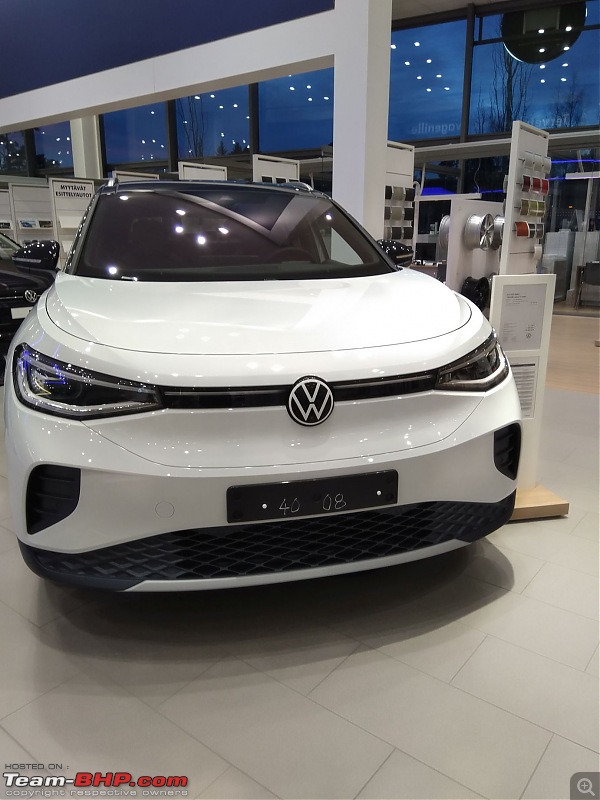 In between, I test drove the Tiguan. The family was OK with it, but not thrilled. I test drove it just because I needed a backup option in case the parking renovation did not happen. Test Drives:ID.4 TD #1: I got a 1-hour test drive of the ID.4 1st Max version. I really liked the car. The ride was comfortable. As luck would have it, it snowed on the day of the test drive, so I got to experience the RWD car in snowy conditions. On the whole, the handling was quite predictable and safe. Regen is incorporated into the manual braking action in the ID.4. The switch between regen and friction braking was imperceptible to me. The seats were comfortable. HUD was nice. The plastics could (or rather, should) have been better in a car costing more than €50k, but I could live with that. In short, I was quite happy with the driving experience. Only my wife was with me during the test drive. She was also impressed with the ride, NVH and overall comfort levels. The ID.4 1st Max had DCC (dynamic chassis control). EVs normally have a slightly harsher ride, and the Tech variant I was interested in did not have DCC. It could not be added as an option either. So I booked a second test drive of the ID.4 for a variant without DCC. ID.4 TD #2: I got a longer test drive this time. Although I felt even more at ease driving the car, the ride was noticeably harsher. It even felt a bit harsher than the Karoq's ride. I was left a bit confused by the test drive. Should I still go for the Tech variant without DCC? Should I stretch and get the Max version with DCC? Should I look at the more configurable Enyaq? This time, the children were also with us. My daughter was not very happy with the whole EV thing (range anxiety!!!). My son was happy to get any new car. Enyaq iV80 "125 Edition": Like the ID.4 1st Max, this was a fully loaded launch version. But this one could not be ordered anymore. One "problem" I had during the test drive was that for most of the things the family liked in the car, I had to say, "This is not available in the version we can order, needs to be added as an option". Coming to the drive, I wasn't as comfortable as in the ID.4. I had thought that the usage of paddles to control regen in D mode would be a wonderful thing, but in practice this didn't work well during the TD. I wasn't sure how much the retardation would be in regen level 1/2/3, so I was constantly adjusting the regen using the paddles when approaching turns/roundabouts. The bigger issue was braking. The brake pedal calibration felt better in the ID.4. Nothing seemed to be happening in the first second or so after I pressed the brake pedal in the Enyaq. Then came the harsh braking. In short, I liked the interiors, but the driving experience wasn't satisfactory. So then, it was going to be the ID.4 Tech RWD. Last edited by StarrySky : 11th June 2023 at 12:27. |
| |  (17)
Thanks (17)
Thanks
|
| The following 17 BHPians Thank StarrySky for this useful post: | 14000rpm, Ashutosh_kumar, CEF_Beasts, Chrome6Boy, dailydriver, digitalnirvana, Dr.AD, Gannu_1, graaja, GTO, InControl, sanjayrozario, SKC-auto, thallipolivandi, Turbanator, Vaishak, vb-saan |
| | #3 |
| Senior - BHPian Join Date: Apr 2010 Location: EU - Nordic
Posts: 2,094
Thanked: 3,209 Times
| One more twist From RWD to AWD:Too much time waiting for the Tiguan test drive was what triggered the jump from PHEV to EV. Now, I was waiting for confirmation of the parking renovation. Something had to happen, right? Well, more cars were launched during that time: Audi Q4 e-tron, Kia EV6, Mercedes EQA, EQB, Enyaq Sportline and 80x and the ID.4 GTX. None of these were immediately available in my company's car ordering tool. I asked about the availability of all the cars. The EV6 wasn't expected in Finland for a few months. The TDs for Q4 e-tron were scheduled to start in June which was too late for me. I didn't consider EQA since I wanted something bigger. As for EQB, even the price list was unavailable. The AWD version of the Enyaq was again offered in a single variant with other packages to be added as options. Pricing for the ID.4 GTX was going to be announced at the beginning of May, although TD would not be offered until a couple of months later. I decided to wait for the ID.4 GTX prices. It was the most likely to be within budget, going by the leasing costs for the RWD versions. Around the same time, the parking renovation was also confirmed. So the Tiguan was now completely out of the picture. The price for ID.4 GTX was announced on the 7th of May 2021. The GTX was offered in 3 variants - GTX, GTX Business and GTX Business Max. More importantly, all versions offered much more configuration options. To me, the mid-variant GTX Business offered the best value. I could also add a couple of options, including DCC. The leasing cost was not available, but I thought it would be somewhat reasonable. I was still thinking if I should really go for the GTX or just stick with the RWD version and save some money. Right on cue, Bjorn Nyland came out with his range and 1000-km tests with the ID.4 GTX. There didn't seem to be too much range penalty for the added power and convenience of AWD. I decided to take a chance with the GTX. Since the leasing cost wasn't known at the time of ordering, I would have a chance to review the order and cancel it if the leasing cost turned out to be high. So, on the last date for putting in the order for a new car, I ordered the GTX. Colour choice: The colours offered were limited to Moonstone Grey (non-metallic), Glacier White (metallic), Mangan Grey (metallic) and King's Red (metallic). All colours except King's Red were free options. Having already increased my budget, I decided to stick to the free options. The wife was happy with Moonstone Grey, but daughter wanted white. My son decided to side with his sister. I actually wanted something other than white, having only had white cars so far. With the GTX, the dual-tone (black) roof was standard. The Mangan Grey is a dark grey and I thought the contrast with the black roof would not be quite striking in that colour. Moonstone Grey was lighter, but looked too ordinary to me. So once again, the choice was white. Extra options: I decided to order two optional packages. - Infotainment Plus: This included the larger screen (12" instead of 10") and HUD. - Sport Plus: This included the DCC Not Done Yet:A couple of weeks later, I received the lease offer from the leasing company. The leasing cost was a bit higher than I had hoped for. As I had already stretched my budget, I was in two minds about whether to go ahead with the lease or not. A couple of things had changed in the two weeks. The test drives for the Q4 e-tron had started. I had a look at the Q4 e-tron in the showroom. Somehow ID.4 felt slightly larger inside. From a leasing cost perspective, I felt the Q4 e-tron RWD wouldn't be much cheaper, while the AWD version was out of reach. The variant spec for the ID.4 RWD version had also changed. The RWD version was also offered in 3 variants like the GTX, and was much more configurable. I could get the mid-variant of the RWD version with DCC added. I was seriously considering a switch to the RWD version. Another option was the ID.4 RWD "Celebration Model" (or Juhlamalli, as VW called it here) - this was the unsold older spec top variant (ID.4 Max) cars available at a slightly cheaper price. I went back to the VW showroom to have a chat with the sales executive. The so-called Juhlamalli was a very tempting package. This was fully loaded and immediately available. I still had to wait until the end of my Karoq lease to take delivery, though. Barely 2 months at that time. The sales executive also suggested this version and gave me an offer that I could get back to the leasing company with. The fully-loaded Juhlamalli cost almost as much as the GTX. Given the price of the car, I felt that the lease cost of the Juhlamalli would also be similar to the GTX offer I already had. So it was a question of compromising on creature comforts or AWD. The extra features in the Juhlamalli were mainly the panoramic roof, electrically adjustable sports seats with massage function and variable boot floor. All of them were good to have - kids especially wanted the panoramic roof - but I felt that none of them were a must-have. On the other hand, I could say the same about the AWD and extra power in the GTX. The Juhlamalli would also be available as soon as the Karoq lease ended, whereas I had to wait till October 2021 for the GTX. In the end, the promise of better traction and power in the GTX won, and I confirmed my GTX order. Well, I regretted that decision many times over the next 20 months. Waiting Period And Delivery:Well, what can I say? First there was chip shortage, then the Russia-Ukraine war caused even more shortage of parts, then probably VW's own priorities for different markets had an influence as well. Anyway, my promised delivery date went from October 2021 to November 2021 to December 2021, January 2022, March 2022, August 2022, October 2022, December 2022, January 2023 and finally March 2023. In between, I thought of cancelling the order and getting something else. But delivery was an issue for other cars as well, especially EVs. I wasn't sure where I was in the queue for an ID.4, but I was sure I would be joining the tail of the queue for anything else. Car prices had also gone up significantly, increasing leasing costs. My leasing cost for 3 years + possible 2 year extension was already locked in when I confirmed the order, and it started looking like a steal. Covid and continuing remote work also meant that I was staying well within the mileage limits for the Karoq. The longer I kept using it, the bigger the refund would be at the end of the lease. The government had also removed vehicle tax on EVs at the end of 2021. The car acquisition cost for the leasing company would actually be lower than when I made the order. I was reasonably sure that this would slightly bring down my leasing cost as well. So I decided to wait it out. Now after having used the GTX for some time, I have no regrets about having waited. The delivery went very smoothly, compared to the waiting period. The date for delivery was set about 6 weeks in advance. Summer tires were delivered with the car, and with them in the car, I would not have been able to take the children along for delivery. I requested the salesman to keep them in the showroom itself during delivery, promising to pick them up later in the day. He readily agreed. A friend, who also incidentally has an ID.4, picked me up after I dropped off the Karoq and took me to the showroom. So it was a friends and family occasion! The salesman explained the features of the car in detail. I asked him to park the car outside, so that I could do the driving over lemon custom! They were amused. And thus the GTX joined the family. 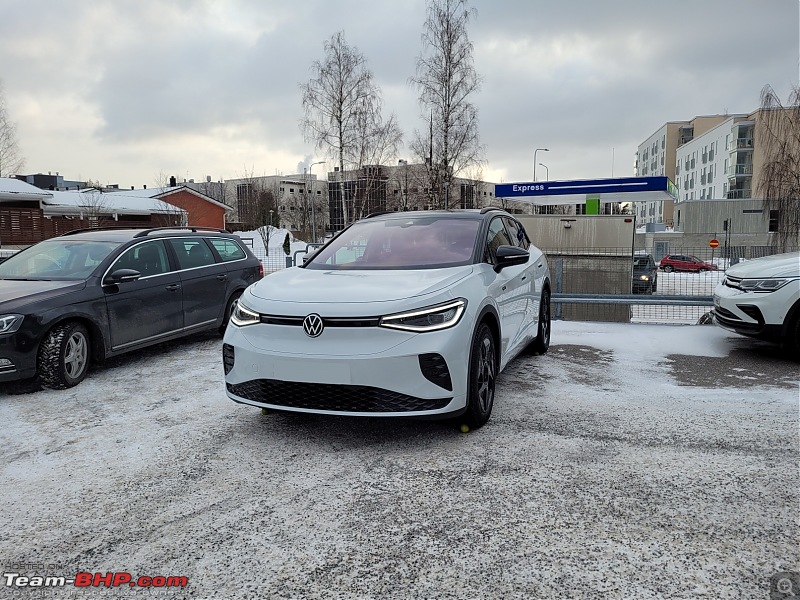 |
| |  (22)
Thanks (22)
Thanks
|
| The following 22 BHPians Thank StarrySky for this useful post: | 14000rpm, Ashutosh_kumar, carthick1000, Chrome6Boy, dailydriver, digitalnirvana, Dr.AD, Gannu_1, graaja, GTO, Harsha89, InControl, Omkar, Osteon206, ph03n!x, sanjayrozario, SRISRI_90, Tgo, thallipolivandi, Turbanator, Vaishak, vb-saan |
| | #4 |
| Senior - BHPian Join Date: Apr 2010 Location: EU - Nordic
Posts: 2,094
Thanked: 3,209 Times
| Exterior ExteriorThe ID.4 has the familiar VW face. Like most VW designs, I think the ID.4 has been designed not to wow anyone, but to offend no one. You'll know it's a VW, even if I were to mask the badge. The designers have done well to get the family look even without a fake grille. I guess the Skoda and Audi designers didn't get the memo. It's not an aggressive look by any means. Even the GTX with sporty pretensions looks pretty tame. A thick black part connects the two headlights to break the monotony. 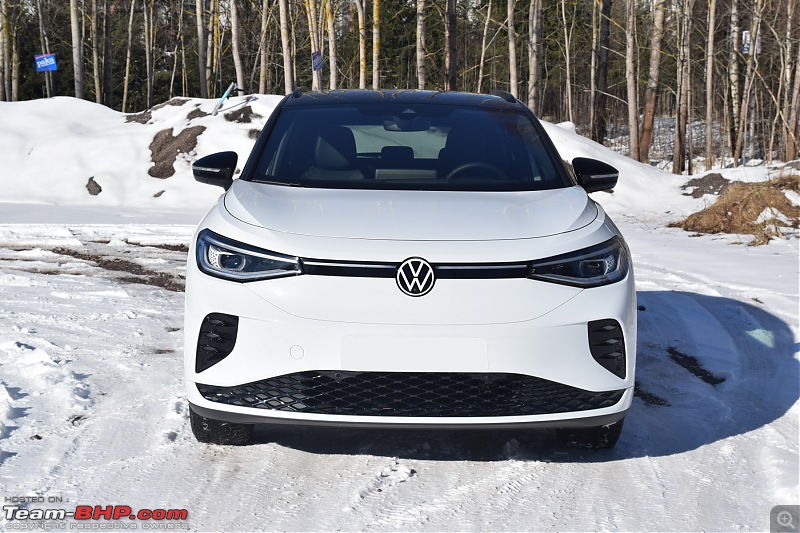 The bonnet has couple of smooth creases, but no power bulges or the like. 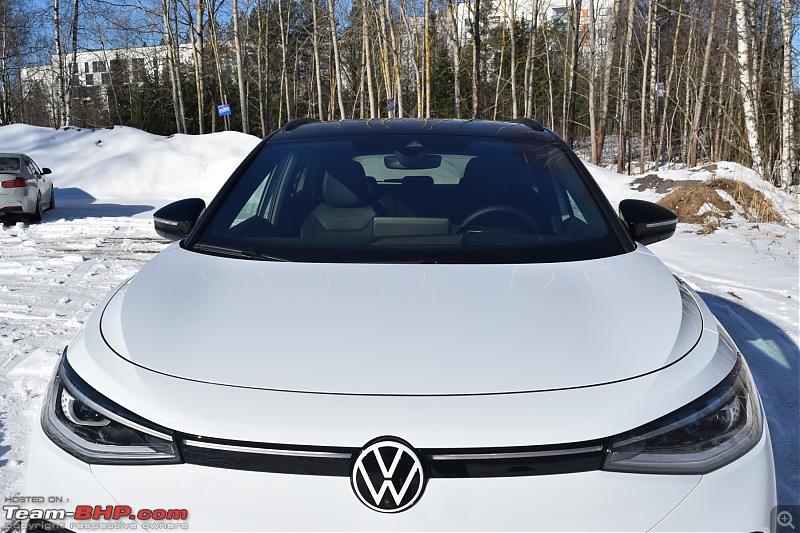 A light strip starts from the headlights on either side towards the middle, but they don't meet. In the US models, the VW logo itself is illuminated, and I think that looks better. Here it looks incomplete, in my opinion. The light strip comes on when the headlights are on. They are not part of the DRL. The LEDs bordering the headlights form the DRL. 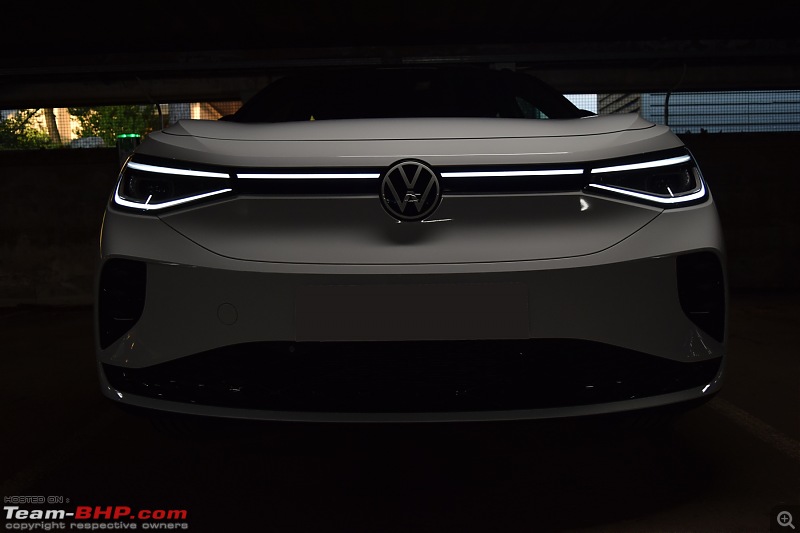 The lower half of the DRLs also doubles up as the turning signal light. Turn indicators are not directional. 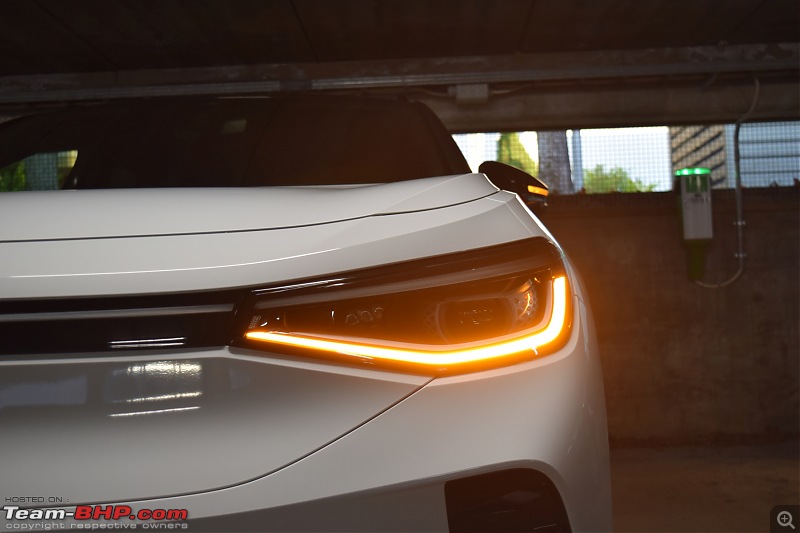 The GTX features matrix-LED lights. They are awesome!! 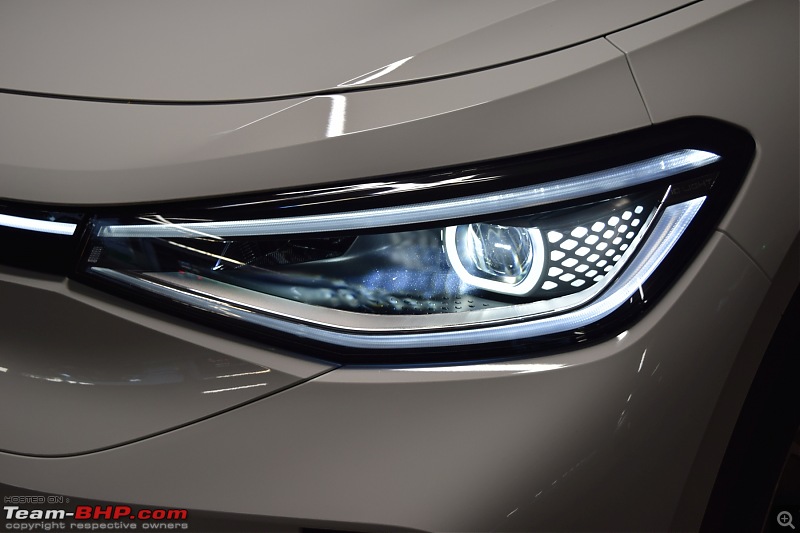 The headlights themselves look like eyeballs inside the housing. I am a fan. I think it gives the ID.4 a face. When I approach the car with the keys in my pocket, the lights turn on, swivel up and then swivel left and right. I remarked to my wife that the GTX knows I am approaching and is looking for me. Later I read in VW promotional material that this is exactly the effect that the designers intended. 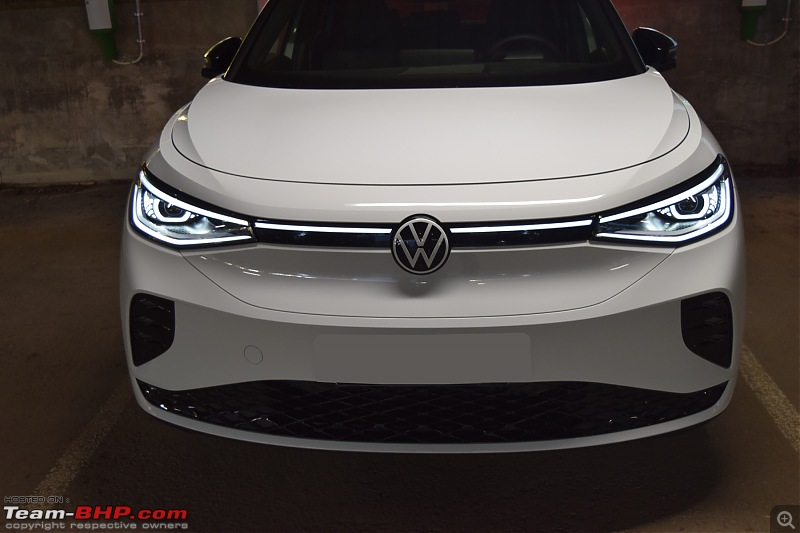 With all the lights on. The three vertically arranged lights on either side are exclusive to the GTX version.  The radar for ADAS functions is housed under the logo. It remains to be seen if it can stay clear during the snowy days. The front camera sits just below the logo. 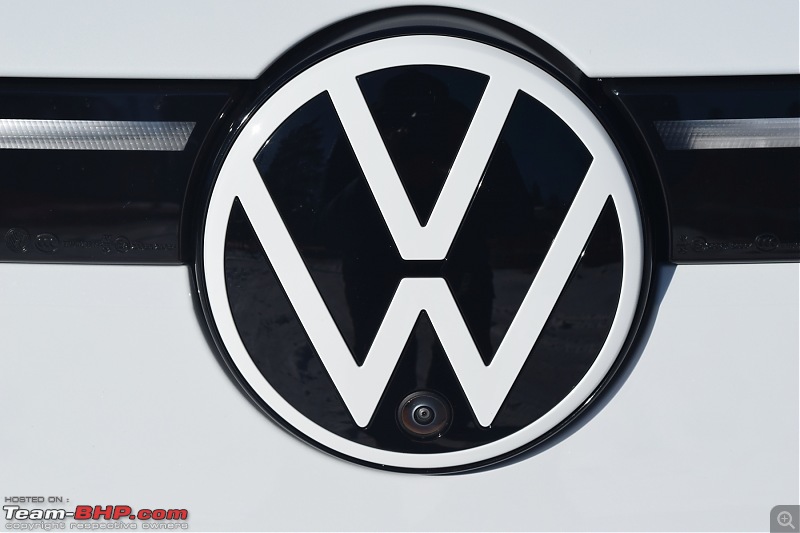 The front three-quarter view. Lower down the bumper, there is a honeycomb design with the air vents for cooling in the middle. The sides are closed off. The vents are always open, unlike in some competitors (eg: IONIQ 5, Mach-E) where they open only when needed. The lowest part of the bumper is in body colour in the GTX. VW has used body colour in several places instead of black, to give the GTX a different look. I am not sure how many people on the road would really notice. I think this gives the honeycomb part the appearance of a moustache. I wonder if the designers intended that too, to go with the eyes! 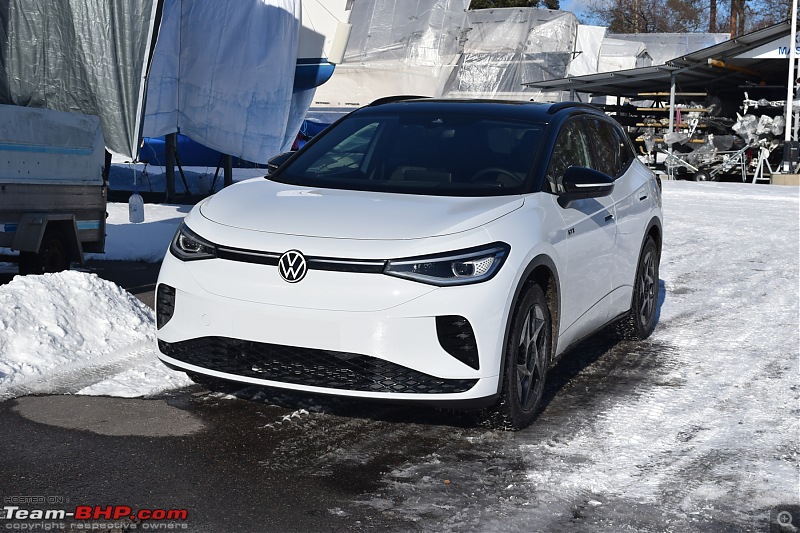 The camera for the ADAS systems: 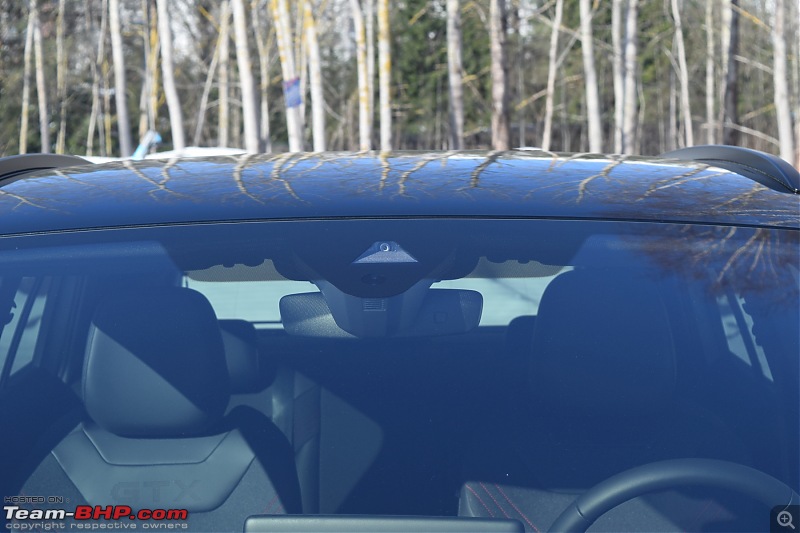 Fully clad wheel wells at the front and rear: 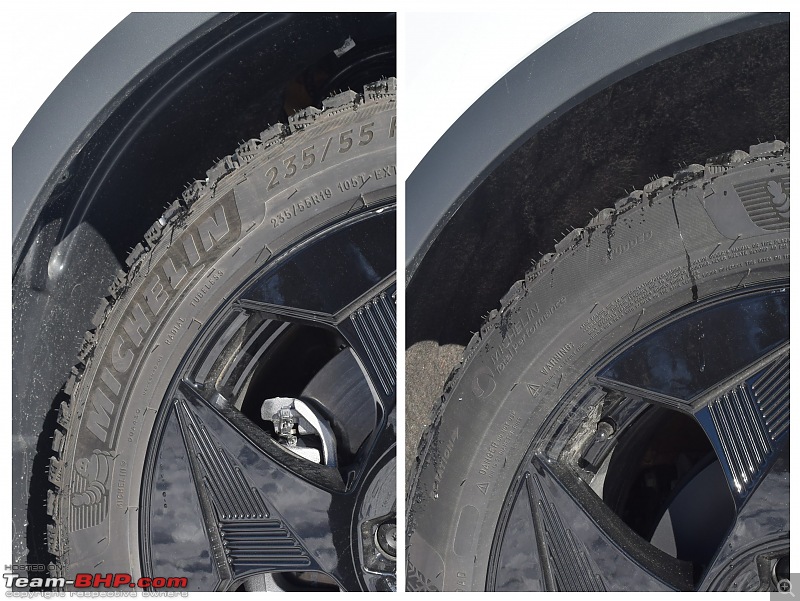 The ORVMS are large and are finished in black in the GTX. The side cameras for the 360-degree camera system are housed under the ORVMs. Turn signal lights are integrated with the ORVMs. 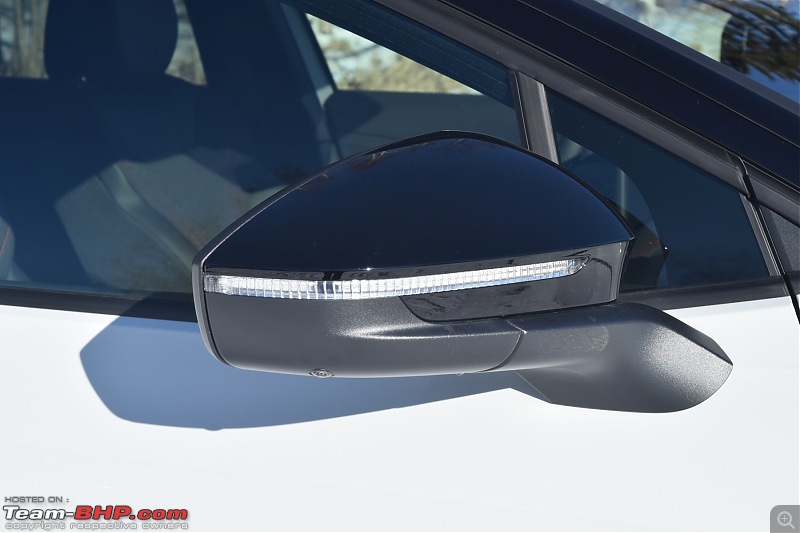 The indicator for blind spot warning is on the exterior of the ORVM, near the door. It is larger than it was in the Karoq and I feel this is a better placement. The indicator is in the peripheral vision on the driver's side. The brightness of the light can be adjusted. 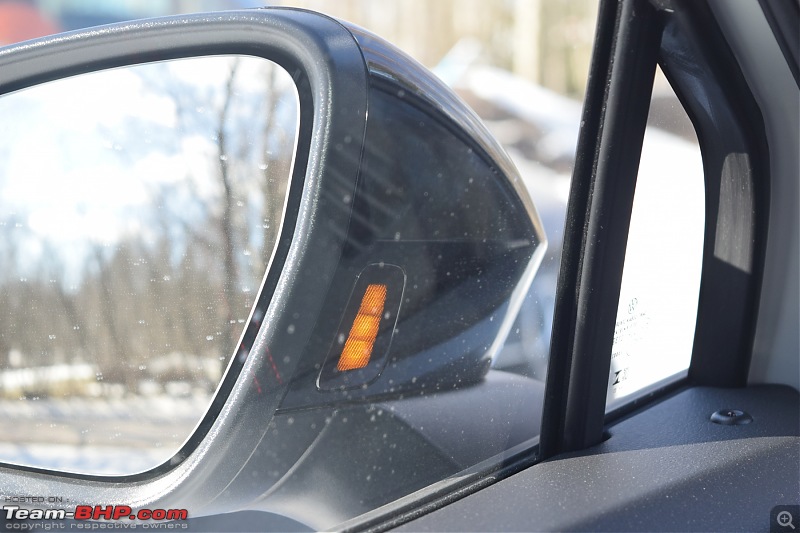 Coming to the sides, the two-tone paint job catches the eye. In this picture, the car is on winter wheels supplied by the leasing company. Usually, I have no choice in the matter, and I initially didn't, this time either. But at the time my car was to be delivered, the original alloy design that was in the order was not available. I was then given a choice of two designs and I chose full black without hesitation. I think it goes well with a white car with a black roof. Notice the darkened rear windows. This is a standard feature in the GTX. My previous car also had this feature, but in the GTX the glass is much darker. There is GTX lettering in black on both front doors. There are minimal creases on the doors. The bottom part of the doors is finished in body color in the GTX. 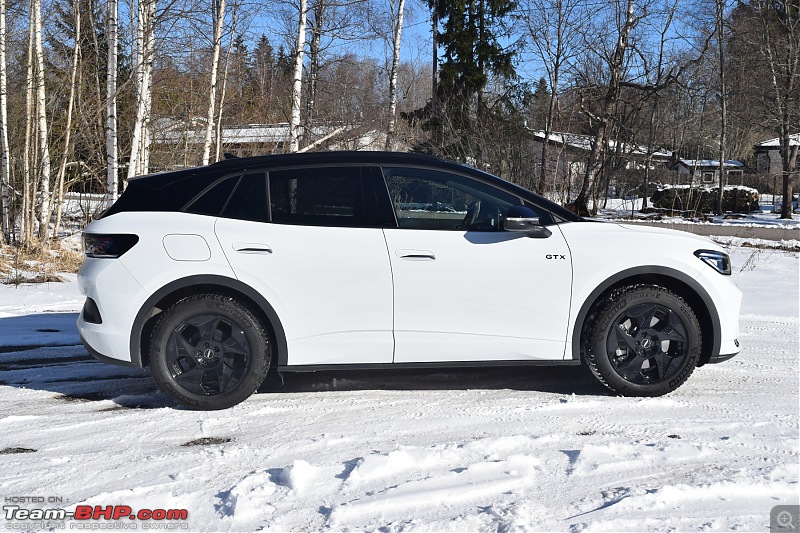 This picture emphasizes how short the bonnet is.  The downside of course is that there is no frunk. Notice the absence of any sound-deadening materials. No gas struts either. 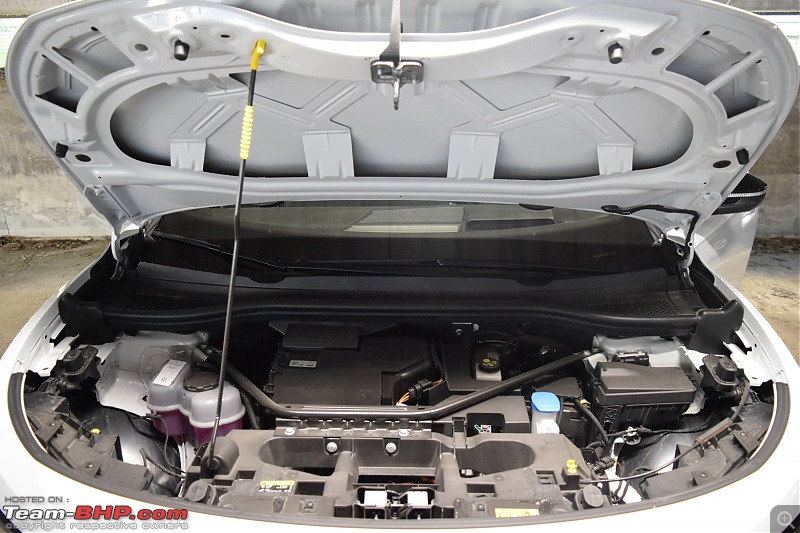 The GTX is equipped with keyless access system. Door handles have the appearance of age-old flap-type door handles. On the inside of the flap is a button to open the door. Press it and the door unlocks. There is no need to lift the flap to unlock or open the door. In case this doesn't work for some reason, we can lift the flap to open the door. However, this requires some force and we need to be careful. Initially, my wife wasn't aware of this button inside the flap and used to try and pull the flap up to open the doors. By doing this she pressed the button anyway, and so it worked. But a couple of times she tried to open the door this way when I was waiting inside with the central locking enabled. Not only did the door not open, the spring mechanism on the flap hurt her fingers as well. Touching the depression on the flap locks the car. I have found that sometimes locking the doors using this mechanism takes a couple of taps.  The door handles have soft lighting. Useful in the dark. 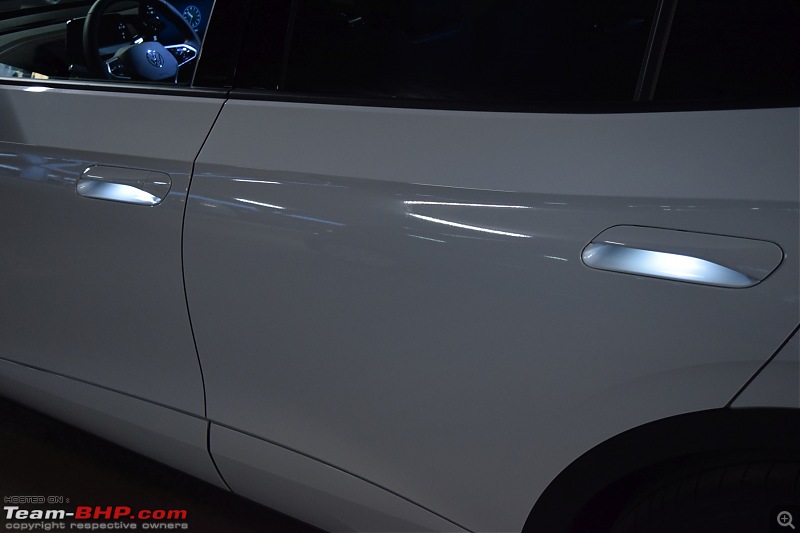 Logo projection under the front doors. Many have wondered why a VW projects the Renault logo?  Rear three-quarter view. The rear looks a bit bulky in my opinion, from this angle. 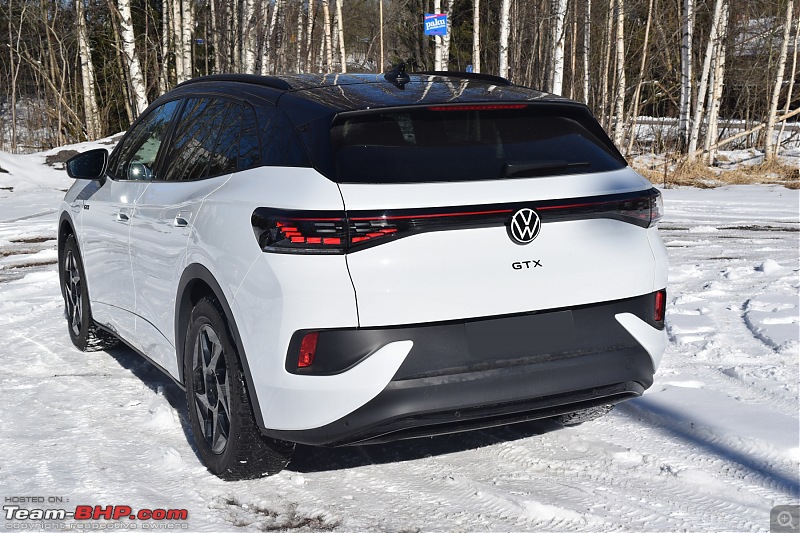 The rear looks quite simple, just like the front. It has an uncluttered look, with just a black GTX badge. There are no ID.4 badges anywhere on the exterior. The bottom portion of the bumper again has more sections in body colour in the GTX, compared to other ID.4 versions. Just like in the front, a light bar runs across the rear. Again, like in the front, the logo gets in the way of the light strips from either side meeting in the centre. There is a high-mounted stop lamp on the spoiler. 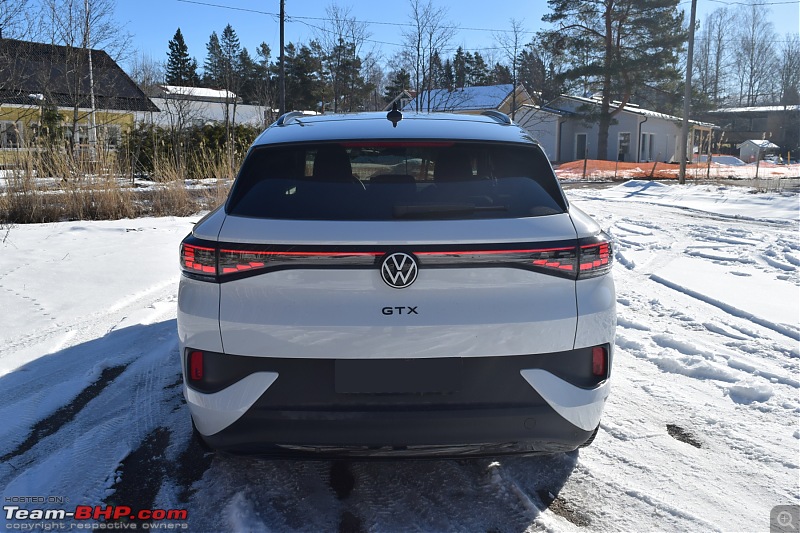 The swooping window line and smooth character line give the GTX an understated, yet classy look in my opinion. 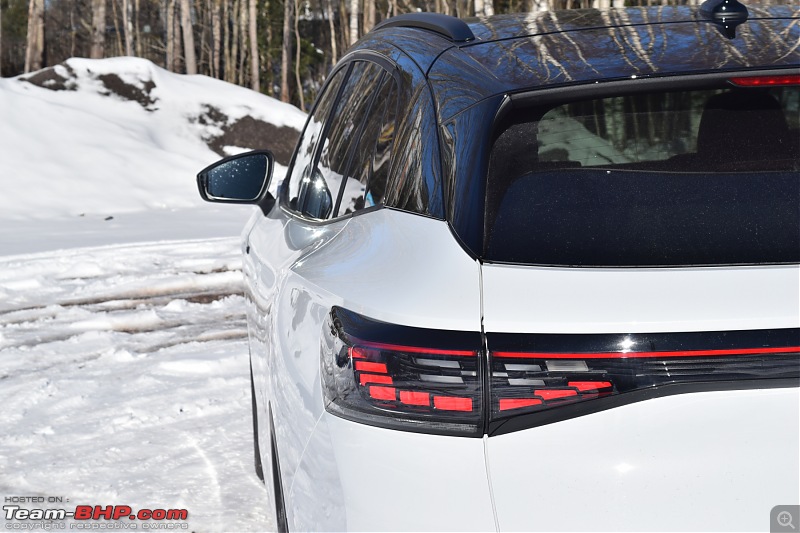 The rear light includes different elements and we can enable a couple of animations when unlocking the car. The rear turn signal lights are directional. 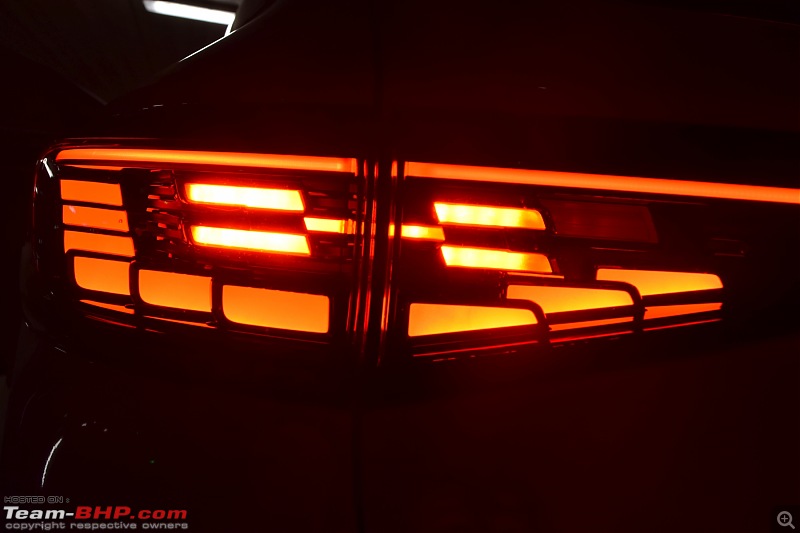 The review view camera is located quite low and gets dirty. However, there is a nozzle right next to it, and operating the rear window washer also cleans the camera. 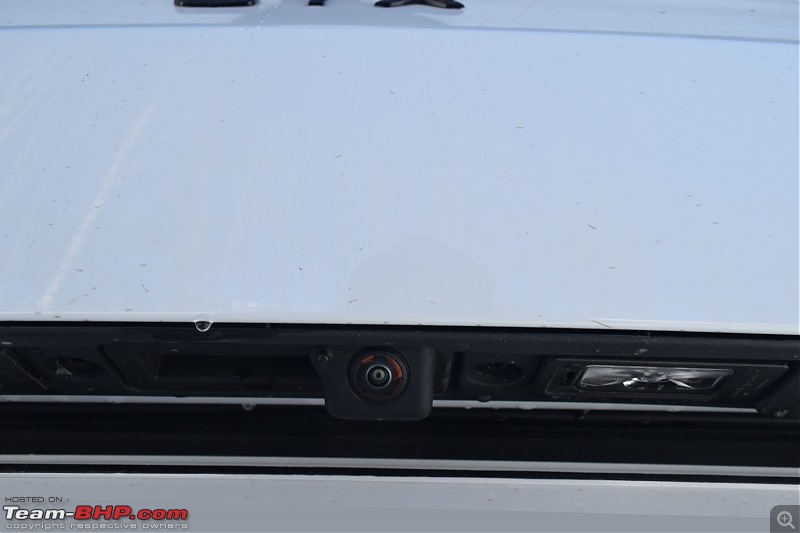 The rear also features a spoiler. Also notice the shark-fin antenna.  The spoiler is a bit too long. This prevents those automatic car washes from cleaning the rear window properly. After a wash, the area under the spoiler which has not been cleaned are visible, also in the IRVM. This is an eyesore. 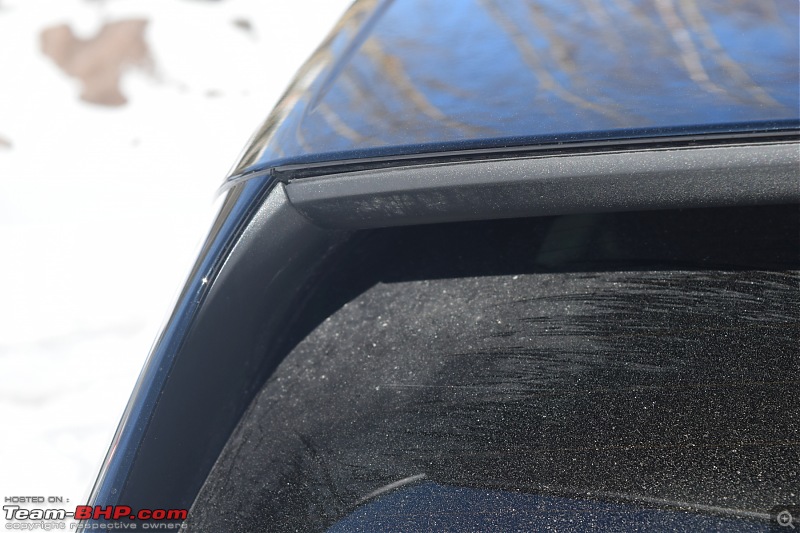 The charging port is located at the rear right. The charging port hatch has no auto-open or close mechanism. The charging ports have a protective cover inside the hatch, and the CCS port has some extra protection. 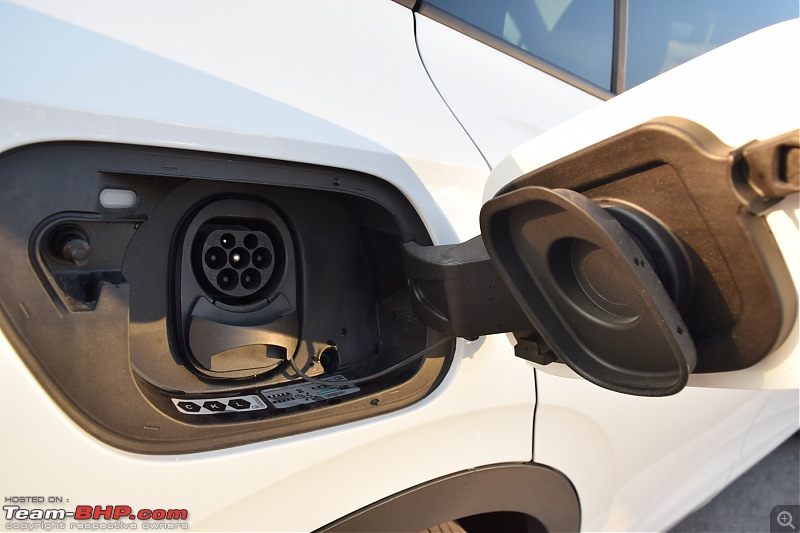 There is a handy latch for the CCS port cover when fast charging. 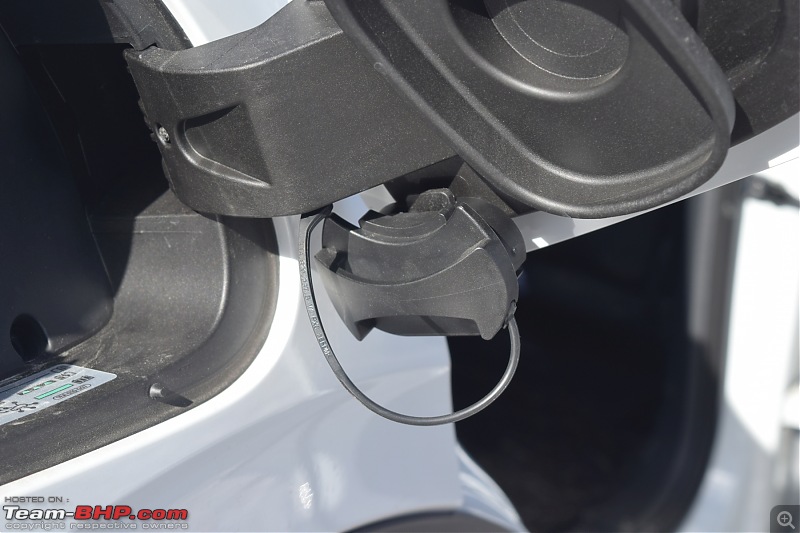 The underbody is flat and completely closed, as expected.  Just in case someone can't figure out what car it is!  Last edited by StarrySky : 25th June 2023 at 11:23. |
| |  (19)
Thanks (19)
Thanks
|
| The following 19 BHPians Thank StarrySky for this useful post: | 14000rpm, carthick1000, Chrome6Boy, dailydriver, digitalnirvana, Dr.AD, Gannu_1, GTO, loneagl09, NitNac, ph03n!x, sanjayrozario, SanSabh, sridhar-v, sukiwa, thallipolivandi, Turbanator, Vaishak, vb-saan |
| | #5 |
| Senior - BHPian Join Date: Apr 2010 Location: EU - Nordic
Posts: 2,094
Thanked: 3,209 Times
| Interior (Front) Interior - FrontThe front doors are heavy and open wide. They close with a nice thud. 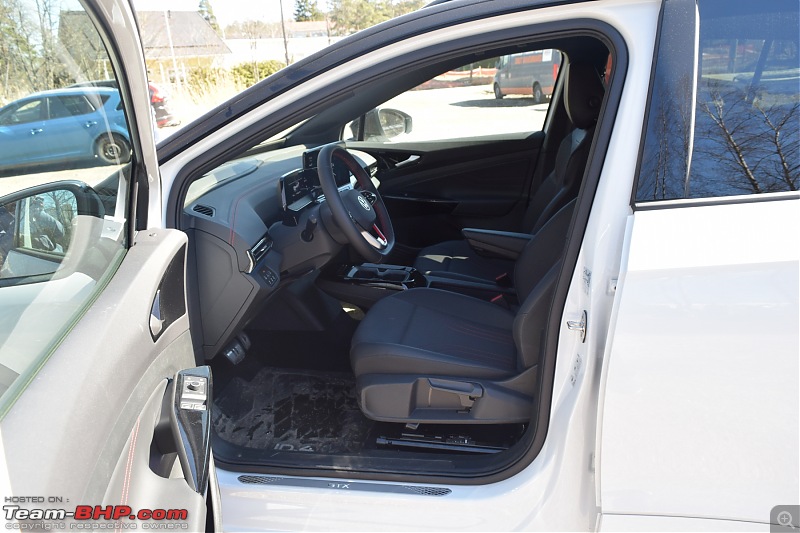 The doorpad has soft-touch material at the top. The rest is hard plastic, except the handrest, which has soft padding. The piano black on the door handles is a bad idea. The boot open button is on the lower part of the door pad. 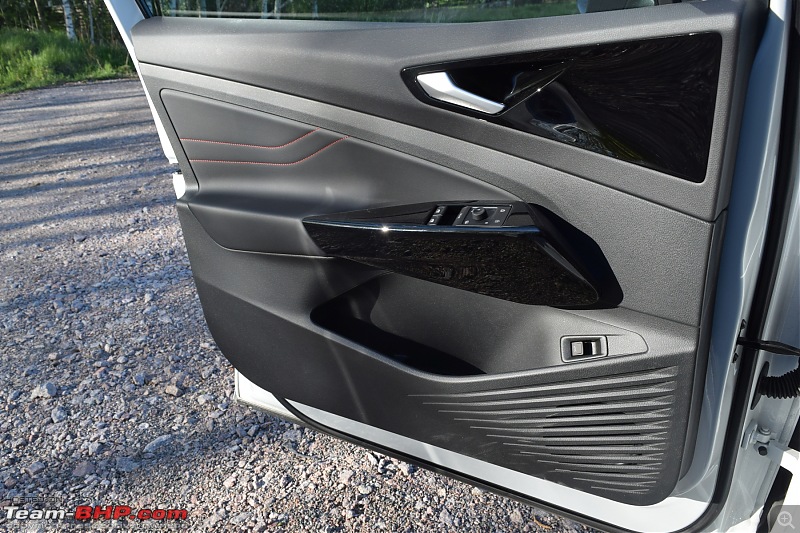 The mirror and window controls are on the armrest. The central locking and child lock are also on this panel and are controlled by touch-sensitive switches. Initially, I used to press the central locking button hard to lock/unlock the doors, but the operation was very unreliable. Then I realized that just a little tap is enough. 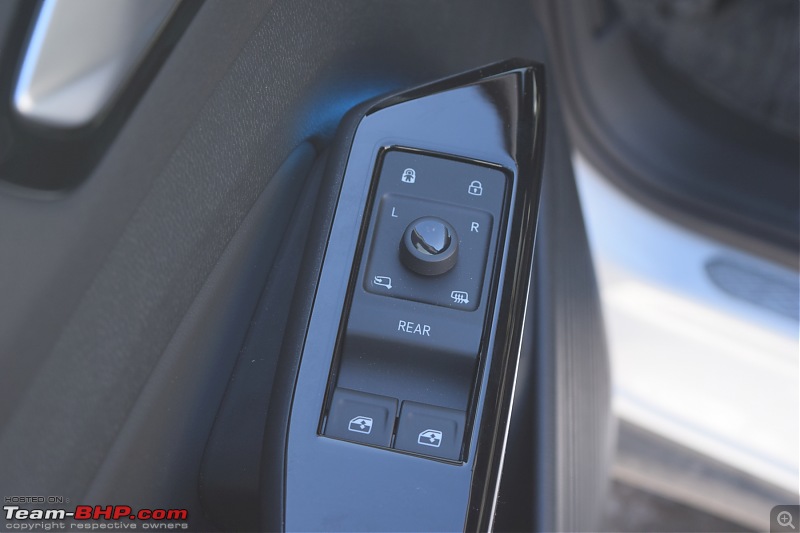 A common complaint about the ID.4 (and other IDs) is that VW has provided only two window switches to control 4 windows. By default, the switches control the front windows. If I press the REAR button, then it lights up, and then the switches control the rear windows. If I keep the REAR button pressed for some time, then it starts flashing. Then all four windows can be controlled with each button. It's quirky, but I don't really mind. I can probably count on the fingers of one hand the number of times I have opened the windows in the Karoq. 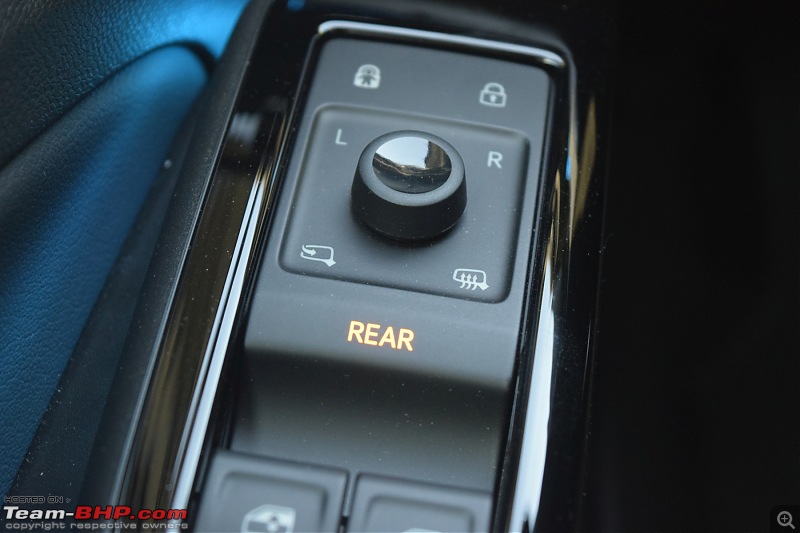 The door pockets are a decent size, and they are felt lined.  They can hold a can of chips, substituting for a 1L bottle here.  The dashboard layout is quite minimalist. No real buttons anywhere.  The dashboard features soft-touch materials at the top, with red stitching that is exclusive to the GTX. 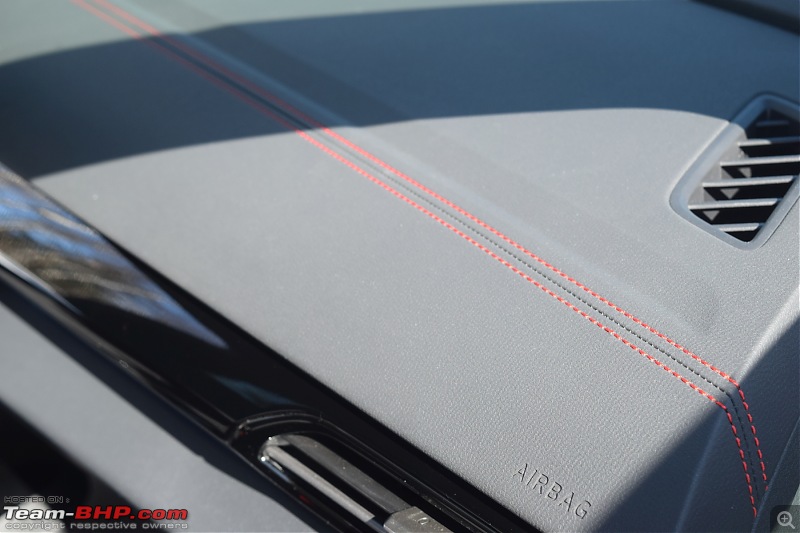 A piano black panel forms the second layer on the dashboard. The side AC vents are located on this panel and the ambient lighting is located underneath this layer. A faint glow from the ambient lighting behind the door handle can also be seen in this photo. 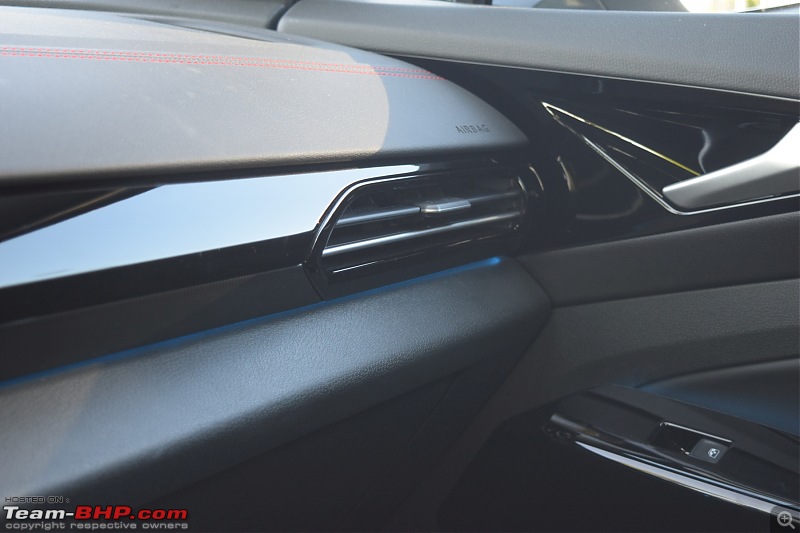 The bottom part of the dashboard is hard grey plastic. The centre AC vents are situated on this part. If we look closely, we can find a hint of brushed metal look. Frankly, this area and feels out of place in an almost €60k car. It may last long, but the Karoq which was nearly €20k cheaper had better looking materials, and they were better to the touch too.  The panel to control the lights is located where you would expect it in a VW, but it's not a rotary dial. This too is touch-sensitive. I leave the lights in Auto mode. With the Karoq, I used to do the same and never bother with the rotary switch at all. Here, the front and rear windscreen heater buttons are also located on this panel. It would be impossible to activate them without looking away from the road.  The front seats. Electrically adjustable seats are an option, but my car lacks them. Lumbar adjustment is also lacking. However, I have to say that so far, it hasn't been a huge miss. The seats are very supportive. I feel that they are wider than those I had in the Karoq. The under-thigh support is a more complicated topic. I will address it in the driving impressions part. 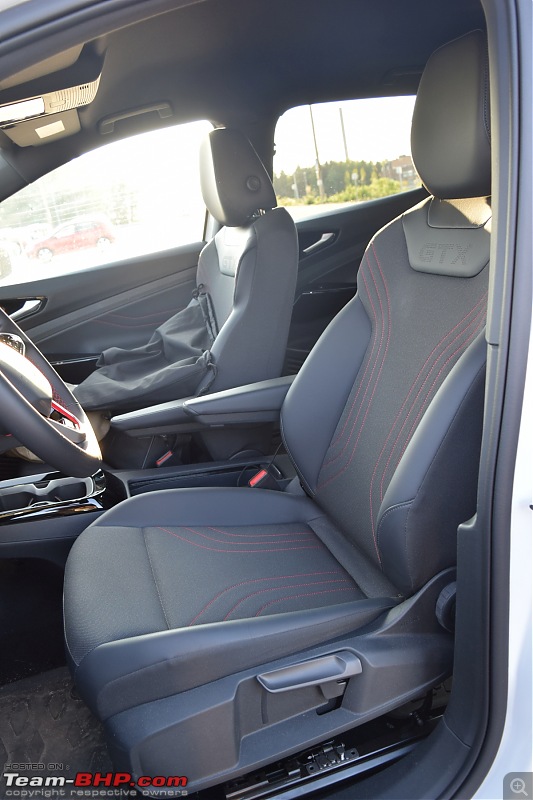 Separate handrests for the front seat occupants is good. Each one can be adjusted according to the preference of the occupant using a button located under the armrest. I think it also gives a sense of open space in the centre. But I wish they were slightly broader. If you have big hands, then you will likely feel that the handrests are too narrow. 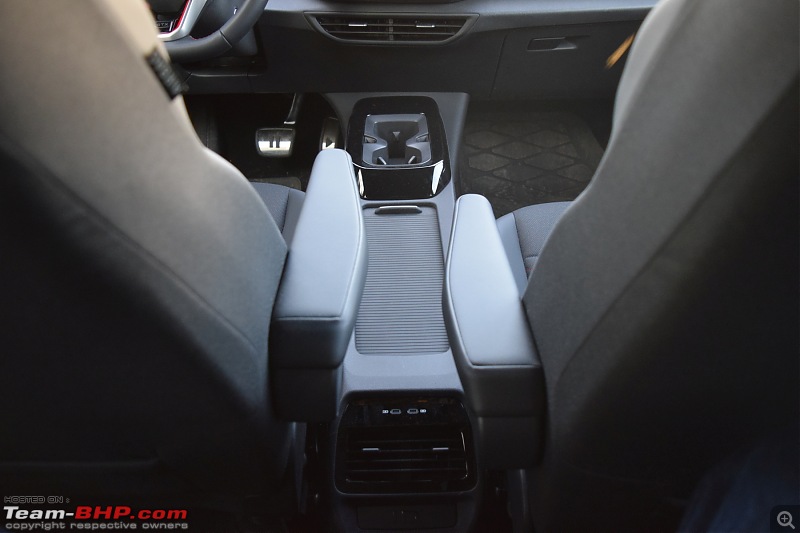 The front seat belt holders have felt lining. 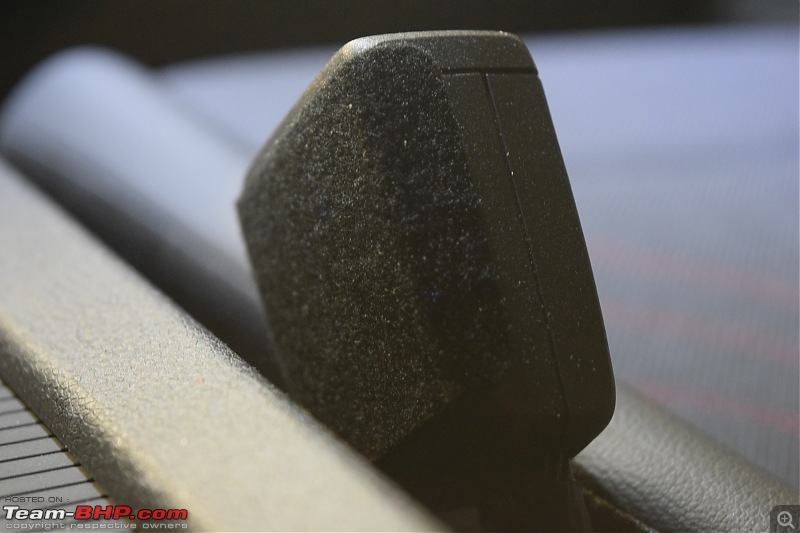 Front seatbelts are height-adjustable: 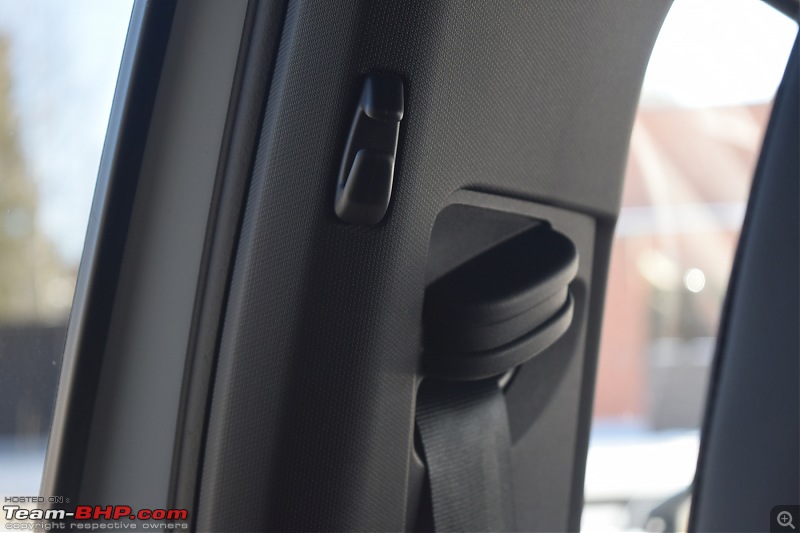 The centre console is quite spacious. The cup holders can hold two fairly large cups or a 1L bottle. Two slots are provided in front of the cupholders. They will be handy to keep charging cards or parking slips. 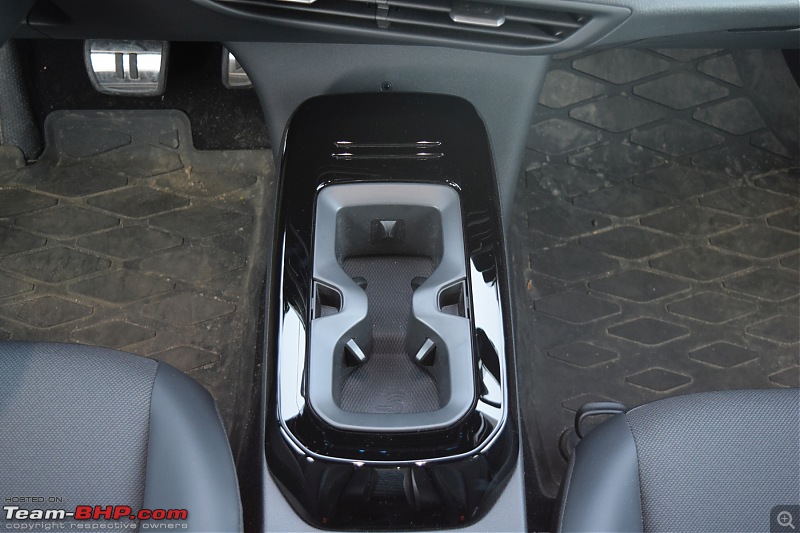 Even with a relatively big cup or bottle, access to the infotainment screen will not be blocked. 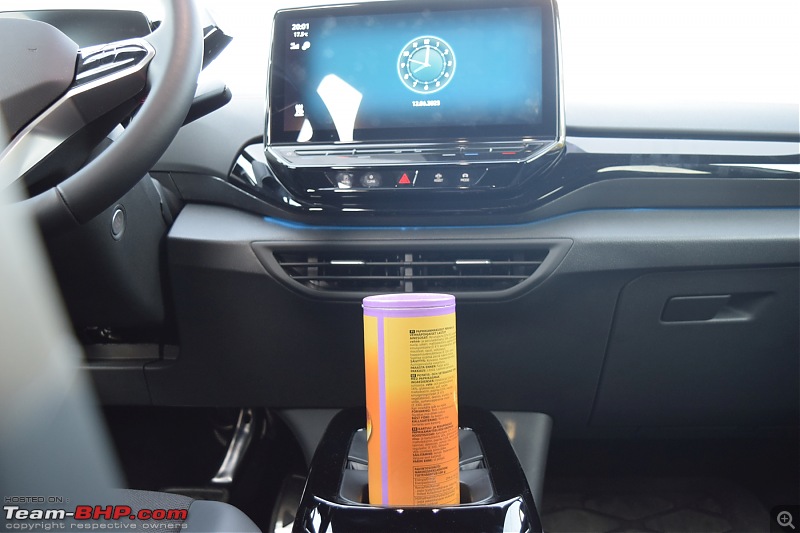 The cup holders are removable. Note the area marked to keep the keys. It is not necessary to leave the keys there, during normal operation. If the key battery is running low, then the keys should be left here. 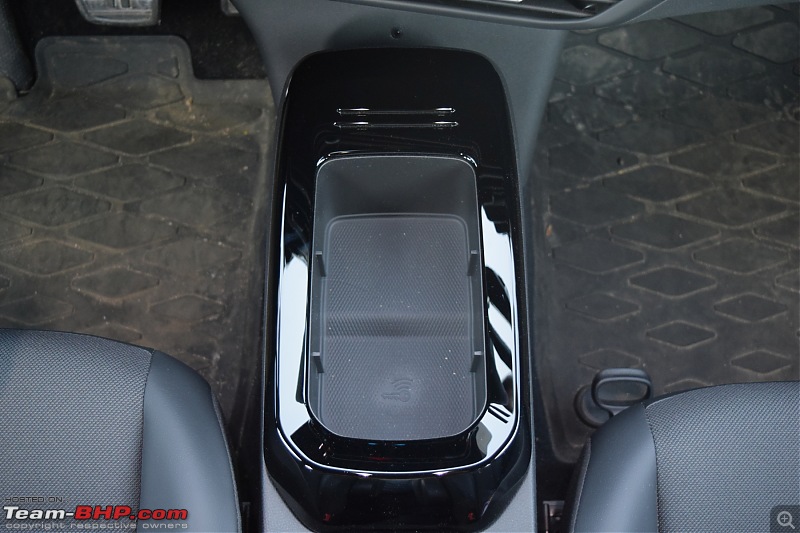 Under the cup holders is the space for a mobile phone. It can hold a fairly large phone. This space is also a wireless charging pad.  The rest of the area features two USB-C ports, and a storage space with removable partitions.  This area also has a full length cover. 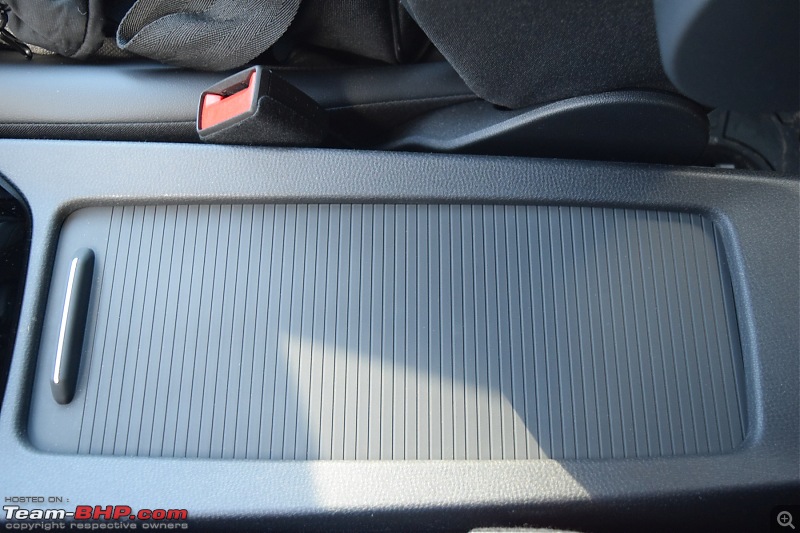 Last edited by StarrySky : 25th June 2023 at 11:23. |
| |  (17)
Thanks (17)
Thanks
|
| The following 17 BHPians Thank StarrySky for this useful post: | 14000rpm, Ashutosh_kumar, carthick1000, Chrome6Boy, dailydriver, Dr.AD, Gannu_1, GTO, InControl, Omkar, sanjayrozario, SanSabh, sukiwa, Tgo, thallipolivandi, Vaishak, vb-saan |
| | #6 |
| Senior - BHPian Join Date: Apr 2010 Location: EU - Nordic
Posts: 2,094
Thanked: 3,209 Times
| Interior - Front (Contd.) Interior - Front (Contd.)The steering wheel is chunky and quite nice to hold. The red stitching makes an appearance here as well. It also features the GTX logo. With the lack of backlight when the car is turned off, the left and right spokes look empty. 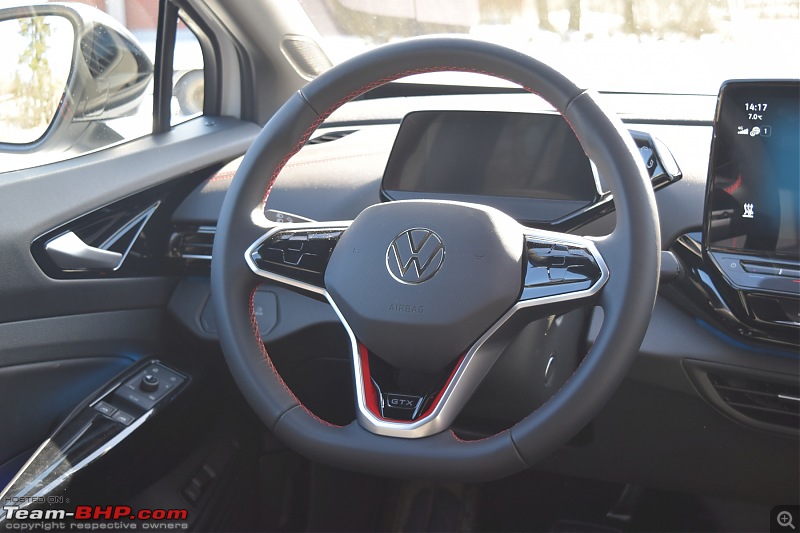 The steering is adjustable for rake and reach. The driver's instrument console is attached to the steering column and moves with the steering wheel. So it never gets obstructed by the steering wheel. 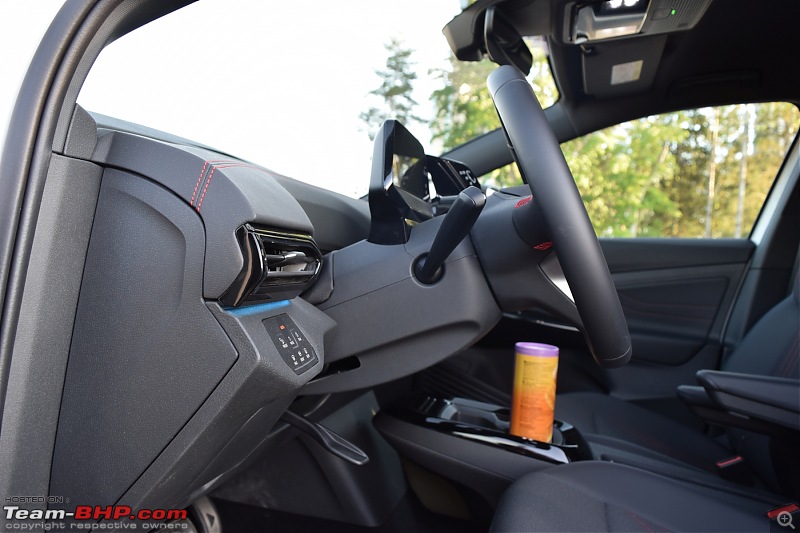 The main beam controls are located on the stalk to the left of the steering wheel. I push it forward once when I start driving in the evenings, so that the matrix LED light system takes over. This brings up the main beam icon in white colour on the driver's display. When the high beam is active, it turns blue. 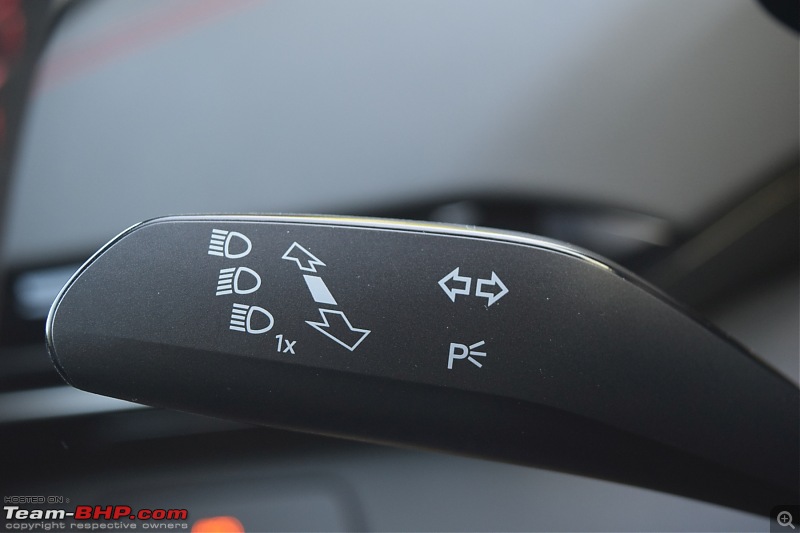 The right side stalk is for the front/rear wiper controls and windscreen washers. Both stalks are quite chunky and feel built to last. 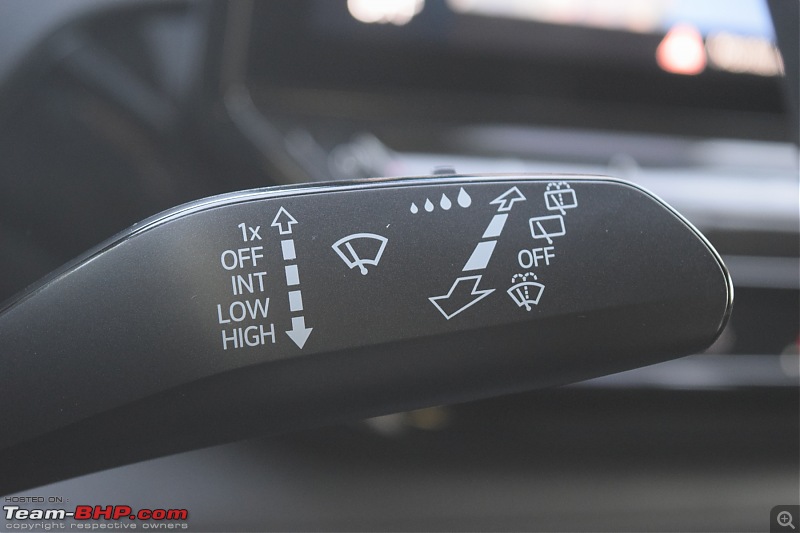 The left side spoke on the steering wheel features the buttons for the adaptive cruise control. The +/- buttons can be used to set the speed in 1 or 10km/h steps. Pressing the buttons increase/decrease speeds by 1km/h. Pressing and holding them adjusts the speed by 10km/h. The easier way to adjust the speed by 10km/h is to just swipe up/down between the +/- buttons. The square depression in the centre can be used to adjust the distance setting for the adaptive cruise control. The bottom right button is to enable/disable the Travel Assist. I have found that pressing the SET/RES buttons sometimes also activates the distance control - a downside of the touch sensitive buttons, as other reviews have complained. The reviews also complain that it is possible to inadvertently make some adjustments if your hand brushes against these buttons while taking turns, etc. Yes, this is true, but it's a very rare occurrence in my experience. 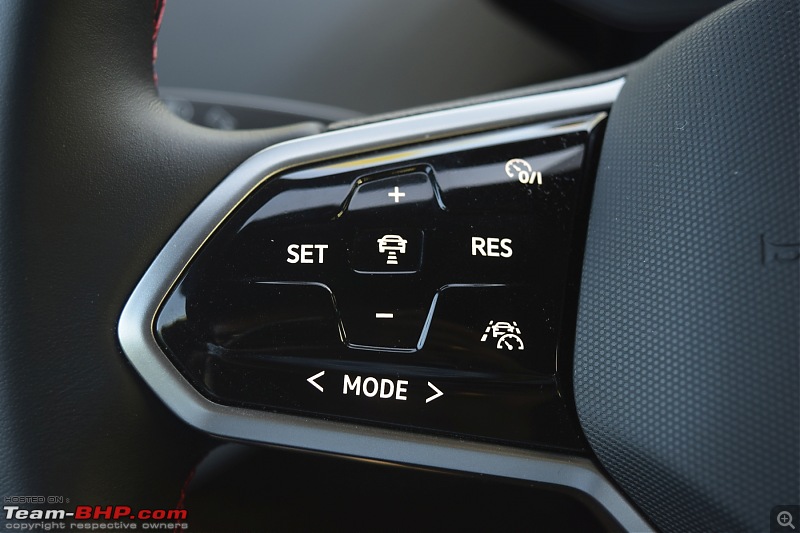 The right side features audio control buttons. 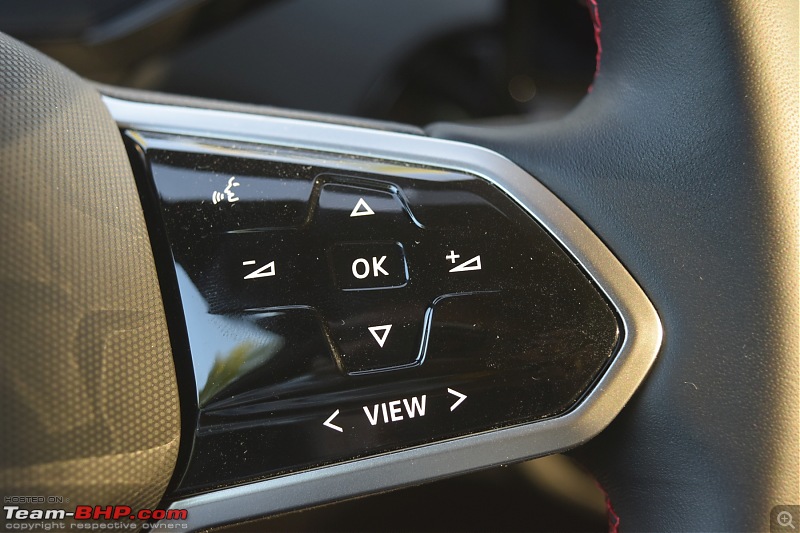 The drive selector is located on the side of the driver's display. 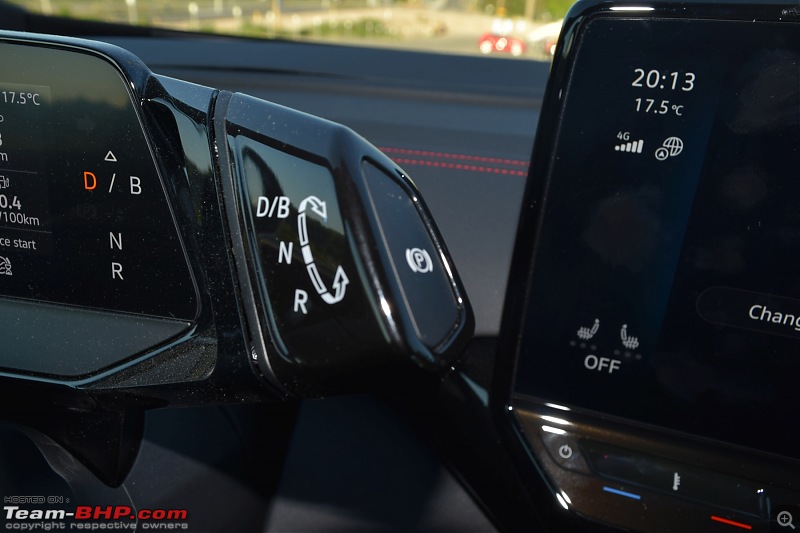 There is a start/stop button on the steering wheel, in case one needs to start up the electricals only. 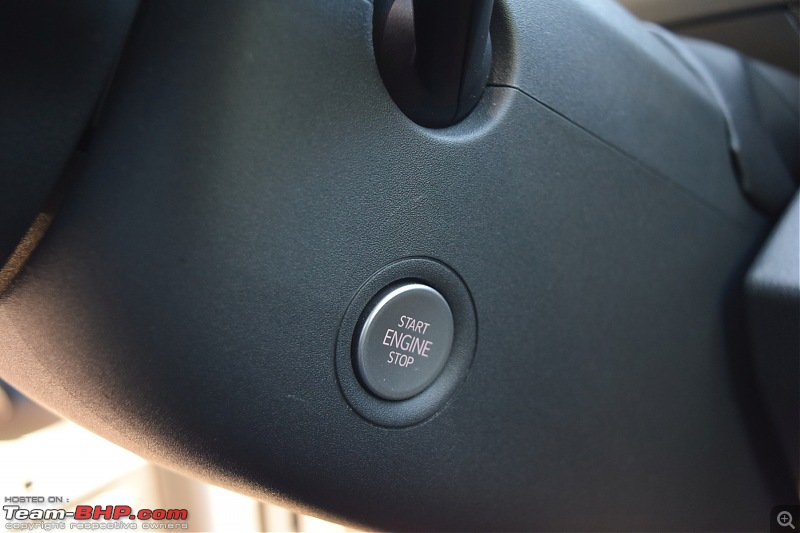 The centre console cannot be moved, so it seems like a missed opportunity to provide some extra storage here.  The rear view mirror provides an acceptable view out towards the back.  The overhead console housing the lights, and SOS and service call buttons. The controls are touch sensitive. Tap the lights to turn them on or off. Running a finger along the lights adjusts their intensity. On the downside, I have hit the service call button (one with the spanner icon) a couple of times already while attempting to adjust the lights. Thankfully, the SOS button is a real button and is located away from the touch panel. 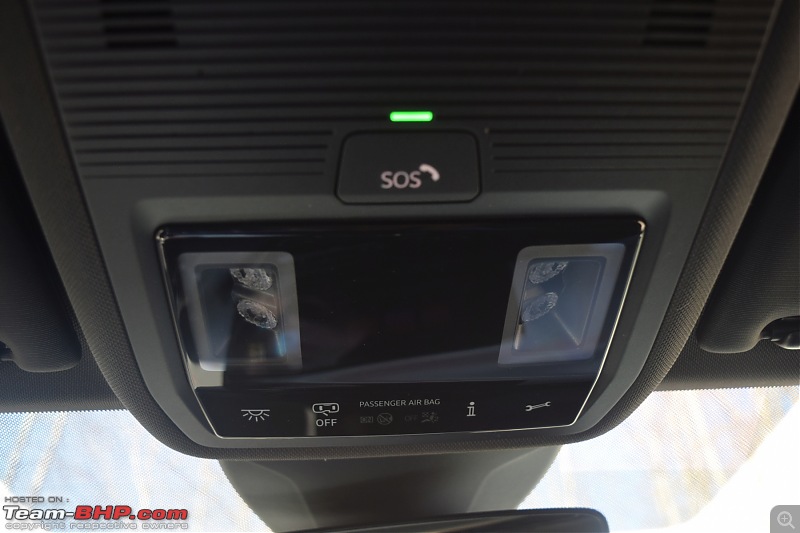 The bonnet release lever is in a very familiar position. 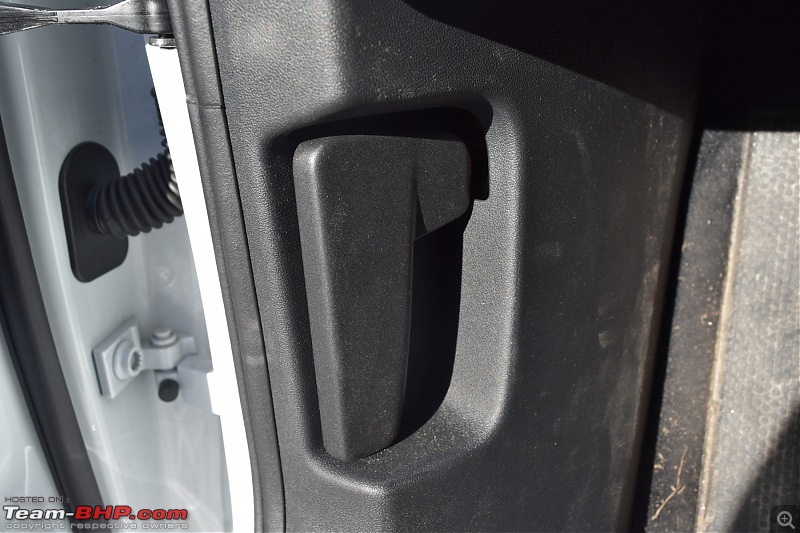 Grab handles are provided on all four doors. They are well-damped.  Both the driver and front passenger get sun visors with mirrors and a light: 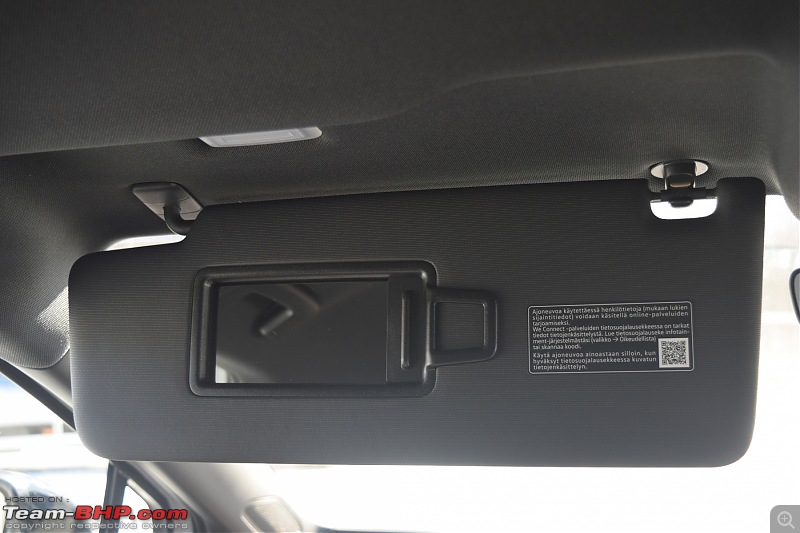 Glovebox is sufficiently spacious: 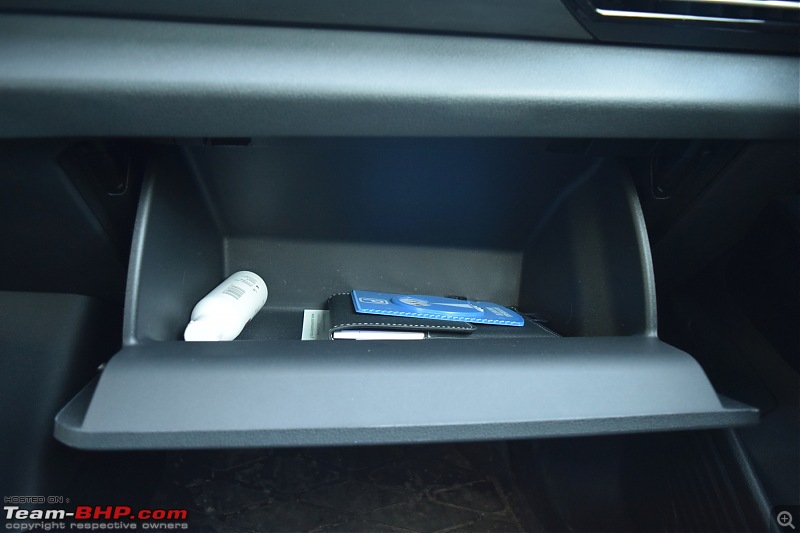 Projector for the HUD: 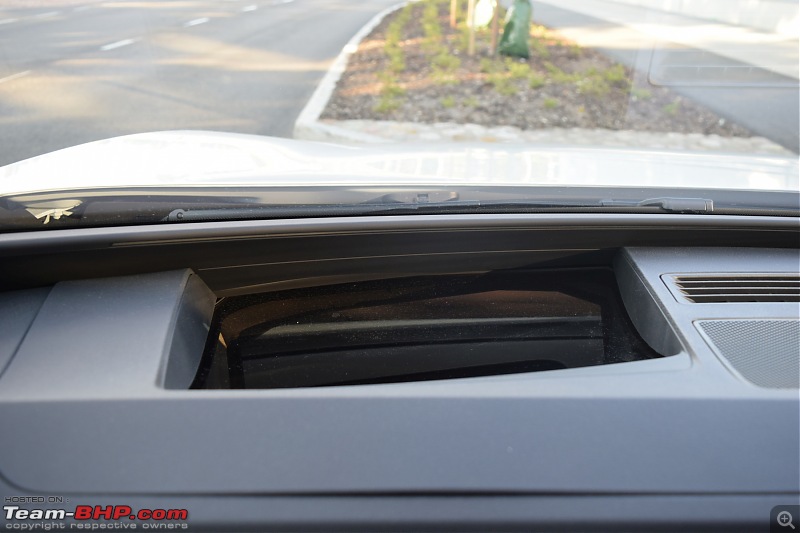 The HUD display. When navigation is on, the directions are displayed to the right of the speed display.  The GTX-branded scruff plates:  The stainless steel Play and Pause pedals: 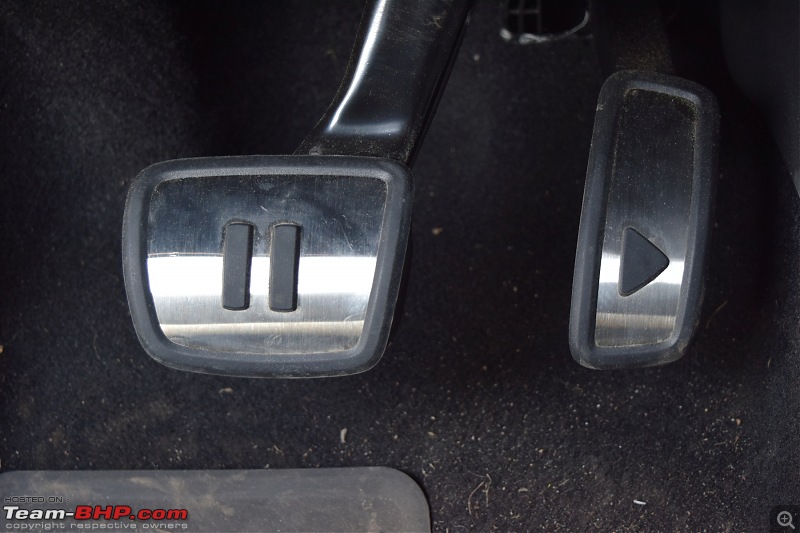 Last edited by StarrySky : 25th June 2023 at 11:24. |
| |  (16)
Thanks (16)
Thanks
|
| The following 16 BHPians Thank StarrySky for this useful post: | 14000rpm, AYP, carthick1000, Chrome6Boy, dailydriver, Dr.AD, Gannu_1, GTO, InControl, ph03n!x, sanjayrozario, SanSabh, sukiwa, Tgo, thallipolivandi, vb-saan |
| | #7 |
| Senior - BHPian Join Date: Apr 2010 Location: EU - Nordic
Posts: 2,094
Thanked: 3,209 Times
| Interior (Rear) and Boot Interior - RearThe rear door opens to almost 90-degrees. Notice the absence of scruff plates at the rear. 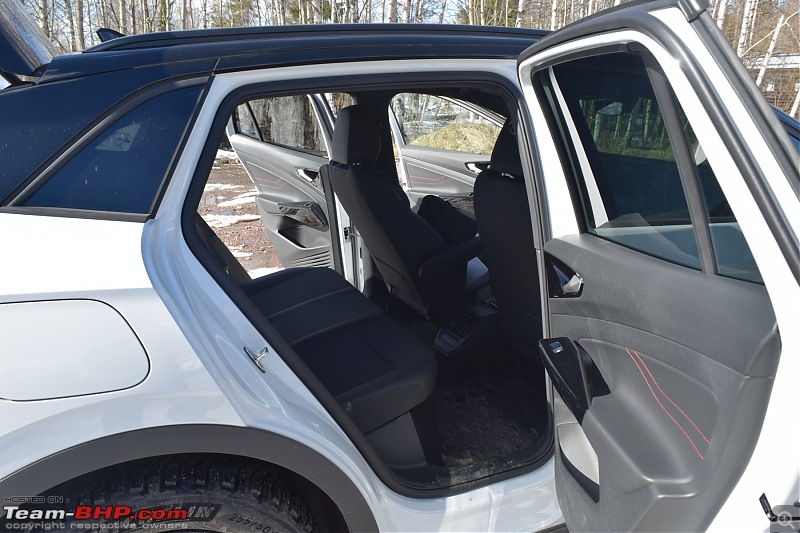 The doorpads have similar design as in the front, except that there are no soft-touch plastics on the top part. 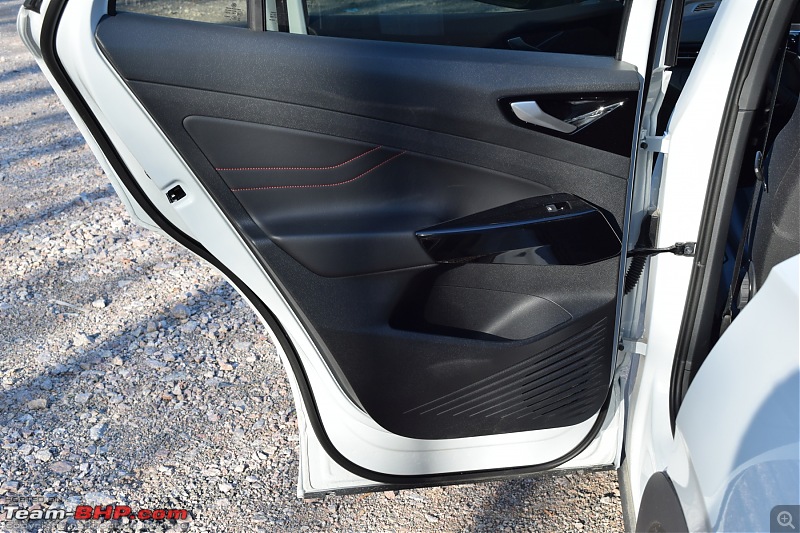 The rear door pockets are not as big as those in the front. They can still hold a 500ml bottle. There is no felt lining either.  The rear window goes all the way down - almost:  All three rear passengers get 3-point seatbelts. Adjustable head restraints are available for all rear seat passengers. The seats are comfortable, I mean the outer side seats. The seat base and the backrest in the middle are hard. I am not sure how comfortable it will be for long trips. The middle seat is certainly harder than it was on the Karoq. There is no seat heating available for the rear seats, even as an option. 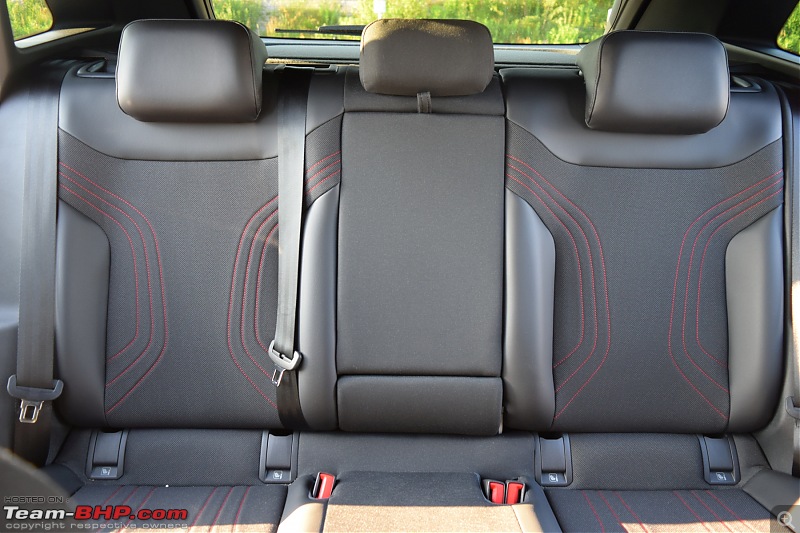 Just as expected in a car built on an EV platform, there is no transmission tunnel. On this front, the middle seat passenger will have no complaints. 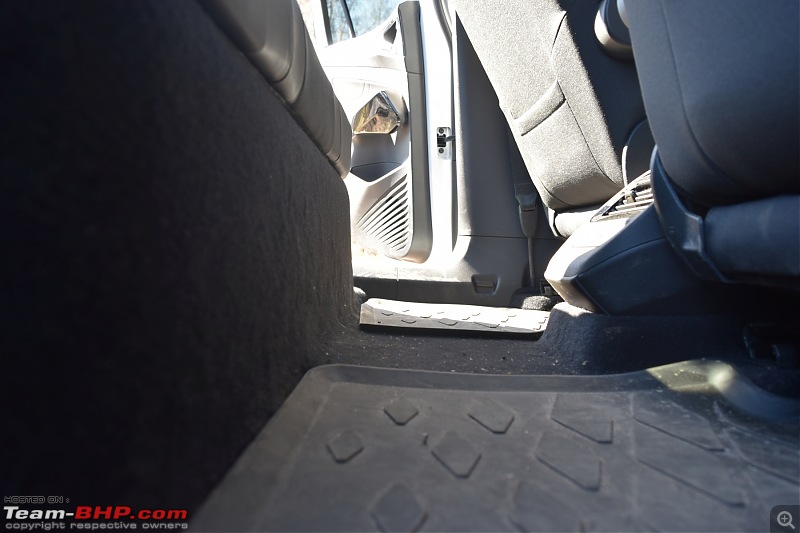 The rear seats are fixed. They also cannot be moved forward or backward. There is no backrest angle adjustment. I don't see it as a big disadvantage in this car as the the seatback is set at a comfortable angle. 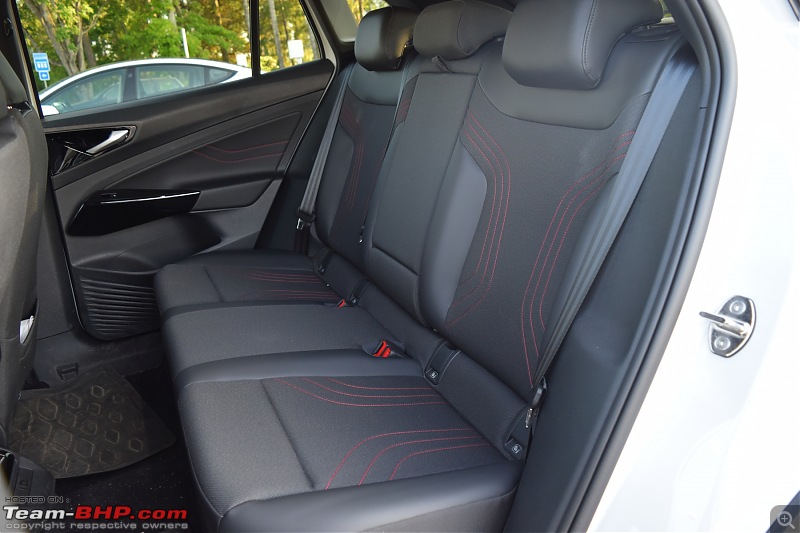 The quarter glass at the rear is small, but still useful.  The under-thigh support is good for a person of my height (5'8"), unlike some other EVs (Tesla Model Y, for eg:.). There is space to rest the foot under the front seats. 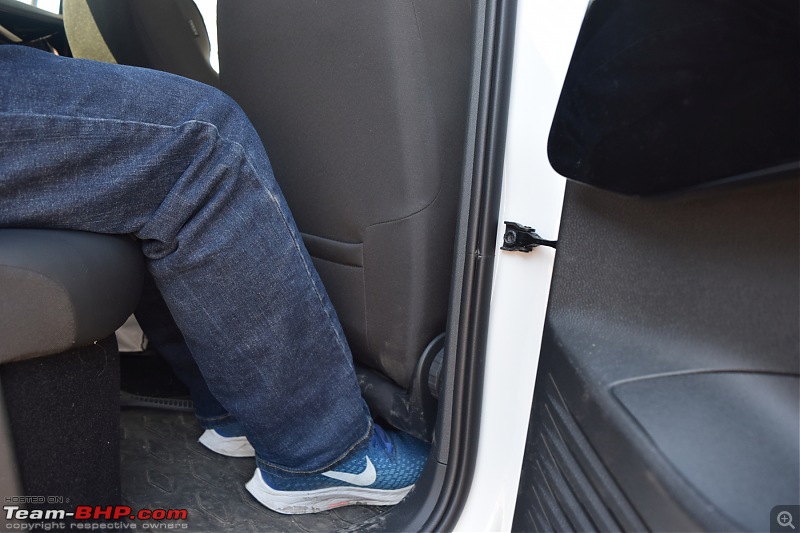 The minimum and maximum legroom. There is a lot of room. The air vents under the front seats can also be seen. 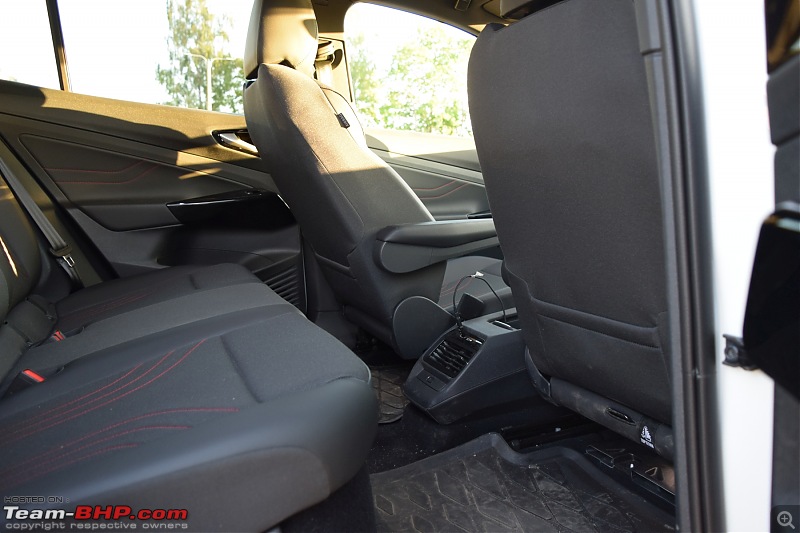 This is how much legroom I have sitting behind the front seat set as far back as possible. I am 5'8". Getting in takes some maneuveuring with the front seat in this position. But once settled in, I will be comfortable travelling long distances in this position. I can also rest my feet comfortably under the front seat. 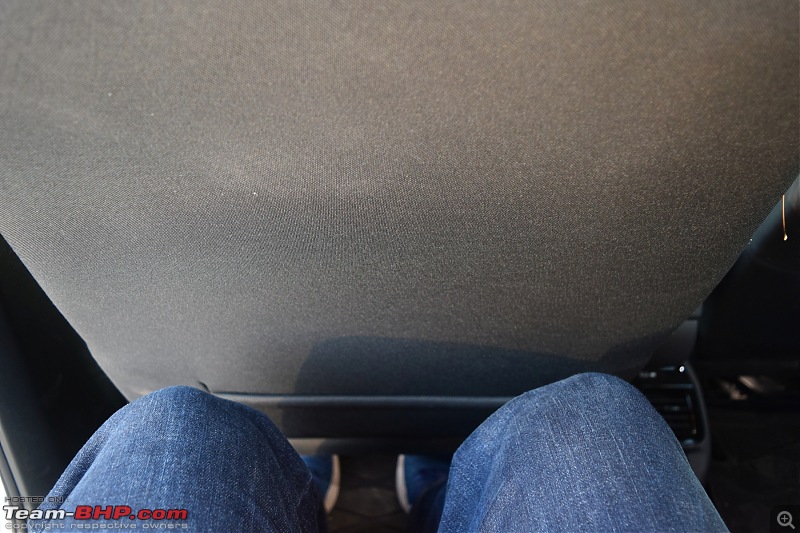 The front seatback pockets are large enough, but there is no separate mobile phone pouch at the top. There is no leatherette seatback, like I had in the Karoq. This would make cleaning it a bit harder if they get dirty from the children's shoes in the winter. However, the children are older, so I hope they will be more careful. Also, there is more space than in the Karoq at the back. 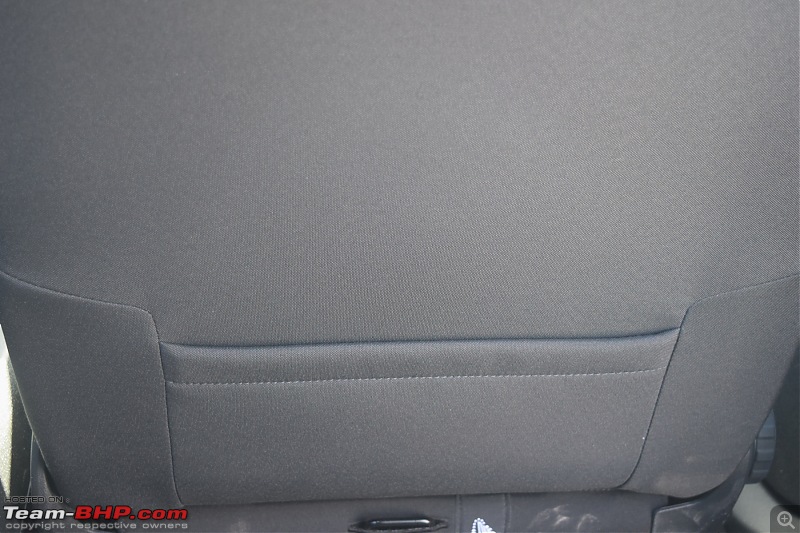 There is a centre armrest that houses two cupholders. Very welcome feature for long journeys with kids. 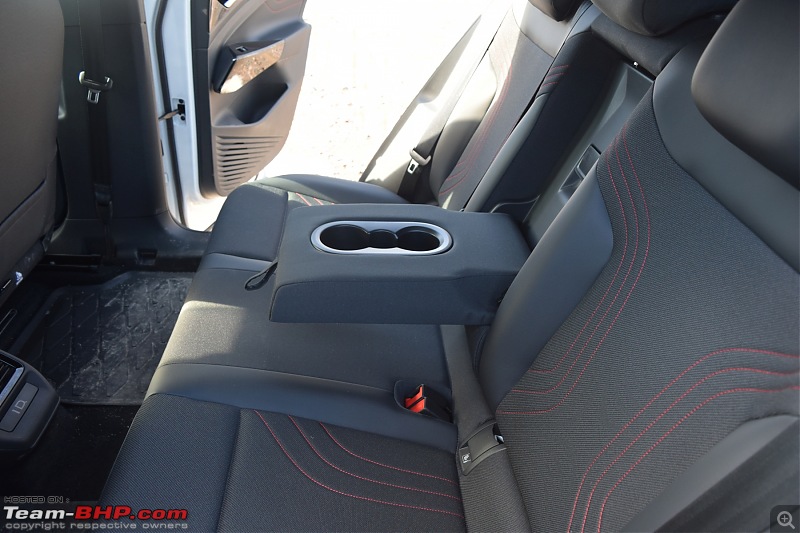 There is also a ski hatch. 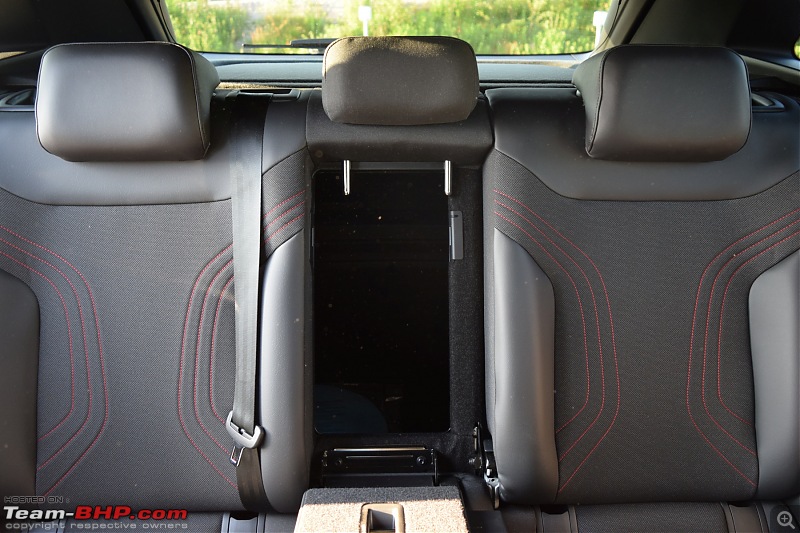 The rear AC vent. It is quite close to the floor, but I haven't so far heard any complaints from the children about its effectiveness. Two USB charging ports are available for rear seat passengers. 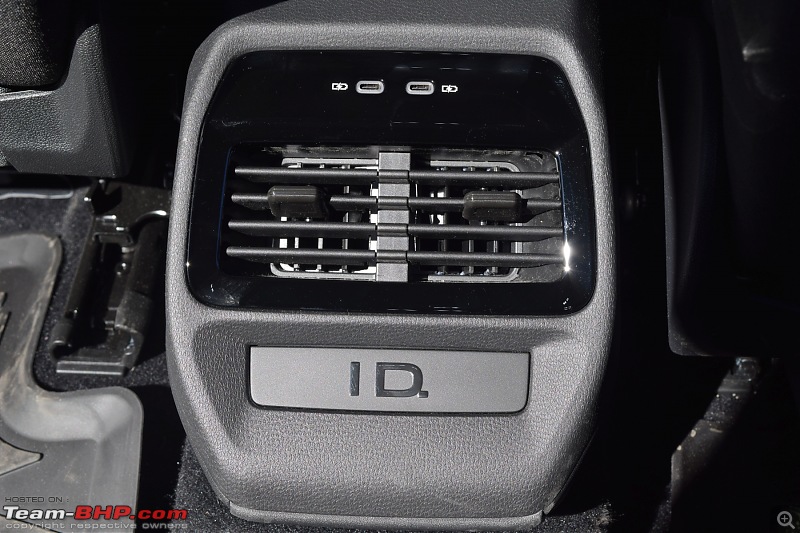 The reading lights at the rear are also touch-sensitive.  The BootThe boot opening is quite large. The boot has a very nice square shape. A parcel shelf is provided. 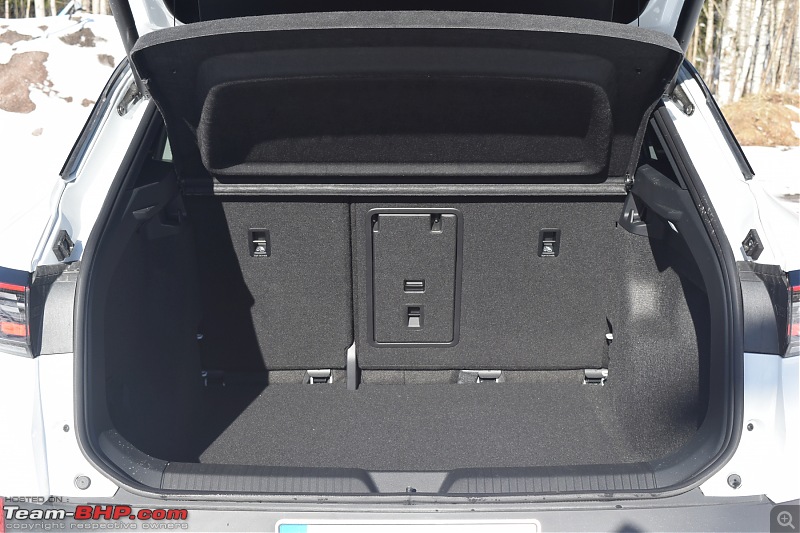 There is a noticeable boot lip, easily a few inches. There is an optional package available which adds a false floor, but my car doesn't have it. 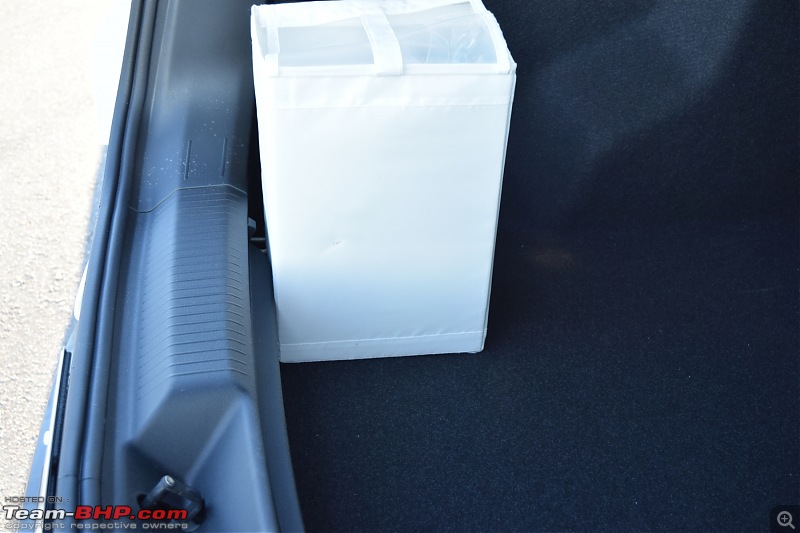 There is a bit of space behind the wheel wells. There is more space here than there was in the Karoq. But the Karoq had a plastic part connecting the rear edge of the wheel well to the inside edge of the boot, which meant this space could act as a nice pocket. I could store some stuff there and not have it move around in the boot. A fastening strap is provided here in the GTX, but it is not as practical as the Karoq. I guess adding the false floor as an option would have helped in this regard. 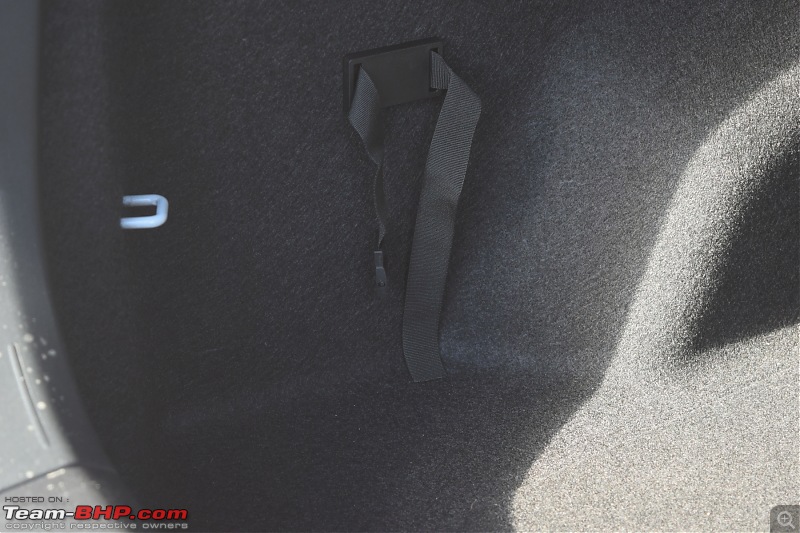 Talking of practicality, the Karoq also had some handy adjustable hooks in the boot. I could attach grocery bags to the hooks to prevent them from moving around, which is very important when buying eggs!! VW has made a half-hearted attempt at hooks in the GTX. What a pity! 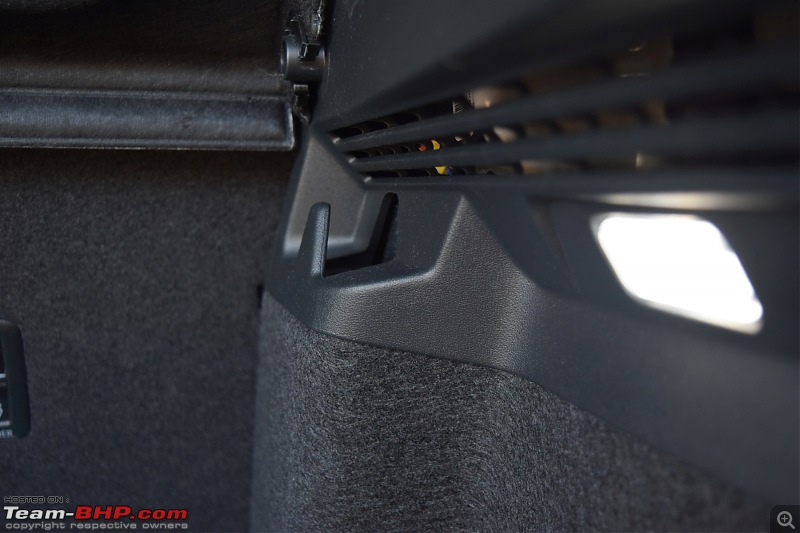 There is more storage space available under the floor. It can easily hold the charging cables and more. Interestingly, VW upgraded the Infotainment Plus package that I ordered a couple of months after I put in the order. Updated package includes an upgraded music system. It comes with a subwoofer that sits in this space, reducing its practicality. VW did not offer me the upgrade. 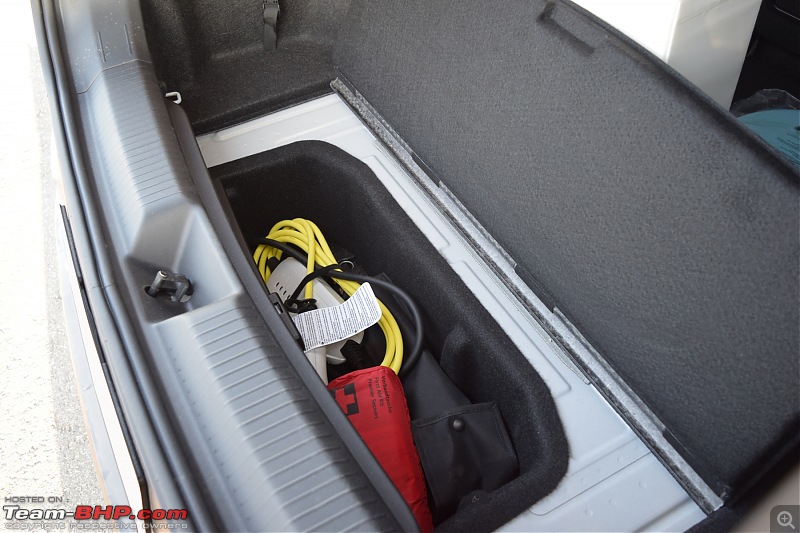 The boot volume is 543L. The claimed boot space in the Karoq was 521L, but visually, I can see quite a difference between the boot of the Karoq and the GTX. Perhaps Skoda was overestimating the boot size? The boot space with a couple of checked-in luggage size bags (Euro size, not US). 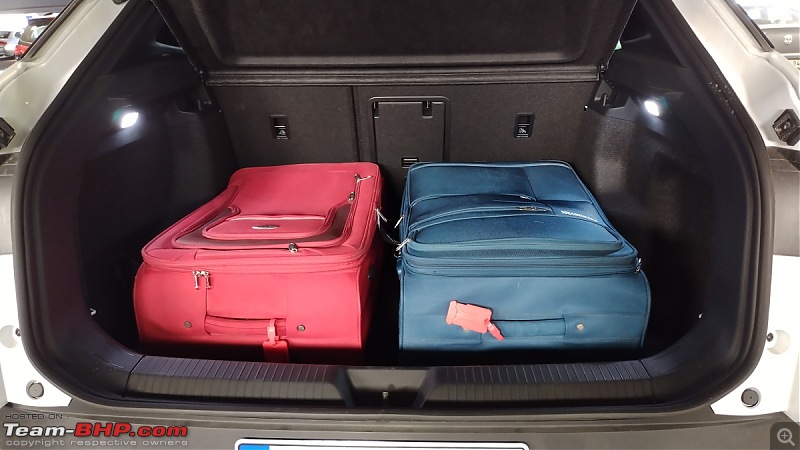 They can also be arranged on top each other. So the boot can take 4 such suitcases. I could not do this in the Karoq and get the boot door to close.  There is a 12v socket in the boot. By the way, there is no 12v socket at the front. 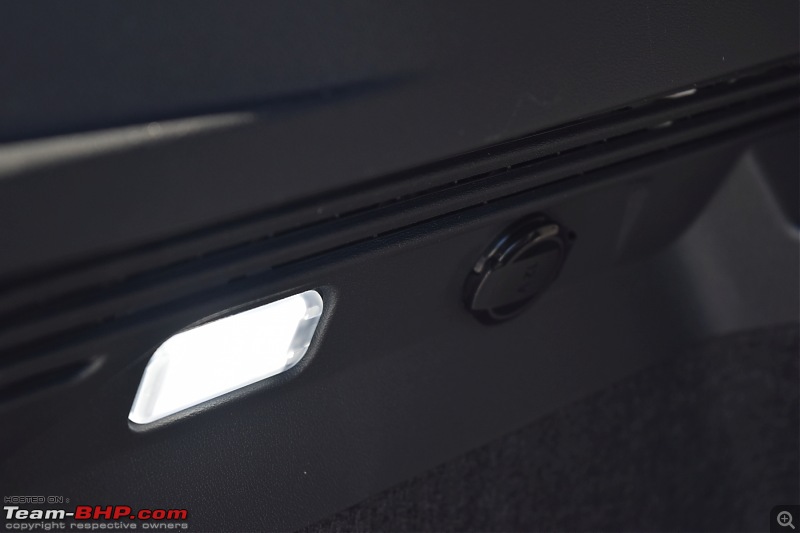 The seats fold 60:40. There is no lever in the boot to fold the rear seats down. There is a prominent step with the rear seats folded down.  The GTX has the Easy Open package, which brings a "virtual pedal" to open or close the boot. There is also an electric boot closure. The height to which the boot door opens can be adjusted. In the Karoq even accidental movement of the foot under the bumper used to initiate the closure of the boot. It happened a couple of times while getting stuff out of the boot when I was helping a friend move house. It was not fun standing under a closing boot while trying to get heavy or fragile items out. In the GTX, the boot does not close unless we move away from the bumper after waving the foot under it. If the key comes back in the range as the boot is closing, it stops closing and opens again. 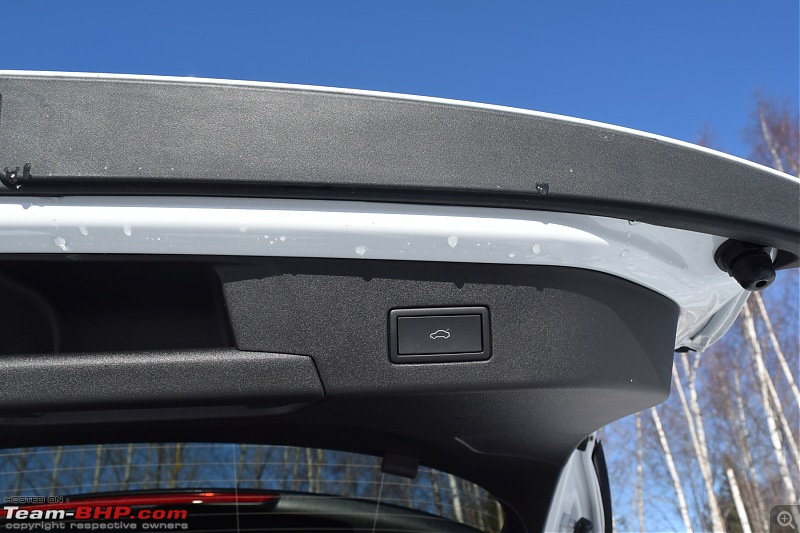 Last edited by StarrySky : 25th June 2023 at 12:01. |
| |  (12)
Thanks (12)
Thanks
|
| The following 12 BHPians Thank StarrySky for this useful post: | 14000rpm, carthick1000, Chrome6Boy, dailydriver, Gannu_1, GTO, InControl, lejhoom, sanjayrozario, sukiwa, thallipolivandi, vb-saan |
| | #8 |
| Senior - BHPian Join Date: Apr 2010 Location: EU - Nordic
Posts: 2,094
Thanked: 3,209 Times
| Infotainment System and Driver's Console Infotainment System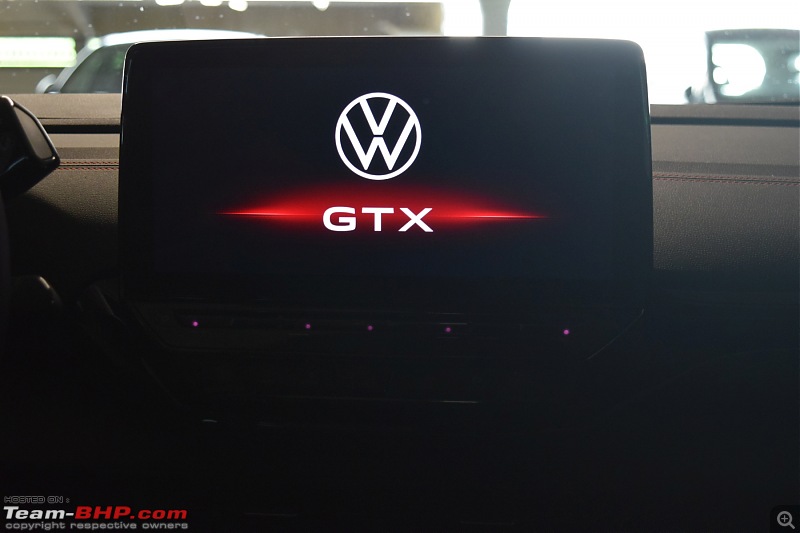 The 12" infotainment screen. The display is crisp and the icons are large, making them easier to select while driving. Note the sliders for temperature and volume control below the screen. There are also shortcut buttons for Parking Menu, Climate, Driving Modes and ADAS features. It's not possible to dynamically assign these shortcuts to other functions. There are more settings on a second page. There is also gesture control. Waving the palm above the slider buttons works to go forward/back (reliably, most of the time). 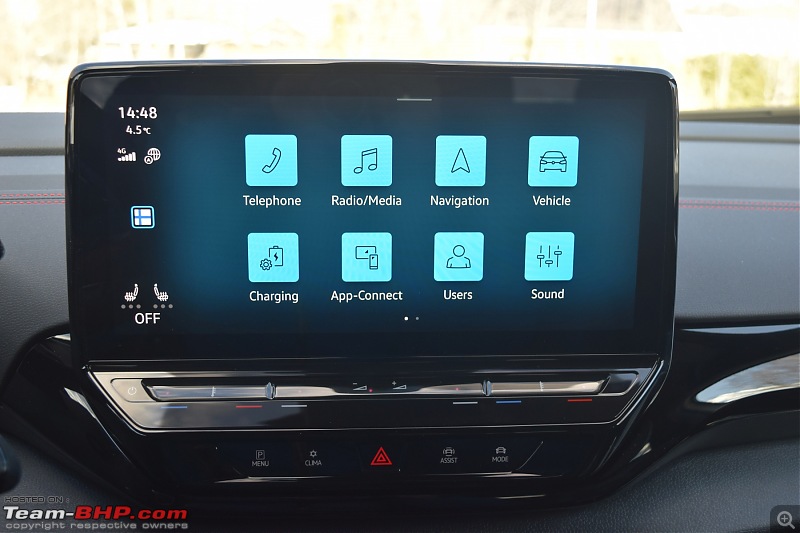 Unfortunately, the slider controls are not backlit. But the shortcut buttons for climate, etc are. Also note that Android Auto is connected in this picture. Wireless Android Auto and Apple CarPlay are supported. 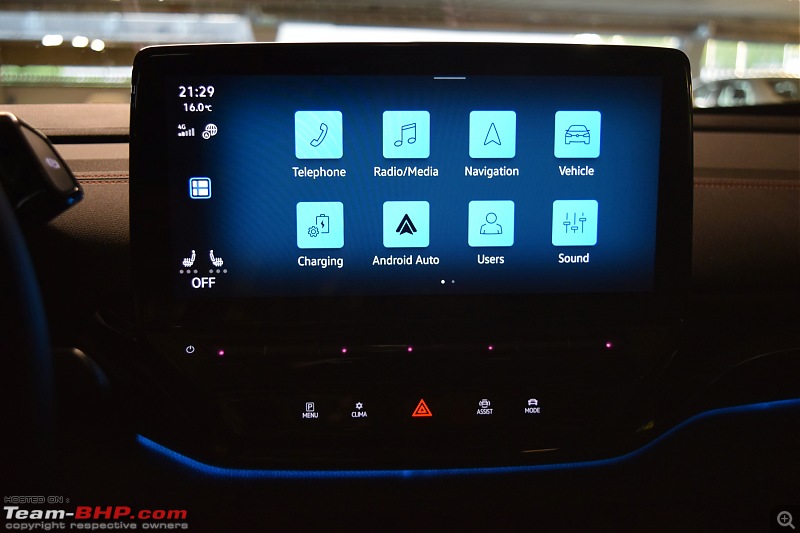 It is also possible to have a split screen setup. There are again two different split-screen setups.  By pressing and holding any of the tiles on screen, we can bring up an edit screen which lets us configure what we want to see on screen.  The classic climate control screen. The temperature can be adjusted without going to this screen by using the slider controls. The seat heating can also be enabled/disabled by tapping on the same area with two fingers. For the steering wheel heating, I would've preferred a dedicated button on the steering wheel. 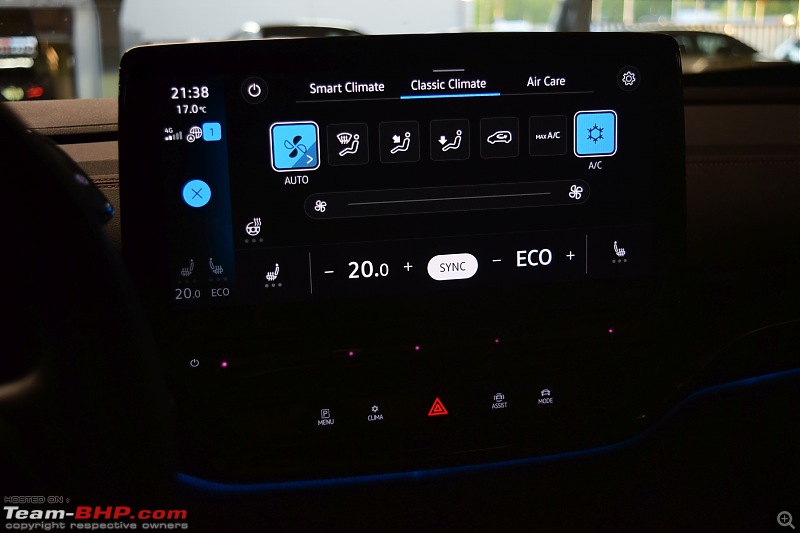 There is also a Smart Climate screen. Windscreen heating can also be started from here instead of the panel to the left of the steering wheel. The Air Care mode includes an allergen filter. 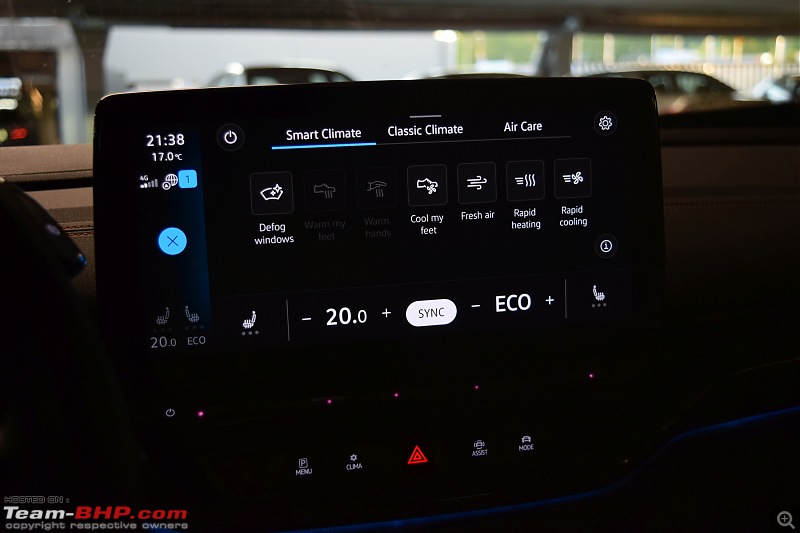 From the Vehicle menu, we can access the driving data: 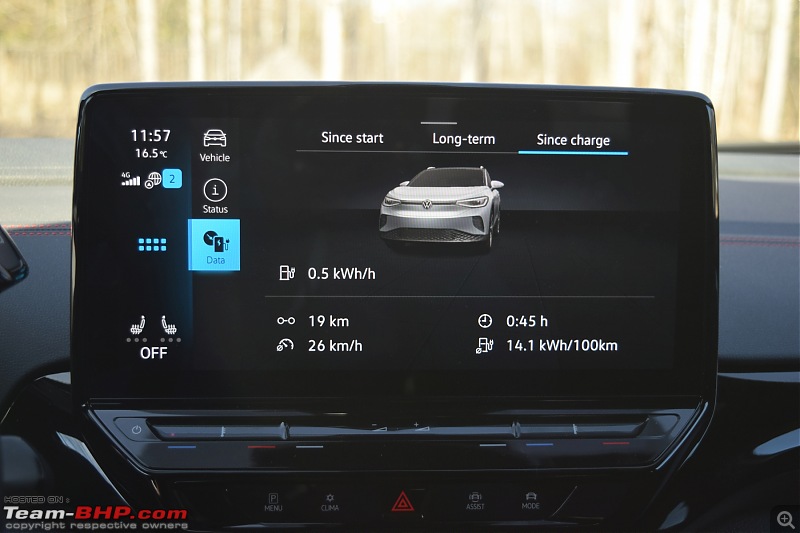 The different Interior/Exterior settings can also be adjusted from the Vehicle menu. Note that the car shown in the infotainment system is not in the actual car colour and it is not even the correct car (GTX). Stunning lack of attention to detail. 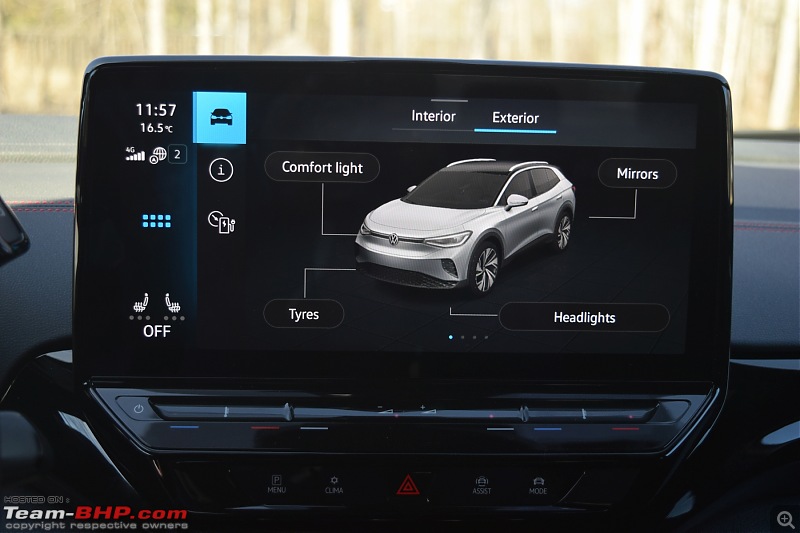 The GTX is WiFi-enabled. The car can connect to home WiFi and it can also act as a WiFi hotspot. From the manual I understand that the software downloads are done via the e-SIM card on the car. It would've been better if the car could connect to home WiFi to download software. As an apartment dweller, I can't get the car to connect to home WiFi reliably. So this isn't a big miss for me. 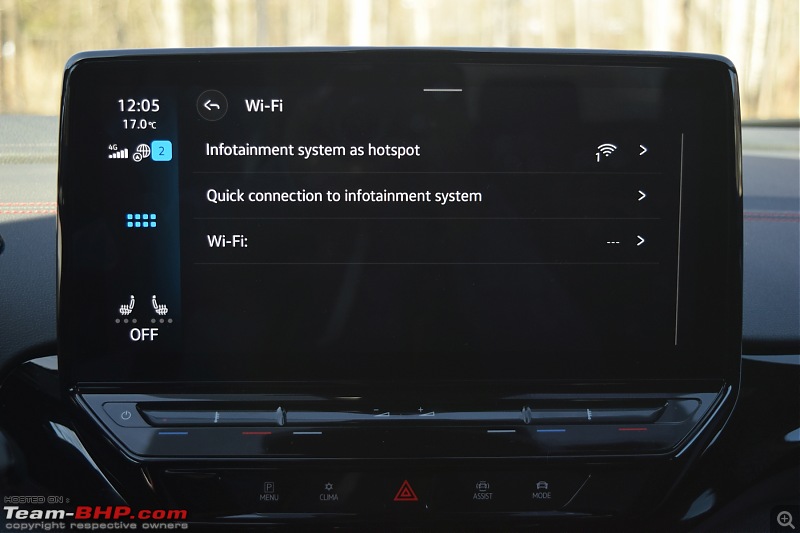 The GTX also supports voice controls. The function can be accessed via a wake word or by the dedicated button on the steering wheel. I have tried it a few times, and then switched it off. It sometimes mistakes normal conversation for the wake word and gets ready to receive commands. It can understand basic commands. However, more complicated natural language queries are not really supported. There is an online mode for the voice control, which can interpret the voice commands by communicating with a server. Once I asked, "How long can I go before I need to charge?". It didn't really answer how many kilometres of range I have, but took me to the vehicle data page displaying the range. So that's where the software is now. One cool thing I have noticed is that the system knows if the driver or front passenger is speaking to it. So if I, as the driver, ask the system to increase the temperature by 2 degrees, it updates the temperature only on the driver's side. When I say the wake word as the driver, the ID.Light also responds by blinking only on the driver's side. I haven't tried it with rear passengers, but my car has only 2-zone climate control. It may work to control the rear AC temperature for ID.4 variants with 3-zone climate control. 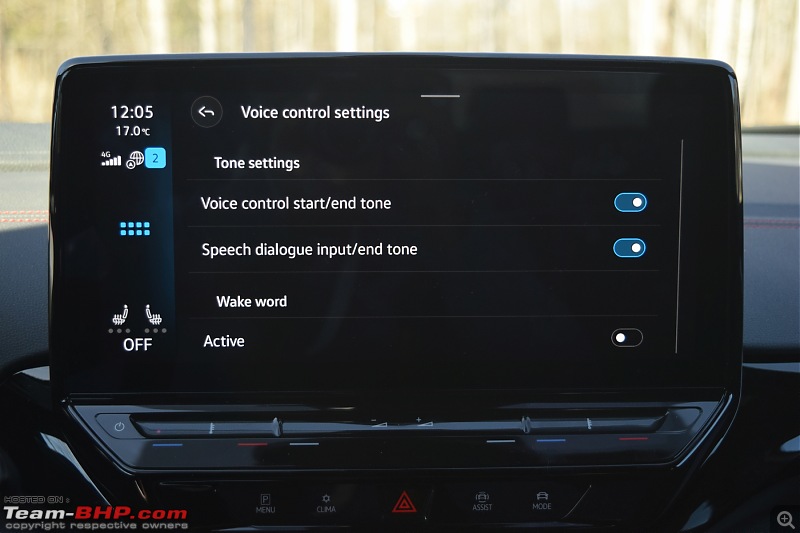 Sound settings. I have to admit, I haven't really changed anything here. I find that these days, quite often, I have no music playing during my trips. It's got nothing to do with the quality of the sound system. I guess I probably enjoy the reduced interior noise levels compared to my previous car. 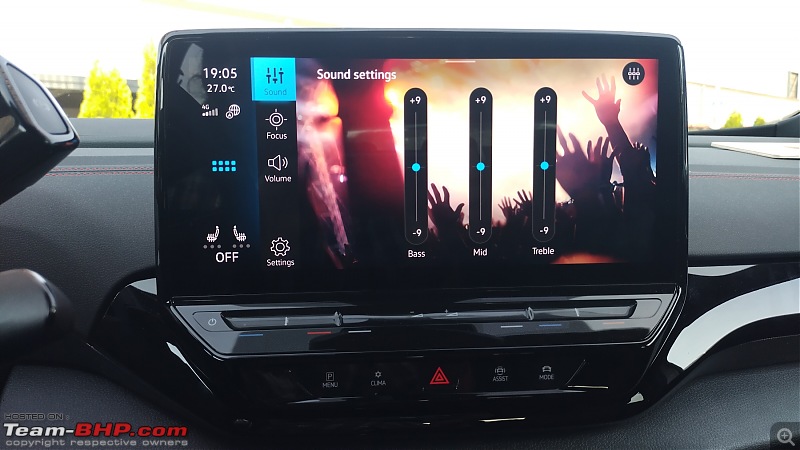 Ambient light settings. 30 different colours are available. Different colours can be chosen for the dashboard and other areas. There are also some preset colours for different themes. It can also be set to Auto so that the lighting changes with the different driving profiles. This is another setting I don't bother with. I have set it to a shade of blue for both areas.  Stationary air conditioning settings menu. This function can be used, for eg:, in winter to air condition the car and heat the windscreen and seats before departure. It can be selected if we need to heat both front seats or the driver's seat only. This feature can also be used to keep the AC on for 30 minutes once we are parked at the end of a trip. This means we can keep the AC running while we run some quick errands and get back to the car. It has been quite hot (by Finnish standards) lately, and I have used this feature a couple of times already. 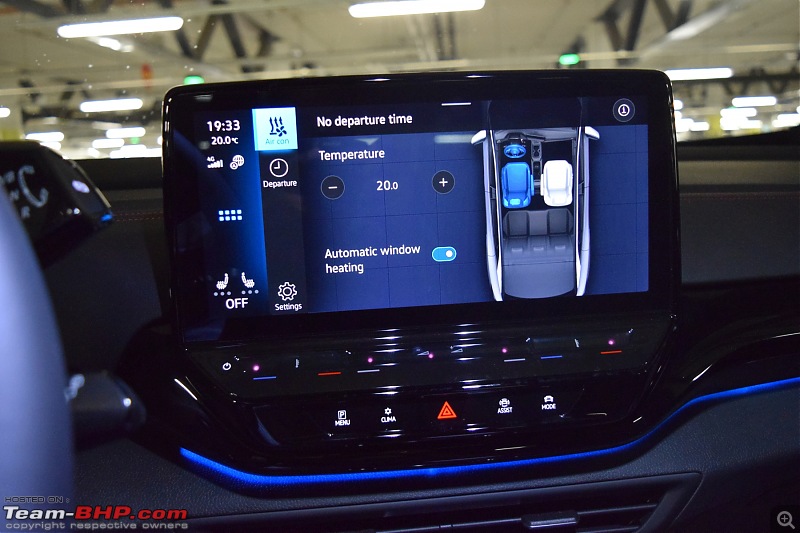 The ID.Shop. Interestingly, even though I have set the Infotainment system language to English, the Shop always shows up in the language of the country where the car is registered, I guess for legal reasons. There is nothing much to see here now, except the Travel Assist with Swarm Data feature, which I have now enabled in my car. It is free for 3 years. 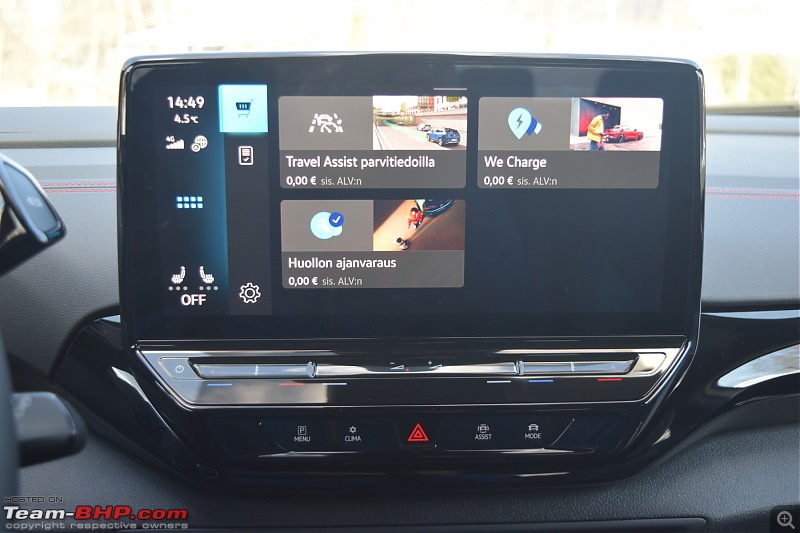 Driver's ConsoleAs I had mentioned earlier, the driver's console is attached to the steering column and moves with it. It is not the largest display around, but it is still quite functional. Minimal information is displayed when the car is turned off.  Once the car is on, the it displays all the relevant information. The icon on the top-left, that looks like a road, indicates the driving profile that is enabled. In this picture, the car is in Comfort mode. ADAS systems display is on the left of the console and driving data is on the right.  Using the VIEW button and the arrows either side of it on the right side spoke of the steering wheel, different screens can be chosen on the driver's display. Press on the right side of the button for driving data display settings and on the left for navigation display settings. Swiping from left to right or right to left over the VIEW button can also be used to do the same. 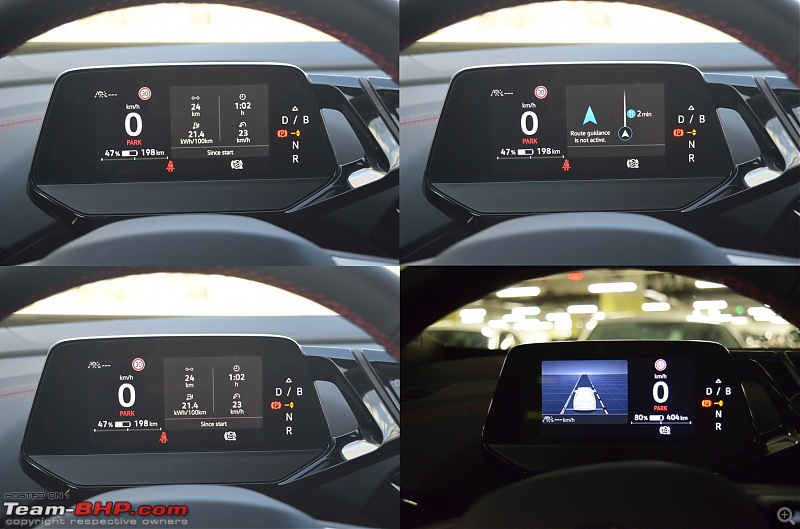 When we start driving, two bars coloured blue and green appear below the range display. Blue denotes power and green denotes regen. When full power is available, the blue bar appears full. When maximum regen is available, the green bar appears full. 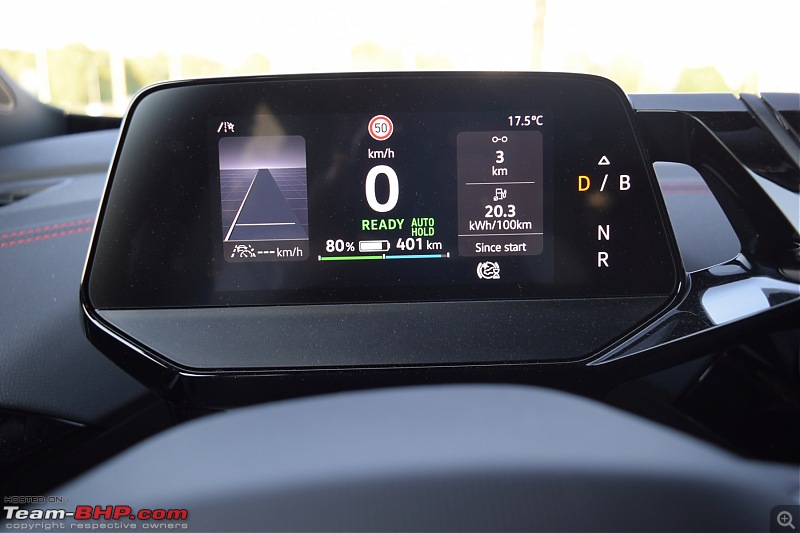 When power is applied, another blue bar is overlayed on top of the blue bar which shows how much power is applied.  When regen is applied, a second green bar is overlayed on top of the first which shows how much regen is being applied.  |
| |  (13)
Thanks (13)
Thanks
|
| The following 13 BHPians Thank StarrySky for this useful post: | 14000rpm, AYP, carthick1000, Chrome6Boy, dailydriver, Gannu_1, GTO, InControl, NitNac, ph03n!x, sanjayrozario, sukiwa, thallipolivandi |
| | #9 |
| Senior - BHPian Join Date: Apr 2010 Location: EU - Nordic
Posts: 2,094
Thanked: 3,209 Times
| Features FeaturesThe GTX, even in the middle variant, is quite feature-rich. I will highlight a few of them. Travel Assist: Travel Assist is a combination of adaptive cruise control and lane assist features. Travel Assist can be selected using the dedicated button on the left side spoke of the steering wheel. 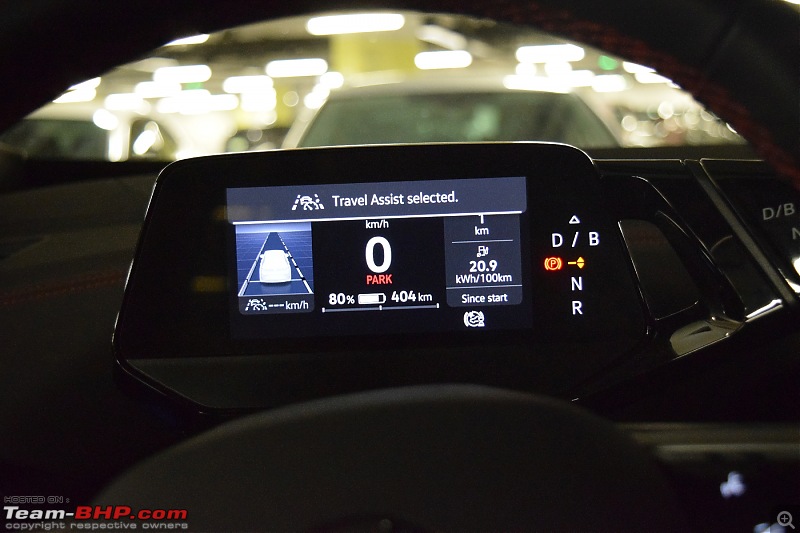 In case we don't like to use the Travel Assist, we can use the MODE button to switch to other systems - adaptive cruise control or speed limiter. Speed limiter is basically non-adaptive cruise control. 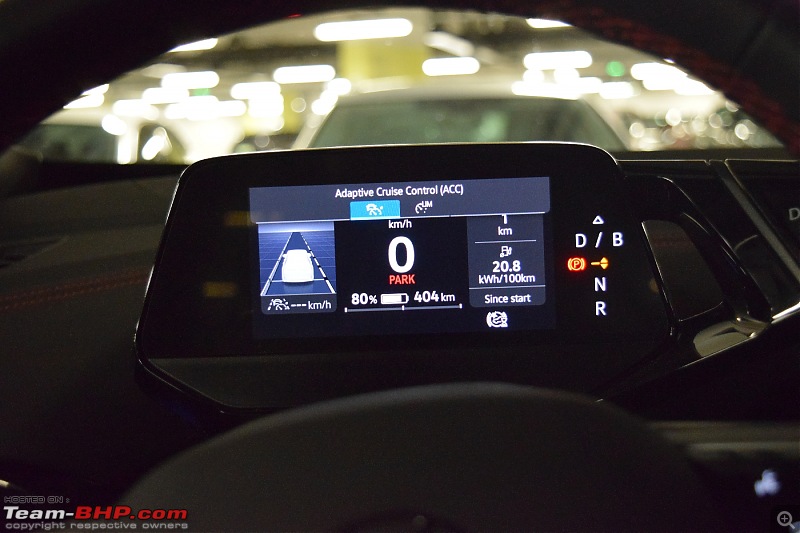 I have had adaptive cruise control in my earlier cars, but in the GTX, the system can also use navigation data or read road signs to adjust the speed. VW calls it predictive cruise control. This is possible even with the speed limiter function. With adaptive cruise control, the predictive function can also react to bends, roundabouts, etc. and adjust speed to safely navigate them. Any speed reduction by the system uses regen for as long as possible. 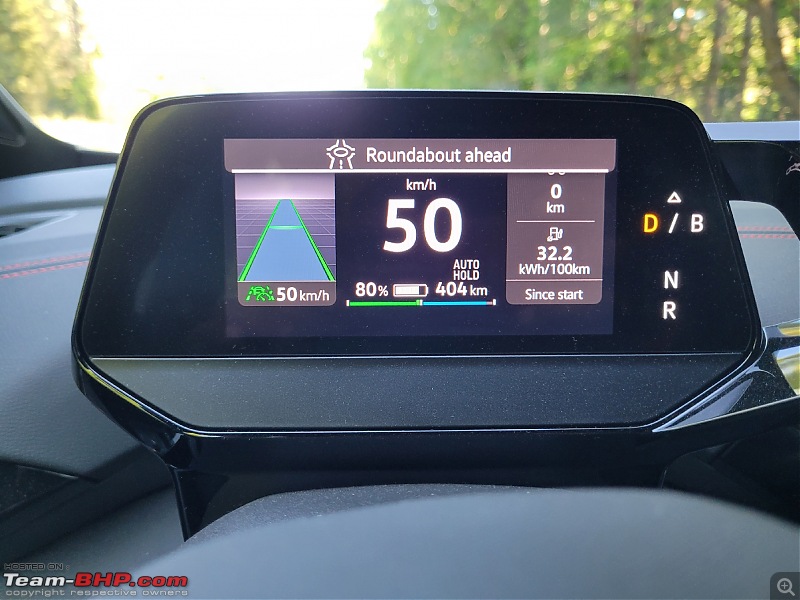 Another reason why the ACC in the GTX is better than the one I had in the Karoq is that in the GTX, it can also detect stationary vehicles. Driving on the highway with Travel Assist and predictive cruise control enabled is a breeze. I have made only one long highway trip in the GTX so far, with speed limits switching between 100, 80, 60 and lower speeds, and I rarely accelerated or braked myself. The GTX also has a capacitive steering wheel. So our hands only need to be holding on the steering wheel. I don't have to put some torque into the steering occasionally like I had to in the Karoq. In fact, on our return journey in the afternoon, this level of convenience combined with some tiredness after a small trail walk almost put me to sleep. I had to take the car off adaptive cruise and drive myself to keep myself awake. After I ordered the car, VW upgraded the Travel Assist to include assisted lane change operations. This requires extra sensors and it cannot be enabled in my car with just software. Updated Travel Assist is also called "Travel Assist with Swarm Data", as it can use data from the cloud. Now, this is a pure software function and I have enabled it in my car from the ID.Shop. This is currently free for 3 years. This is how I understand how this system works. The system collects anonymous data on where a vehicle is placed on the road w.r.t static elements on the road. When it has enough data from multiple cars passing through the same road, the system is then able to keep the car "in lane" even if the lane markings are not visible. In the picture above, the Travel Assist is enabled and you can see the lane boundaries are marked with solid green lines on either side. This is when the system can actually detect the lane boundaries. When swarm data is used, small green triangle shapes form a dotted line instead of the solid line. I have seen it appear once or twice. The system is not perfect. The first issue is with the speed limit information in the navigation data itself. The main road near my home has an 80 km/h limit, but the data says 120 km/h. Thankfully, there is an 80 km/h speed limit sign posted where I normally merge onto the main road, so I don't usually face an issue. But there are other places where we can merge on to the same road, but the speed limit signs are not close by. There, the system tries to accelerate to 120 km/h. This road has not had a 120 km/h limit in the last 5-6 years at least. I noticed this same issue more than 2 years ago when I was test driving the Enyaq on the same road! VAG seems to be really slow to update navigation data. I encounter the second issue every time on a road that I take quite frequently, where the limit is 80 km/h and there are two lanes. At some point, the two lanes split into two different roads - one lane continues straight on towards a residential area with a 50 km/h limit. I usually stay on the other lane, which continues to join a main road. There is a 50 km/h speed limit sign for the other road posted just after the two lanes split into two roads. And every time approach this place, the predictive function slows the car down to 50 km/h. I am not quite sure if the navigation data is wrong or if the system is not able to accurately determine which lane I am in. I have this doubt because sometimes when I am using the navigation, the system tells me to "Move over one lane to the left/right" to be in the correct lane for my route, when I am already in the correct lane. Some have complained that the lane assistant is too obtrusive, but I don't feel so. However, if we use it in certain situations, we need to be more careful. For eg: near my home is a narrow road with a few turns. It has a curb on one side. When I am on this road, quite often the lane assist system tries to pull me towards the curb if I get too close to the centre lane markings. This feels a bit unnerving as the curb is also close. We just need to be aware of such scenarios, where lane assist will have some trouble. The ADAS feature settings screen. We can bring it up either from the menu on the screen or the dedicated shortcut button. Touching any of the highlighted areas brings up a submenu for it. We can also go to further settings by clicking on the hamburger button.  For eg: clicking on the blue car ahead brings up ACC settings: 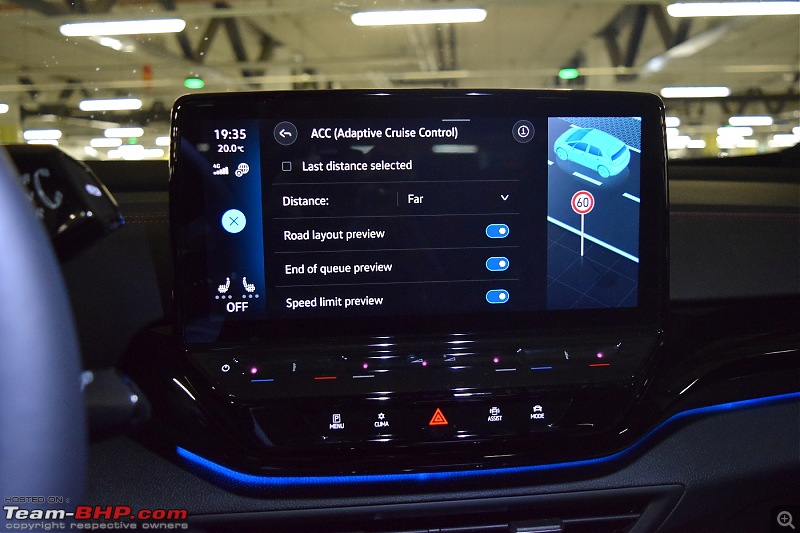 HUD with Augmented Reality Functions: This is not a standard feature, and is part of the Infotainment Plus package that I ordered. The HUD can display ADAS data, speed data and navigation data. HUD settings can be adjusted from the infotainment system. The placement of the HUD can be adjusted by the up/down arrows. The angle can be adjusted using the curved arrows at both ends. 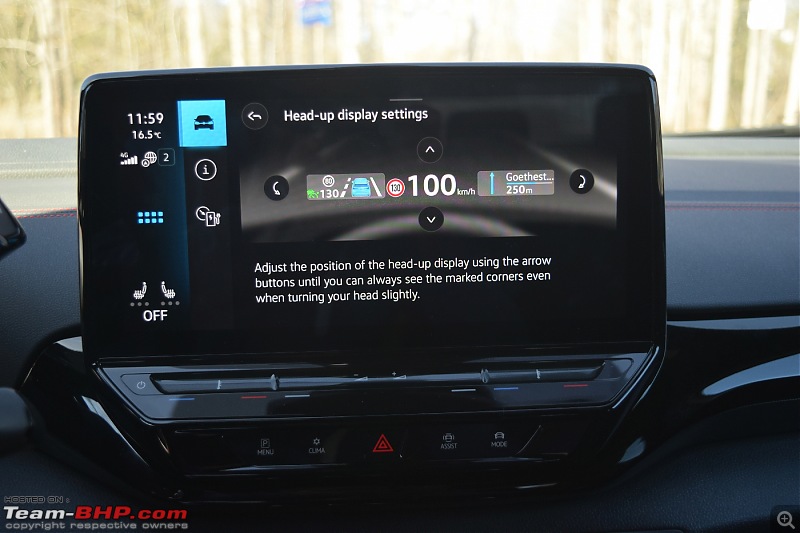 Since it is quite difficult to photograph it while on the move, here is a low-quality screen grab from a video I shot. We can also see the big blue arrow, which forms the AR part. 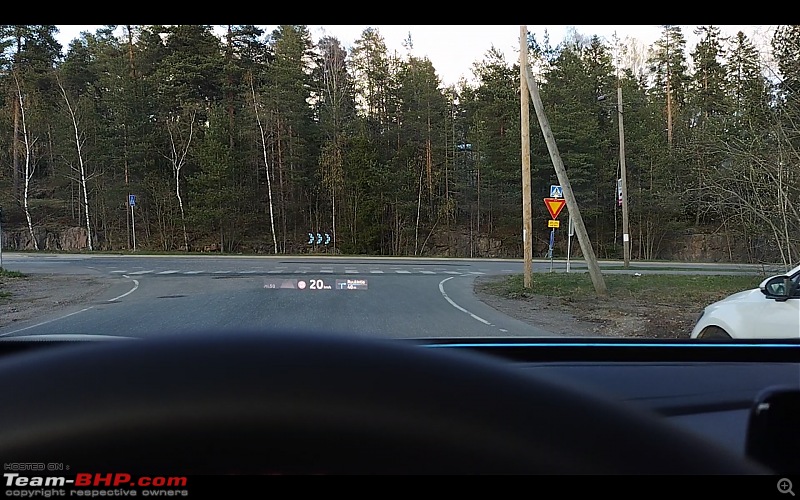 I have found the main HUD display pretty clear to read in bright light. That is unless it is projected onto a white surface like a white car ahead. There is also a winter mode for the HUD which gives it a bluish tinge. The AR arrows are more difficult to see during the day. I have found that the HUD takes some getting used to, and I haven't really gotten used to it yet. I don't mean that I find it distracting. But, for eg:, while navigating I still find myself looking at the screen and not at the HUD. I have even missed a couple of turns, looking at the screen for directions instead of the HUD which shows the directions right in front of my eyes! Matrix LED Headlights: I am super-impressed with the matrix LED lights. The main beam is turned on based on location, speed, road lighting etc. I initially didn't get a chance to check them out due to relatively long days and street lighting everywhere. Then one night, when we were just driving around after dinner, we came up to about a 1-km stretch on a particular road without any street lights and I could see them at work. Here, again, are some screengrabs from a video we shot. With main beam off and on:  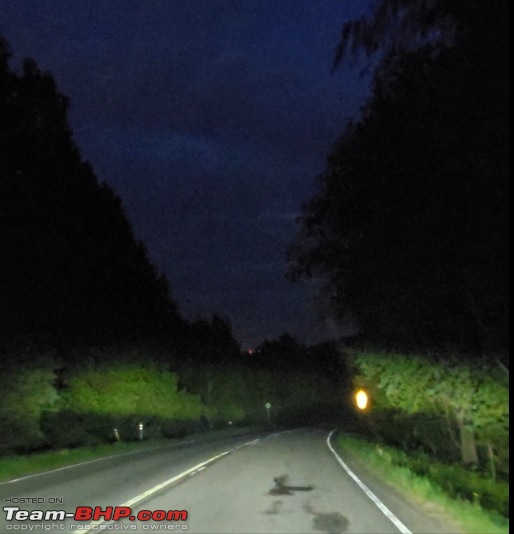 This is what it looks like when there is another vehicle approaching. The beams pointing towards the other car are reduced in intensity in the second picture. 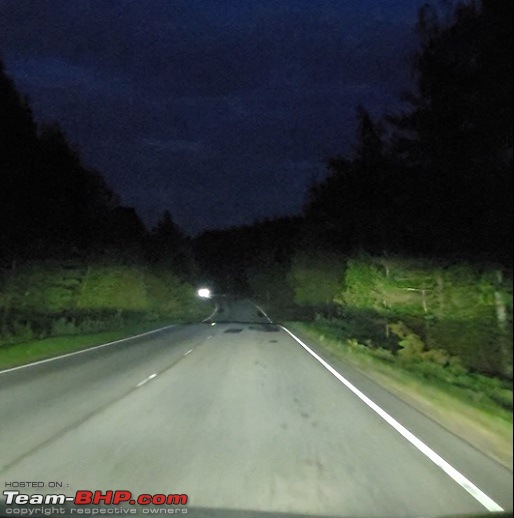  The beams are constantly adjusted, and we can still recognize a black patch when the other car is close.  When following another car, there is a black patch right behind it. 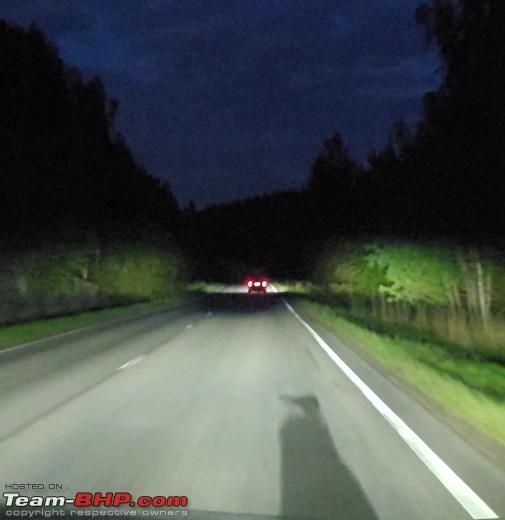 When we get even closer, the patch is no longer clearly visible and it looks like our lights are enough even for the car in front to see both sides of the road clearly. 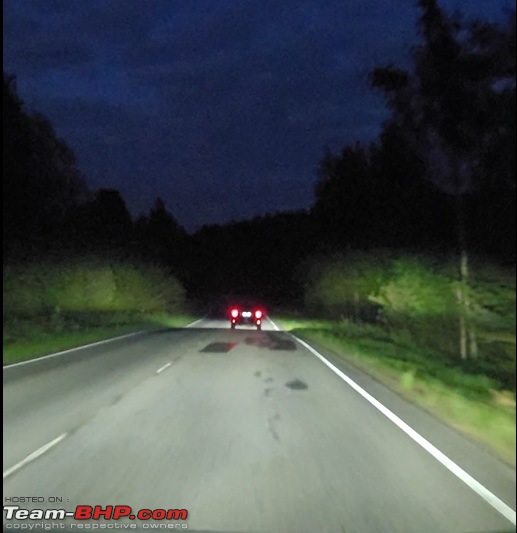 My friend was in the other car in all these pictures and he confirmed to me that from his car he didn't have any issues with the lights on the GTX in any case. Eco Assist: The Eco Assist works in D driving mode, when the cruise control functions are turned off. This feature enables automatic regen. It can use speed limit data and route data to "anticipate" the need to slow down and prompt the driver via icons on the driver's console, HUD and flashing of the ID.Light. In the picture below, the system knows a roundabout is coming up and the driver is asked to take the foot off the A-pedal. Using regen, the car then slows down to the appropriate speed. I will say more about this feature later in this report, in the driving impressions part. 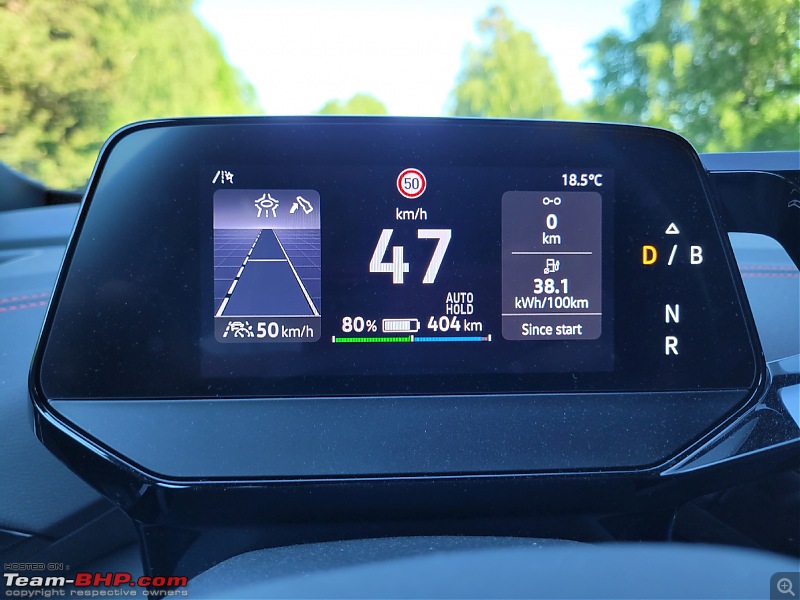 ID.Light: The ID.Light sits just under the front windscreen. It is a multi-coloured light and it can flash or swipe across to provide various information, warnings, etc. The most commonly seen is during navigation when it swipes twice in the direction of a turn that is coming up. It can also flash while receiving a call, it can flash red if we get too close to a car in front and need to brake or if our hands are off the steering wheel for too long, etc. It can also be displayed in green when charging is ongoing. I think of the ID.Light as a gimmick by VW to give a unique feature for the ID models. It's not a massive value addition to the car in my opinion. In the picture with the HUD above, we can also see the ID.Light as it is swiping right. This is perhaps the most useful function of the ID.Light. Here is a picture of it while charging is ongoing. There is a static part and a dynamic part for the ID.Light in this case. I guess the static part corresponds to the current SOC. 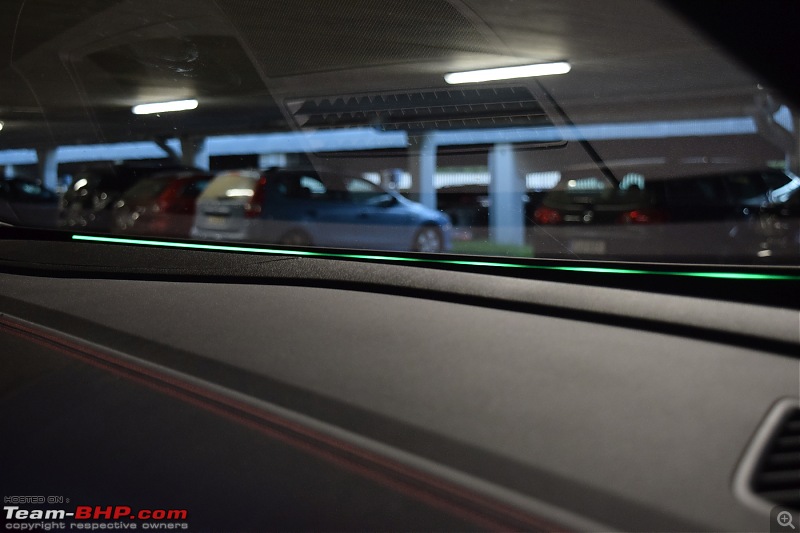 Dynamic Chassis Control (DCC): I ordered the DCC (Sports Plus Package) and I have to say it really makes a difference. The DCC setting can be a range of values. There is clearly a difference between the Comfort and the Sport settings. It can really be felt even on normal tarmac roads. The Sport setting is clearly stiff and we can feel the extra harshness. I have left it more on the comfort side, more often than not. In this setting, I feel it rides better than the Karoq I had earlier. The Sport setting, on the other hand, offers a harsher ride than in the Karoq.  360-degree Camera: This is the first car with a 360-degree camera system that I have had. Other than the rear view camera, I find myself using the side cameras quite a bit, but I don't use the front camera very much. The field of view is OK. The screen is big and bright, so this helps a lot. I think the quality of the cameras is also acceptable, and I don't have any complaints. The view from the side camera. Touching specific areas around the car icon on the left side brings up the view from the camera in that area on the main display. 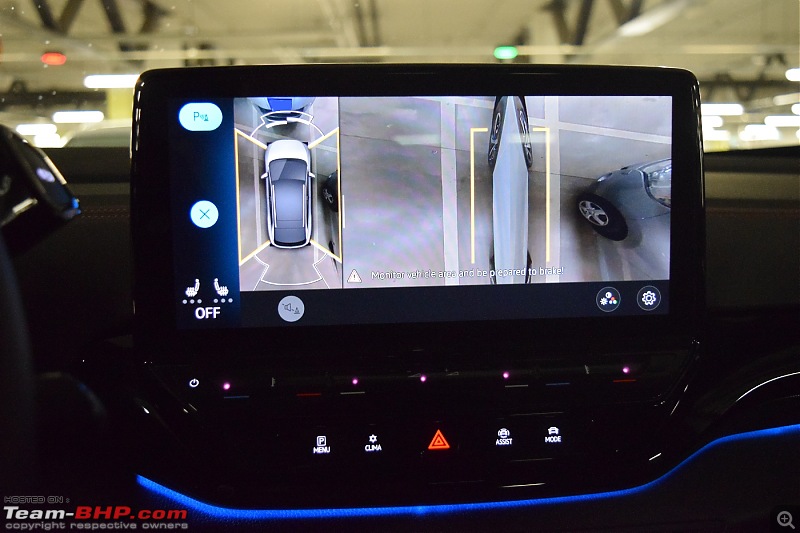 The perpendicular parking mode and cross-traffic mode are supported. The cross-traffic mode provides a wider field of view. 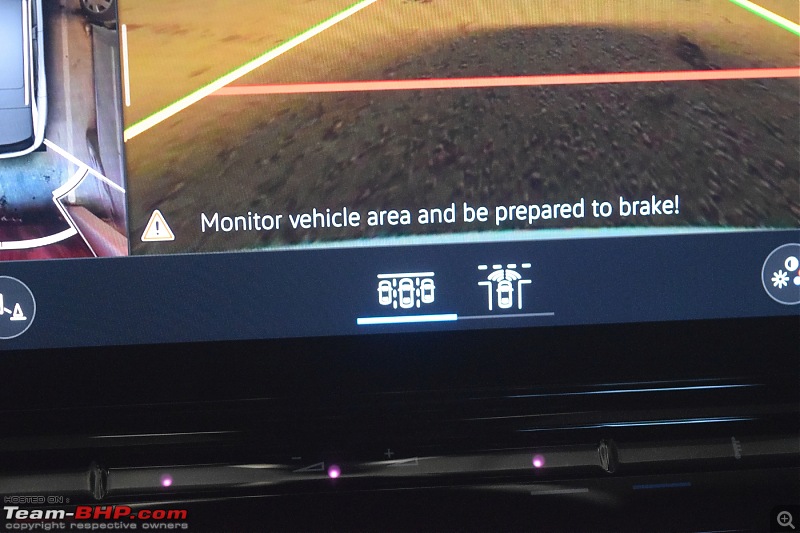 Car2X Communication: The GTX includes Car2X communication capabilities in Finland. This means that the car can anonymously communicate directly with other cars or elements on the road that support the same technology to send and receive various data. For eg: a broken down car on the side of the road can communicate this information to our car, enabling us to slow down in advance. Emergency vehicles can communicate with our car, so that we can get ready to give way. I have enabled it in my car, but have never seen it in action. If you are interested, you can read more about this technology here. |
| |  (17)
Thanks (17)
Thanks
|
| The following 17 BHPians Thank StarrySky for this useful post: | 14000rpm, AYP, carthick1000, Chrome6Boy, dailydriver, Gannu_1, GTO, InControl, MotorDev, Omkar, ph03n!x, sanjayrozario, shyampsunder, sukiwa, Tgo, thallipolivandi, vb-saan |
| | #10 |
| Senior - BHPian Join Date: Apr 2010 Location: EU - Nordic
Posts: 2,094
Thanked: 3,209 Times
| Living With The GTX Living with the GTXBefore we get going: The GTX has a motor each on the front and rear axles. The one in the rear is shared with the RWD models and puts out 204HP and 310Nm. The one in the front puts out 109HP and 162Nm. The combined figures are 299HP and 460Nm. However, the peak power is available only for 30s when the battery has at least 88% SOC and is at optimal temperature (between 23 and 50 degrees Celcius). Practically, this means I have almost never had full power since I usually charge it only up to 80%. However, there is still enough poke. A few days ago, I tried accelerating from about 10km/h to 50km/h with the SOC around 35% in Sport mode. It was enough to push us back to our seats. Accelerating up to highway speeds before merging onto the highway has become more fun. My son particularly likes it. However, the GTX still has lower power and torque figures compared to competitors like the Korean twins, Mach-E or Model Y. So the expectations need to be tempered. The front motor is engaged only when required, and most of the time the GTX is powered only by the rear motor. The ground clearance of the GTX is stated to be 163cm. This is about the same as in the Karoq, so it would seem nothing much has changed in terms of ingress/egress. But then, more than in the Karoq, this really depends on your driving position, which I will now come to. Finding a good driving position took me some time. The steering is adjustable for rake and reach, and the driver's seat is height adjustable. But the range of seat height adjustment is less, and the seats are not very high off the floor. If I sit closer to the steering wheel, the seat needs to be set high to prevent the knees from pointing upward. Exiting then becomes a little more difficult. If the seat is in the highest position and further back, reaching the pedals becomes an issue. So sitting slightly lower and pushing the seat backward is the compromise I have found. Ideally, I would've preferred to sit slightly higher. In terms of driving, I have gotten used to this position. But sitting in this position, I have to lean forward to reach the touch screen. Not the best thing, when most of the functions need to be done through it. The seats are quite comfortable. The seats are wider than in the Karoq, but on the flip side, they are not as body-hugging as in the Karoq. I don't have the optional sports seats, and I suspect they would've been more body-hugging. Seats have only seat height and backrest angle adjustments. The side edges of the seat are finished in leatherette. This takes much longer than the rest of the seat (which is fabric) to warm up when seat heating is used. I am not a fan. I have enabled the starting of the AC as soon as the car is unlocked. This is a welcome feature, as the infotainment system takes some time to get initialized. The GTX has a heatpump system. It is quite audible, and we can hear its hum as we approach the car. Starting Off and NVH: Once we are settled in, depressing the brake pedal brings the car to life. Shift to D/B/R and we are ready to move. There is no need to specifically switch on the car. Similarly, at the end of the trip, we can just put the car to Park and exit. The car turns off by itself. At parking speeds, the car is very quiet. By law, the car needs to produce the "e-Sound" at slow speeds to warn pedestrians. It is not very audible inside. Once we start moving and pick up some speed, the tire noise becomes prominent. There is an optional package available that includes acoustic front windscreen and windows, but I don't have it in my car. Is it quieter than the Karoq? The engine noise is missing, of course, and that makes a difference. But in terms of the tire noise, I'm not completely sure. Another thing that doesn't help the GTX's case is fatter and lower profile tires (235/50 R20 at the front and 255/45 R20 at the rear). At higher speeds, there is also a bit of wind noise, although it is not very audible above the tire noise. I guess it depends on the wind direction as well. Having said that, there is no motor whine heard from the rear motor, at least in the front seats. When I am accelerating hard, I can hear a faint whine from the front motor. As I mentioned earlier, this is not the fastest EV among its closest competitors. However, one will not be left wanting for power in everyday situations. Although I am not a fan of traffic lights GPs, I have found that it's quite easy to leave behind most other cars without trying hard. On the whole, the pickup is very linear. The car masks the speed very well and there is no change in noise while accelerating. In the city therefore, I have to be extra vigilant, as it's all too easy to go above the speed limit. We have done only one longish journey with the car so far, a round trip of about 220km. At higher speeds, the car feels solid and highway speeds feel pedestrian from inside the car (nothing surprising here for a German car). I travelled with the whole family, and none of us had any comfort issues during the trip. Ride and Handling: I am not a fast driver, and for my usage, there is nothing to complain about in the handling department. VW claims the GTX is a "cornering specialist", but I haven't really pushed it in any corners. My handling "tests" are not about high-speed corner-carving. But there are a few places in my usual routes where I can attempt to go just a little bit faster but at still sane speeds, around a tight roundabout or a tight turn for eg.: and for that, the GTX is more than adequate even in Comfort mode, where it is primarily RWD. The steering is on the chunkier side and feels nice to hold. It is weighted very well for my preference. I prefer a slightly heavier steering. At parking speeds, the steering is light enough for me. At highway speeds, it weighs up nicely and provides a sense of security. The Sports Plus package I have includes progressive steering, which can dynamically alter the steering ratio to make it more direct. The steering is communicative enough, and I don't feel disconnected from the wheels. The ride is also comfortable, no doubt, helped by the DCC. In the comfort setting of the DCC, the ride is good at all speeds. The GTX has passed my wife's motion sickness test with flying colours in Comfort setting. I changed the DCC setting from Comfort to Sport on the fly, and she immediately said, "What's happened now? It's not comfortable anymore." I said I was experimenting with some settings, and she made her choice clear: "I don't like this. Can we go back to the earlier setting?" Drive Modes: VW has provided D and B driving modes in the GTX (and other MEB cars). In D mode, the car basically coasts when we lift our foot off the throttle. B mode, on the other hand, applies regen braking. VW has published a long article on why, according to them, it is more efficient to coast. What I feel is that moving from an ICE car, I felt immediately at home in the GTX in D mode. Get off the throttle anticipating the need to slow down/stop, and apply the brakes when needed. This feels more natural than harsh regen braking each time one gets off the A-pedal, then applying more throttle etc. Thankfully, VW has blended regen braking with manual braking action. So even when we brake, regen is applied, and the brakes are physically engaged only if we demand more braking power than what regen can provide. Typically, when we come to a complete stop, the final part of the braking is done via the friction brakes. I have to say that VW has absolutely nailed the transition from regen braking to friction braking. From the pedal feel, it is imperceptible when regen stops and actual brakes take over. Although in D mode the car coasts, VW has also provided the EcoAssist feature. This is an auto regen mode and it works only in D mode. So, for eg., if there is a car in front, the GTX can use regen to keep a safe distance from it. This is not adaptive cruise, and the car doesn't pick up speed if the car in front then speeds up. Or for eg:, if we are approaching a roundabout or a slower speed limit zone, the car prompts us via an icon on the driver's display, HUD and flashing of the ID.light to take the foot off the A-pedal. The car then uses regen to slow down to the appropriate speed by the time we reach the roundabout or lower speed limit area. Anticipatory driving is essential for efficient EV driving, and this feature makes it easy. If I am going from a 50 to a 30-zone, I am at exactly 30/31 when I am passing the speed limit sign on the side of the road. I am impressed! With this feature, I don't need to figure out when to switch to B mode or how to use regen. I think this will also help drivers who switch from ICE to EV to immediately achieve good efficiency, without really changing their driving style. However, if we are always slowing down "naturally" by coasting in D mode, then I guess the regen is also minimal. In B mode, the car applies regen as soon as we take the foot off the accelerator. However, having driven a few other EVs lately, the regen is not as strong in the GTX as in other cars. If something like a Model Y or Volvo C40 is like hitting a wall with the regen braking, this is more like crashing against some bushes. VW says there is 0.15g of regen in B mode, whereas by physically applying the brakes, the regen is up to 0.3g. I believe the 0.3g of regen is close to what competitor EVs are also capable of. But the difference is that they can achieve this, without the driver applying the brakes. On the trip data, the instantaneous consumption is shown as -99.9 kWh/100km when braking manually, the negative value indicating regen. I'm not sure if this is a display limitation (only 2 digit numbers). Even when I accelerate quickly, the display shows only 99.9 kWh/100km maximum. Anyway, if I am in B mode, it is very rare to see regen of -90 kWh/100km or higher, by just taking the foot off the throttle. So for more efficient regen, it seems to be better to brake manually. When I am in D mode and EcoAssist is not offering any assistance, I sometimes shift to B mode to slow down. This works well as long as I know I will need to stop. So, for eg: I can see from afar that the traffic light is red, then I can shift to B mode and use regen till it slows down to about 5-6km/h and then brake myself. However, since the regen is not very strong, the distance needed to slow down is also long. It feels unnatural to me to take the foot off that much earlier. Most of the time, I don't bother to do this, and just brake myself as in my previous car. Since there is regen even when I brake myself, I don't feel I am missing out on anything. The GTX does not have a one-pedal driving mode. The D mode with EcoAssist can mimic it to an extent. But even in B mode, the vehicle does not come to a complete stop on its own. Once the car slows down to about 5-6km/h, we must brake ourselves to bring the car to a stop. This means that at crawling speeds, there is no regen. Even in my previous car, which had adaptive cruise control with stop-and-go, I always used to do that last bit of braking myself. So I don't really mind having to brake myself, but fans of one-pedal driving won't be happy. VW had done an owners' survey where they asked if customers would prefer to have one-pedal driving. So perhaps they will introduce it via a software update or in the new MEB version cars. The GTX also has adaptive cruise with stop-and-go, which can bring the car to a complete halt. It uses regen as much as possible, and for the rest, it applies physical brakes. If I rest my foot lightly on the brake pedal, I can feel it getting depressed when adaptive cruise brakes to a complete stop. Once the car stops, the pedal returns to its original position. When the brake pedal is depressed automatically by the car, I can see in the driver's display that regen braking is done. It's only at the end that actual brakes are engaged. So I guess VW can implement a one-pedal mode even now if they want to. But they have chosen not to. Usually, I drive in D mode with EcoAssist or then I use ACC. I am not a big fan of B mode yet. The A-pedal feels a bit weird to me in B mode. It's like someone is constantly putting pressure on the pedal, opposing my throttle input. Braking: VW has provided drum brakes at the rear. According to VW, most of the braking action is done using regen and the rear discs do not see much use. This is then more expensive in terms of upfront cost and maintenance. I have to say that so far, I have not felt that the brakes are inadequate. But then, I haven't tried braking from high speeds either. There have been some situations where I felt like maybe I haven't slowed down fast enough and pressed the pedal harder. But, in the end, the car has always stopped well clear of any danger without any drama. However, there was a report published by a Finnish magazine on the braking distances of EVs on ice surfaces. MEB cars took longer to stop than others in the test. Even the GTX trails the others by a small margin. However, the RWD cars are a long way off based on the test. How much of this is attributable to the lack of disc brakes at the rear, or to other factors like regen, or test methodology, I don't know. But this is surely something for me to keep in mind. I'm not sure what could have made the difference in test results between RWD and AWD verions. As far as I know, the discs on the RWD and GTX versions are the same. It doesn't seem to be entirely software related either since the ID.Buzz RWD which came out after the GTX also shows the same weakness as other RWD versions. Perhaps, it's the extra motor that is helping here. Driving Profiles: The GTX has 5 driving profiles: Eco, Comfort, Sport, Traction and Individual. I guess Eco/Comfort/Sport/Individual are self-explanatory. Traction mode is for use on loose or slippery surfaces and engages full-time AWD up to about 20km/h speed. Selecting between different modes can be done using the Mode button just below the touch screen. Pressing the button displays all the available modes on the screen, and we can select the desired mode. Selection can also be made by repeatedly pressing the Mode button. If we switch the driving profiles on the go, the "Drive" setting in the profile does not actually change until we momentarily take the foot off the A-pedal. I had to read the manual to find that out. The previous driving profile selection is maintained even if we switch the car on/off. However, the "Drive" setting defaults to Comfort after every ignition switch off/on. I was driving around in the Eco mode for a few days before I noticed this, again from the manual. I should've read the manual sooner. I am normally a sedate driver, and for my usage, I don't find much difference between Eco and Comfort modes in terms of eagerness to throttle inputs. The Sport mode certainly feels more eager, though. There are no fake sounds produced in the Sport Mode, and I like that. However, Sport Mode also means that regen is enabled when coming off the accelerator even in D mode, just like in B mode. I don't prefer B mode, and hence other than to occasionally have some fun with quick acceleration (especially after a charging session), I don't engage Sport Mode. Charging: According to specs, the GTX can support up to 135kW peak charging speed. But as I have gathered from various VW forums, this depends on which battery module version is installed. The 135kW specified is the lowest peak charging speed supported among the various cell module versions. So it can either be 170kW peak for a short time, with a steeper charging curve to 80% after that, or it can be lower peak with a flatter (and faster) charging curve to 80%. Accordingly, the battery versions with the higher peak actually have a slower 5-80% charging time. But if we are charging up to 50-60% or so and hopping from charger to charger, then it may be faster on a road trip. I have "Cell Module A" and I have seen people reporting 170+ kW peak charging speed with it. I haven't tested DC charging to find out what my car can really do. My car has been exclusively charged on AC so far. Moreover, testing the peak speed would also require me to go as low down on SOC as possible before initiating a charging session. The lowest I have gone so far is 14%. I have 11kW AC charging available to me at my parking spot and it is a boon. I charge the car only once a week, to 80%. Usually, I initiate charging on Sunday nights and by next Saturday, SOC will be down to around 30%. Due to a few trips every now and then just to drive the car, my usage has actually gone up compared to the last few months with the Karoq. But charging once a week is still enough. With the car charged up to 80%, the maximum predicted range I have seen is 404km. Usually, it shows around 375-380km range after charging to 80%. It is possible to set the Home location for charging in the car and control the charging, based on an intended departure time or night time lower tariffs etc. I pay a flat rate, so I haven't tried setting specific times for charging. We can store the current location and give it a name. The icons to the right indicate possible departure time settings, and it shows that #1 is set: 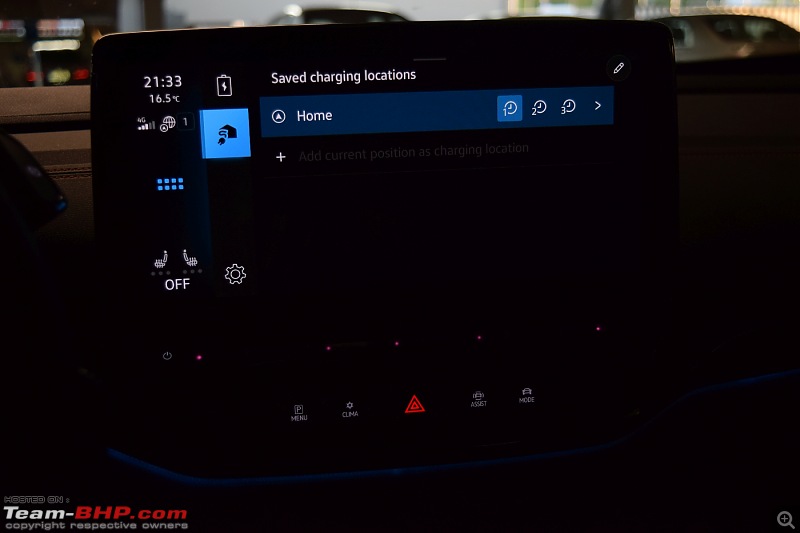 This screen shows the actual departure time setting. Multiple settings are possible, for eg:, for weekdays and weekends. Only one is enabled in this example. 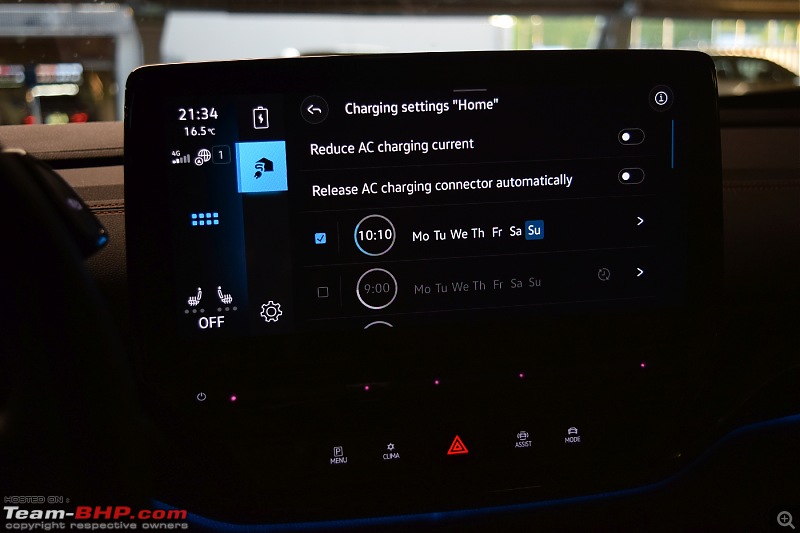 The main charging screen now shows the Departure setting. The slider can be used to set the charge limit, default is charging 80%. Just below the slider, we can see "Charge now to 50%". This option can be switched off or configured to a value between 20-50%. In this example, the car will initiate charging to 50% as soon as we plug it in. At the bottom, I have selected "Charge/air condition for departure". The rest of the charging from 50-80% will be managed by the car so that it will be charged to 80% and climate control will reach the required temperature by departure time. Other options are to "Charge Now" or "Charge for departure". 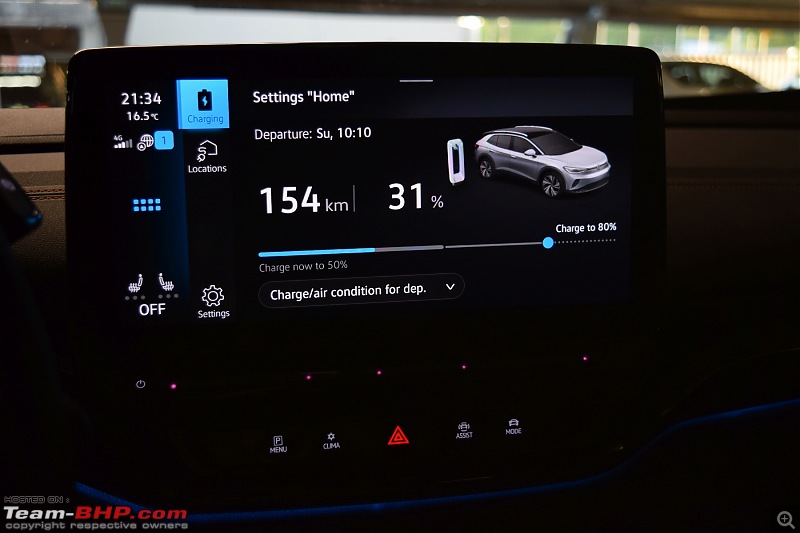 When charging session is on-going, the display shows the charging speed, range added and estimated end time. 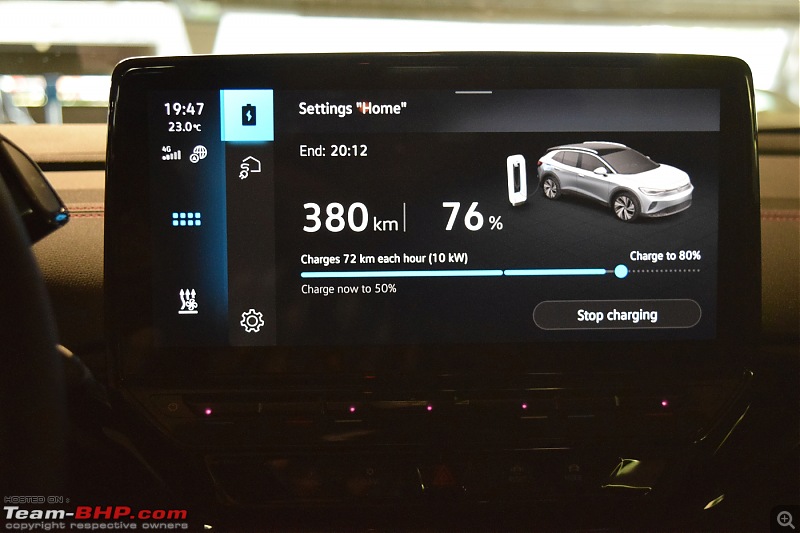 Other options in the Charging menu: 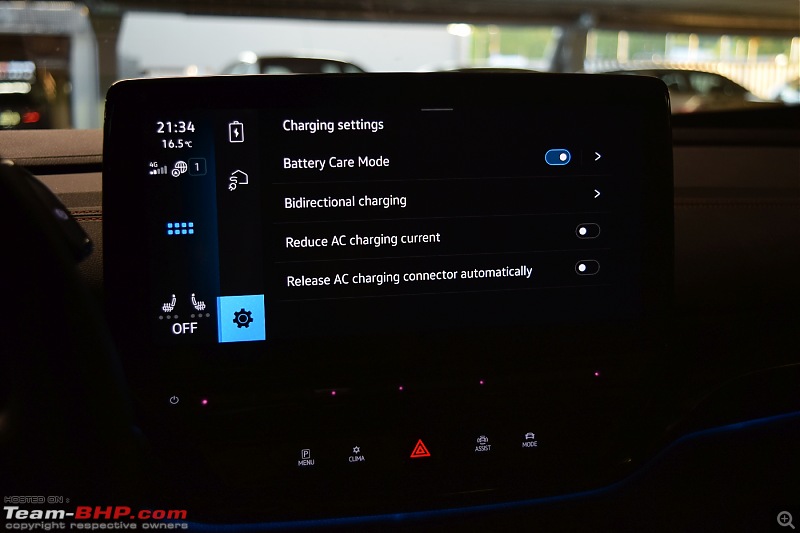 In battery care mode, the charge limit will be reset to 80% for the next charging session. For eg: when we plug in at home or a destination AC charger after a trip during which we may have charged to more than 80%. Bi-directional charging is possible from vehicle to grid. We cannot charge other EVs like in Ioniq 5/EV6. Plug-and-charge is supported. This needs a charging contract with VW (We Charge) or a third-party provider who can provide this service. As of now, I don't have any charging contracts. In Finland, two large retail groups have ventured into providing charging infrastructure as well. I already had customer IDs with both, and the same can now be used for charging without needing any specific contracts with monthly charges. I'm not sure either of them supports plug-and-charge at this time. One of them is also the authorized dealer for most VAG cars. So I guess at some point, they may start supporting plug-and-charge for VWs. Efficiency: The WLTP range of the GTX is claimed to be 495km. The combined consumption is claimed to be 17.8 kWh/100km. They don't directly correspond to each other - we cannot get 495km out of a 77kWh battery if the consumption is 17.8 kWh/100km. However, they are both derived from the data from the WLTP tests. So apparently, both are correct. When I got the car, it was still winter, and I used to see consumption figures higher than 21 kWh/100km. As I mentioned, I charge only once a week. So I didn't have the opportunity to charge and precondition the car by departure time on most trips. I believe this would've certainly made a difference to the consumption figures. Here is the consumption from the only highway trip that we had. Out of the 220km, about 150 was on roads with 80 km/h limit, 30 km on roads with 100 km/h limit, and the rest at 60 km/h or lower. Even in those parts with 80 km/h limit, there were many occasions where it was required to slow to 60 or 50 near junctions, and speed up afterwards. I would've got even better consumption if I hadn't taken the car off the Travel Assist and driven enthusiastically towards the end of the trip. The temperature was less than 10-degress Celcius during the trip. AC was on all the time with the car in Comfort mode. 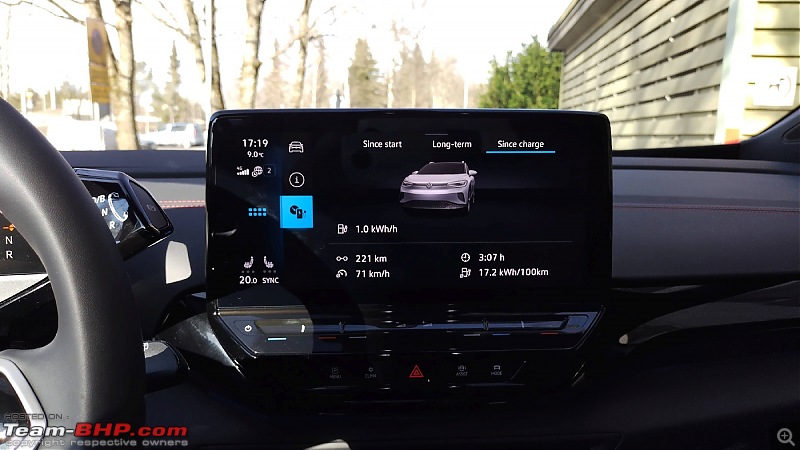 With the temperatures rising to about 20-degrees Celcius, I usually get 16 kWh/100km or lower consumption for my daily usage. I have seen values as low as 13.1 kWh/100km. I think I probably still need to learn to drive the car efficiently in stop-start traffic. I base this on the consumption figures I get when I go to Helsinki city centre during peak times. I regularly find that I get better consumption travelling till the city limits. Once I enter the city, the average consumption for the trip goes up. It doesn't matter if I am using D or B mode. Or perhaps the GTX is more efficient travelling at constant speeds than in stop-start scenario. I have noticed during coasting in D mode that the GTX doesn't drop speed that easily on level ground and gains quite some speed when going downhill. I haven't noticed much efficiency gain in Eco mode. However, I need to check this again. As I mentioned earlier, after the ignition is switched off and on, the Drive setting in the Eco driving profile is reset to Comfort. Perhaps, this had some influence on the results I got. The climate control does feel weaker in Eco mode. Software Experience: Software has been one of the pain points for the ID cars. This was probably true earlier, and perhaps still is today for the initial batches of ID cars which have not been updated to the latest version. My car was delivered with ID software version 3.2. This version seems to be pretty stable. It is definitely not as slick as Tesla's. The screen responds quite fast. However, in certain situations, the software is a bit slow. It is not uncommon to see this screen: 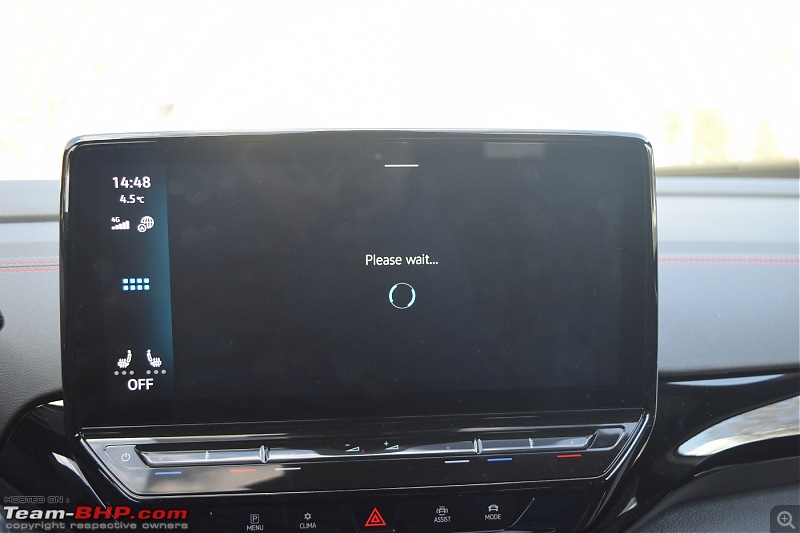 However, this seems to occur only when accessing a menu for the first time. Also, for eg:, the navigation takes a bit of time to initialize after the ignition is turned on. The navigation can add fast charging stops to route navigation. However, as far as I know, it still does not take into account the elevation data for the route. I think the software is now at a level where it can be described as largely competent. However, the expectations still need to be kept a bit low, certainly lower than Tesla levels. In terms of software updates, I have received one update on the day the car was delivered and some minor navigation updates over the air. Through OTA most, if not all, control systems can be updated in the car. VW has had trouble getting this to work, with several cars running into trouble or needing to go to the service station to get updated. VW had indicated that they would release an update every 3 months or so. But they have so far failed to keep the promise. Since my car has been delivered with the latest SW version, I don't have any experience with OTA software updates yet. According to my dealer, I should expect a software update by the end of the year. Let's see if that happens. I believe the HW and SW architectures of MEB cars have now been updated, starting with the ID.7. So I wonder how many feature updates I will get in the future. My car may be HW-limited and unable to receive some software features due to that. Many EV buyers are also interested in as much data as possible about the efficiency, driving, consumption etc. This is where the software, or the interface, is particularly lacking. There is the standard "From Start", "From Charging" and "Long Term" trip data, but there is no trip history in the car. There are no charging statistics shown by the car. Do you want to know if only the rear motor is working or if the front motor is also engaged? Try to pick up the whine from the front motor. How about power consumption by the drive train or convenience customers? Well, hard luck! Want to know how going up or downhill affects consumption? No graphs are available for that. For trip data history and charging history, I have to use a third-party app like Tronity. So the data is available, but just not provided via any interface by VW. Data nerds will probably need to get an OBD dongle. App Experience: I think you can guess the app experience from the SW experience I mentioned above. The app is pretty basic. It shows the most important information (range, SOC) and allows control over basic functions (AC, charging). To start using the app, we need a Volkswagen id and also need to link our car (via the VIN) to the id. The last step is to connect the app and the car by scanning a QR code on the car. The app setup was completed in the showroom itself before I drove out. The interface is quite simple and uncluttered. AC can be started from the front page itself. The picture in the app shows a white GTX, just like mine. 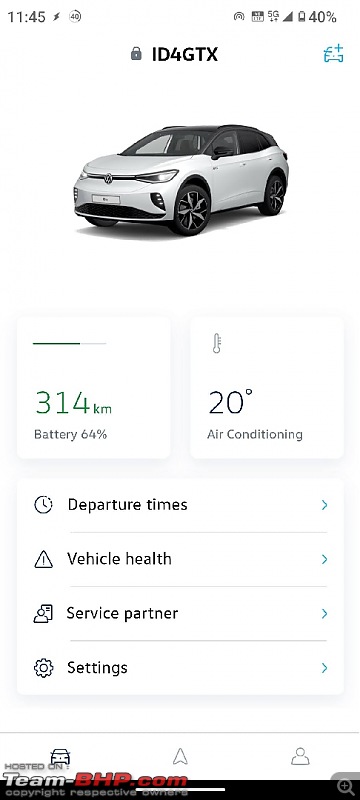 The Departure Times menu allows to set departure times for the static air conditioning or charging. The departure time setting for charging also includes the option to enable AC. 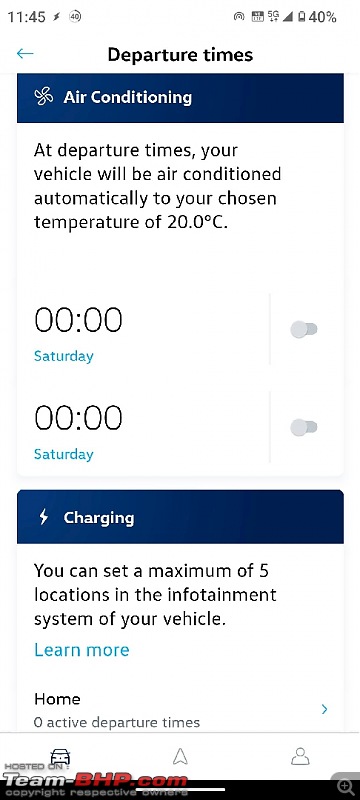 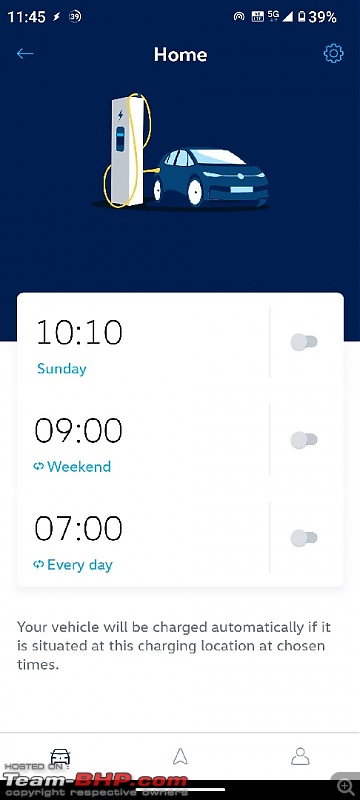 Charging settings can also be changed from the app. 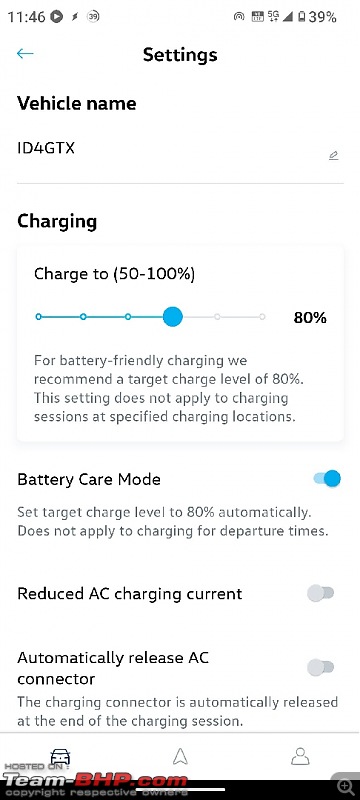  Vehicle health report gives some basic information about different systems on the car. 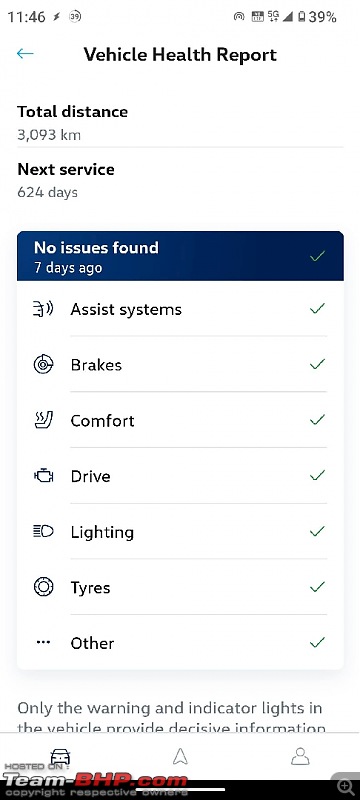 We can set some charging preferences when planning a route on the app. However, much more route preferences can be set while planning the route from the car itself. After planning the route on the app, it can be send it to the car. The car will recalculate/update the trip when the journey actually begins. 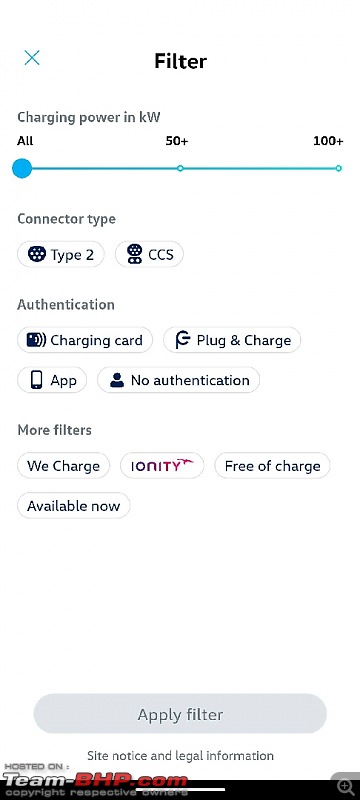 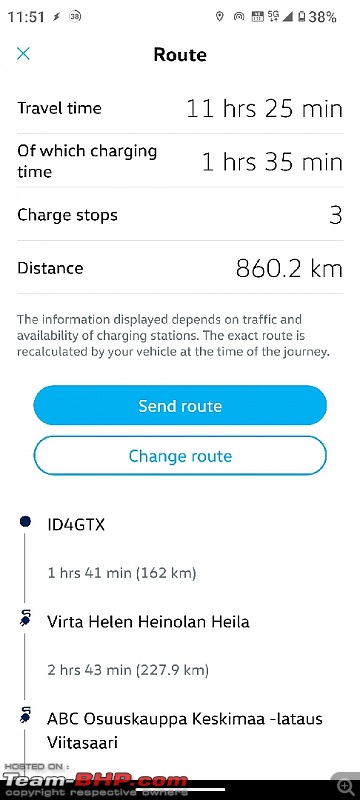 Likes: + Good-looking in a Volkswagen-ish way. I think it will still look good a few years down the line + Spacious enough for 5 adults and their luggage. The fifth passenger will be slightly less comfortable due to hard seat back and base in the middle. They should have no complaints about the space, though + Quite feature-loaded + Low NVH, although not super-silent + Ride is comfortable with DCC. Handling is also predictable + Efficiency and range appear to correlate with the WLTP figures + 5-star EuroNCAP safety rating Dislikes: - Interior is not impressive for the price, and compared to the competition - Generous use of piano black, even in areas like the handrests makes it difficult to keep the interiors clean - Software doesn't provide enough data to satisfy keen EV users. It is required to have third party tools to access data that the car itself collects! - Software can be best described as functional and competent. It is not as slick or as feature-rich as some competitors - The boot is big, but for everyday use it is not as practical as the Karoq's boot. We certainly miss the proper hooks and usuable space behind the wheel wells which we had in the Karoq. - A frunk, even a small one to keep the charging cable would've been useful. I have to back into my charging spot to connect the car easily to the wallbox, and then it is impossible to open the boot to get the charging cable. I now keep the cable on the rear seat. If rear seats are occupied, I open the ski hatch to put the cable in the boot and get it out via the same route after the trip. So yes, there is a solution but I would've preferred a simpler solution. - Build quality issues. I had my first rattle from the left rear door barely too weeks after delivery. Like all good rattles, it went away before I could show it at the service centre anf get it fixed. I have no idea if or when it will show up again. Recently, I noticed a raised area near the HUD. It doesn't seem to be causing any rattles now, but I will get it checked out: 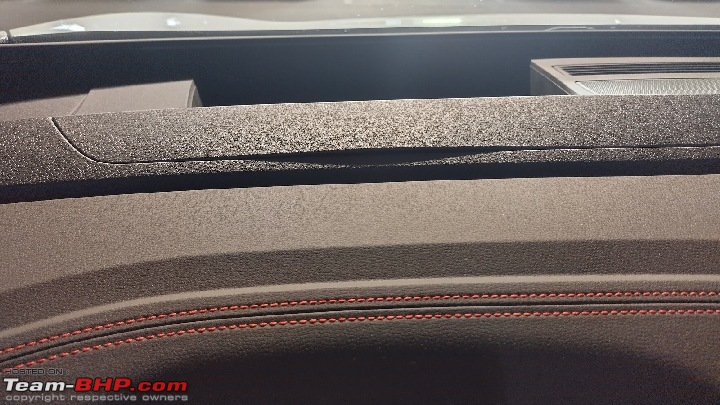 - The remote keys have low range. I'm someone who needs to press the lock button on the key a few times at various distances from the car after parking, and I need to see the indicators flashing to have peace of mind  One set of keys also seems to suffer some quality issue and it doesn't seem to work from the same distances as the other. Both don't have the range of the Karoq's keys. I'm not sure if it's an issue with the keys or the car doesn't want to respond after a couple of times. One set of keys also seems to suffer some quality issue and it doesn't seem to work from the same distances as the other. Both don't have the range of the Karoq's keys. I'm not sure if it's an issue with the keys or the car doesn't want to respond after a couple of times.Conclusion: I think VW has aimed too low with this car in terms of specs (power/torque, and especially charging) and software features. On the other hand, they aimed too high in terms of an all-touch minimalist interface, but without the software to match it. The interior quality seems to be a result of trying to keep costs in check. In terms of OTA, aiming to be able to update all systems via OTA is commendable and will work in their favour in the long-term. However, the implementation so far has not matched up to the ambition. I had read about OTA update for software version 3.2 starting for older cars in January or February this year. I can still read in some forums about owners getting the update now, 6 months later. This is a first-gen ground-up EV by VW, and it shows! However, if you are looking for a comfortable EV that is good to drive and has reasonably long range, the GTX fits the bill. Thank you for your patience! 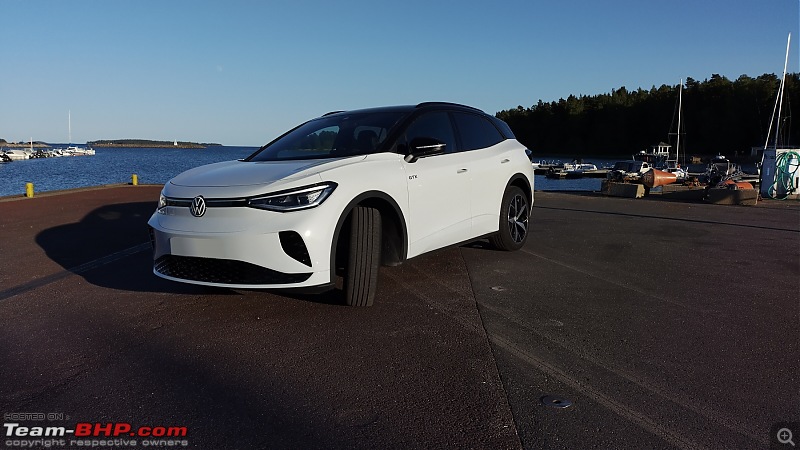 Last edited by StarrySky : 25th June 2023 at 12:35. |
| |  (32)
Thanks (32)
Thanks
|
| The following 32 BHPians Thank StarrySky for this useful post: | 14000rpm, abaliga, anivy, Arun_S, Ashutosh_kumar, AYP, Batfreak, carthick1000, Chrome6Boy, dailydriver, dileepcm, Dr.AD, Gannu_1, GTO, Keynote, klgiridhar, MotorDev, NG_EV, Omkar, s4ch, sainyamk95, Samfromindia, sanjayrozario, speedmiester, SRISRI_90, stringbh, sukiwa, Tgo, thallipolivandi, TorqueKnight, Vaishak, vb-saan |
| | #11 |
| Team-BHP Support  | Re: Volkswagen ID.4 GTX Business | Ownership Report Thread moved out from the Assembly Line. Thanks for sharing! |
| |  (2)
Thanks (2)
Thanks
|
| The following 2 BHPians Thank Aditya for this useful post: | GTO, StarrySky |
| |
| | #12 | |
| BHPian Join Date: Oct 2008 Location: bangalore
Posts: 80
Thanked: 306 Times
| Re: Living With The GTX Quote:
As an automotive engineer working with EVs this is interesting to me as this normally shouldn't be the case. Can you confirm the source of these peak power limitation criteria (30s is understandable but 88% is quite specific) ? Were you able to check this yourself or was it in the owner's manual or something like that? | |
| |  (1)
Thanks (1)
Thanks
|
| The following BHPian Thanks iamgyan for this useful post: | StarrySky |
| | #13 |
| Team-BHP Support  | Re: Volkswagen ID.4 GTX Business | Ownership Report Exceptional, unbiased & detailed ownership reviews of cars have started going to our homepage reviews box. It's the ultimate stamp of trust from Team-BHP (as a platform) because lakhs of visitors every month check out reviews from there & make purchase decisions. Your review has also been included here. Thank you so much for sharing  . . |
| |  (2)
Thanks (2)
Thanks
|
| The following 2 BHPians Thank Aditya for this useful post: | dailydriver, TorqueKnight |
| | #14 |
| BHPian Join Date: May 2023 Location: Mangalore
Posts: 258
Thanked: 859 Times
| Re: Volkswagen ID.4 GTX Business | Ownership Report Congratulations on the purchase! Nice review, gives us a perspective on what is to be expected out of owning a VAG EV, I wish VW had not watered down on the interior quality, this issue persists on their latest ICE offerings as well, have seen some examples of this on mark 4 Octavia that we purchased 3 months ago, that solid build from previous gen VAG cars is missing if you observe carefully. Only two switches to operate power windows on the driver panel is a step in the wrong direction too! Looks like VW is getting inspired by Tesla on the quality front as well. |
| |  (1)
Thanks (1)
Thanks
|
| The following BHPian Thanks abaliga for this useful post: | StarrySky |
| | #15 | ||
| Senior - BHPian Join Date: Apr 2010 Location: EU - Nordic
Posts: 2,094
Thanked: 3,209 Times
| Re: Volkswagen ID.4 GTX Business | Ownership Report Quote:
Quote:
Thank you! | ||
| |  (1)
Thanks (1)
Thanks
|
| The following BHPian Thanks StarrySky for this useful post: | iamgyan |
 |


